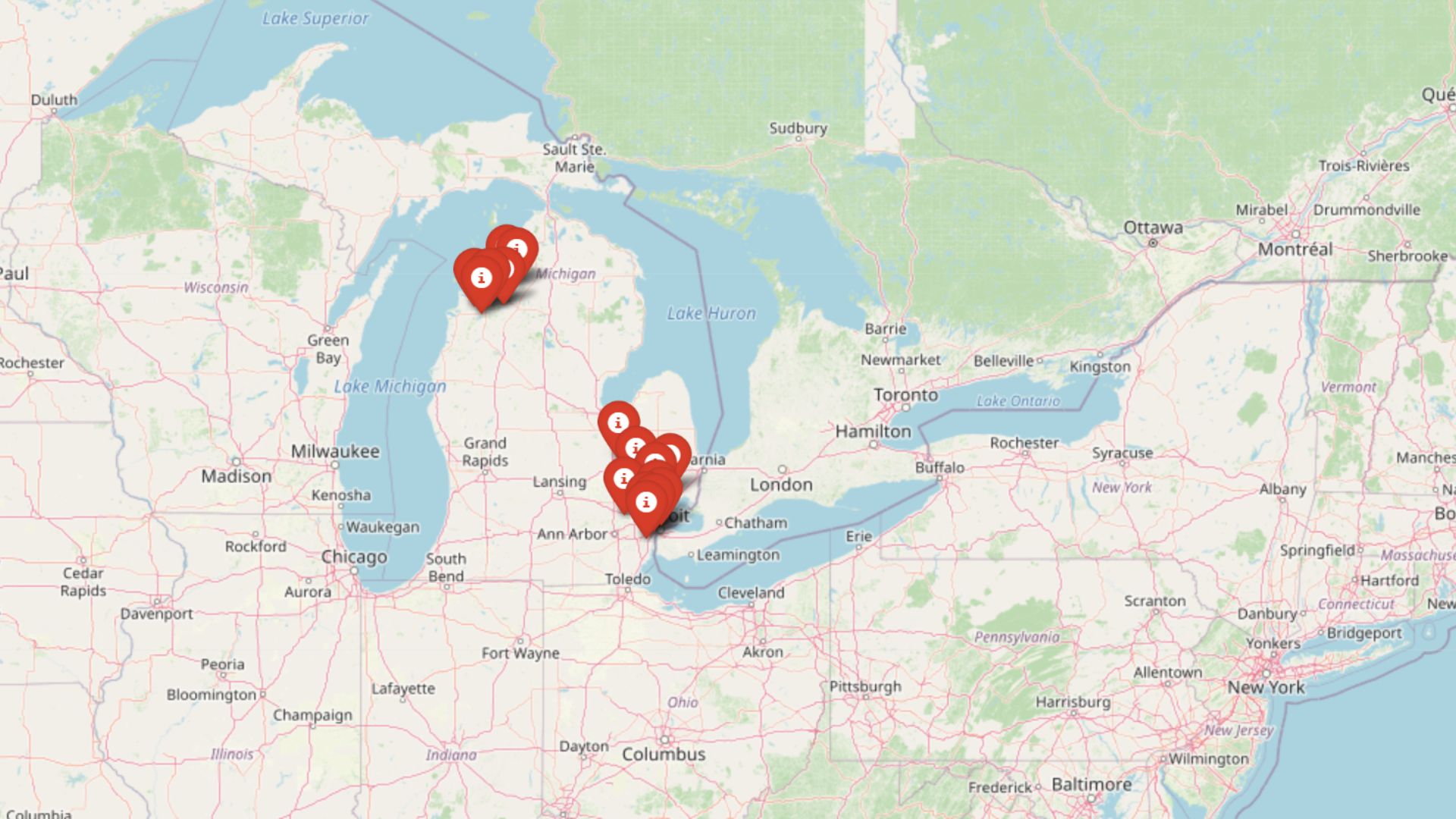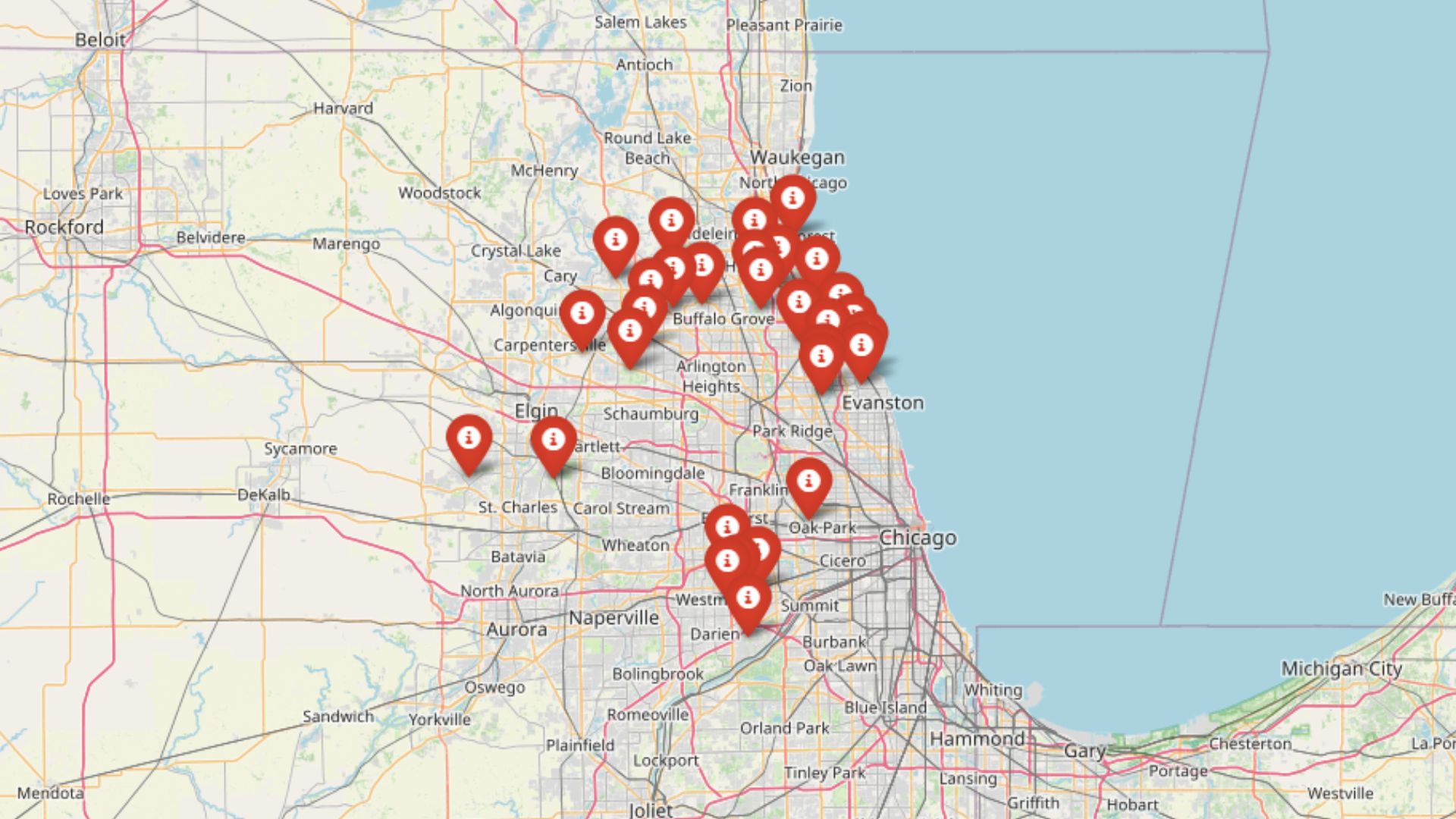
Using the latest Zillow Home Value Index data from 2025, we’ve ranked the 30 most expensive towns in Illinois based on current home prices. These communities represent the pinnacle of luxury living in the Prairie State, where premium locations meet exceptional amenities. Each town tells a story of sustained demand, architectural heritage, and strategic positioning within the Chicago metropolitan area.
From lakefront mansions to historic village estates, these rankings reveal where Illinois home values have climbed highest over the past 15 years. Whether you’re tracking investment opportunities, exploring relocation options, or simply curious about luxury real estate trends, this comprehensive breakdown shows exactly where the state’s most valuable properties are located and why they command such premium prices.
30. Clarendon Hills – 49% Home Price Increase Since 2010

- 2010: $435,878
- 2011: $408,249
- 2012: $384,331
- 2013: $412,511
- 2014: $446,387
- 2015: $459,664
- 2016: $457,545
- 2017: $469,081
- 2018: $482,820
- 2019: $470,960
- 2020: $463,652
- 2021: $511,214
- 2022: $557,156
- 2023: $563,722
- 2024: $612,158
- 2025: $647,657
Clarendon Hills has demonstrated steady recovery from early 2010s lows, with particularly strong momentum since 2020. The town weathered market fluctuations between 2011-2020 before experiencing dramatic acceleration in recent years. Current median prices at $647,657 reflect renewed confidence in this DuPage County community’s long-term prospects.
Why Clarendon Hills?

Why are people willing to pay so much to live here? What’s special about it?
Clarendon Hills attracts families seeking small-town character within easy reach of Chicago’s business districts. The village maintains its historic charm through carefully preserved downtown architecture and tree-lined residential streets. Residents value the strong sense of community, excellent local schools, and convenient Metra rail connections that make downtown commutes manageable.
The town’s compact size creates intimacy while offering modern amenities like updated parks and recreational facilities. Many homes feature classic Prairie and Colonial Revival architecture on mature lots with established landscaping. This combination of accessibility, character, and quality infrastructure supports consistent property values despite broader market volatility.
How Clarendon Hills Rose to Prominence
Clarendon Hills emerged as a railroad suburb in the 1870s when the Chicago, Burlington and Quincy Railroad established a station in the area. Early residents were drawn by the promise of country living with city access, a theme that continues today. The community was officially incorporated in 1924, during the height of suburban expansion westward from Chicago.
The town’s development accelerated after World War II as returning veterans sought suburban homes supported by GI Bill benefits. Clarendon Hills maintained its residential character by limiting commercial development and preserving green spaces. The arrival of major corporations in the broader DuPage County area during the 1960s and 1970s solidified its position as a desirable suburban enclave for white-collar professionals.
3 Interesting Tidbits
1. Historic Preservation – The village actively maintains several buildings from its railroad era, including the original 1924 village hall that still serves government functions today.
2. Park Excellence – Clarendon Hills operates seven parks within just 1.8 square miles, providing residents with abundant recreational opportunities despite the compact geography.
3. Rail Legacy – The BNSF Railway line that sparked the town’s founding continues to provide direct service to Chicago’s Union Station, maintaining the original transportation advantage that made settlement attractive 150 years ago.
29. Glenview – 43% Home Price Increase Since 2010
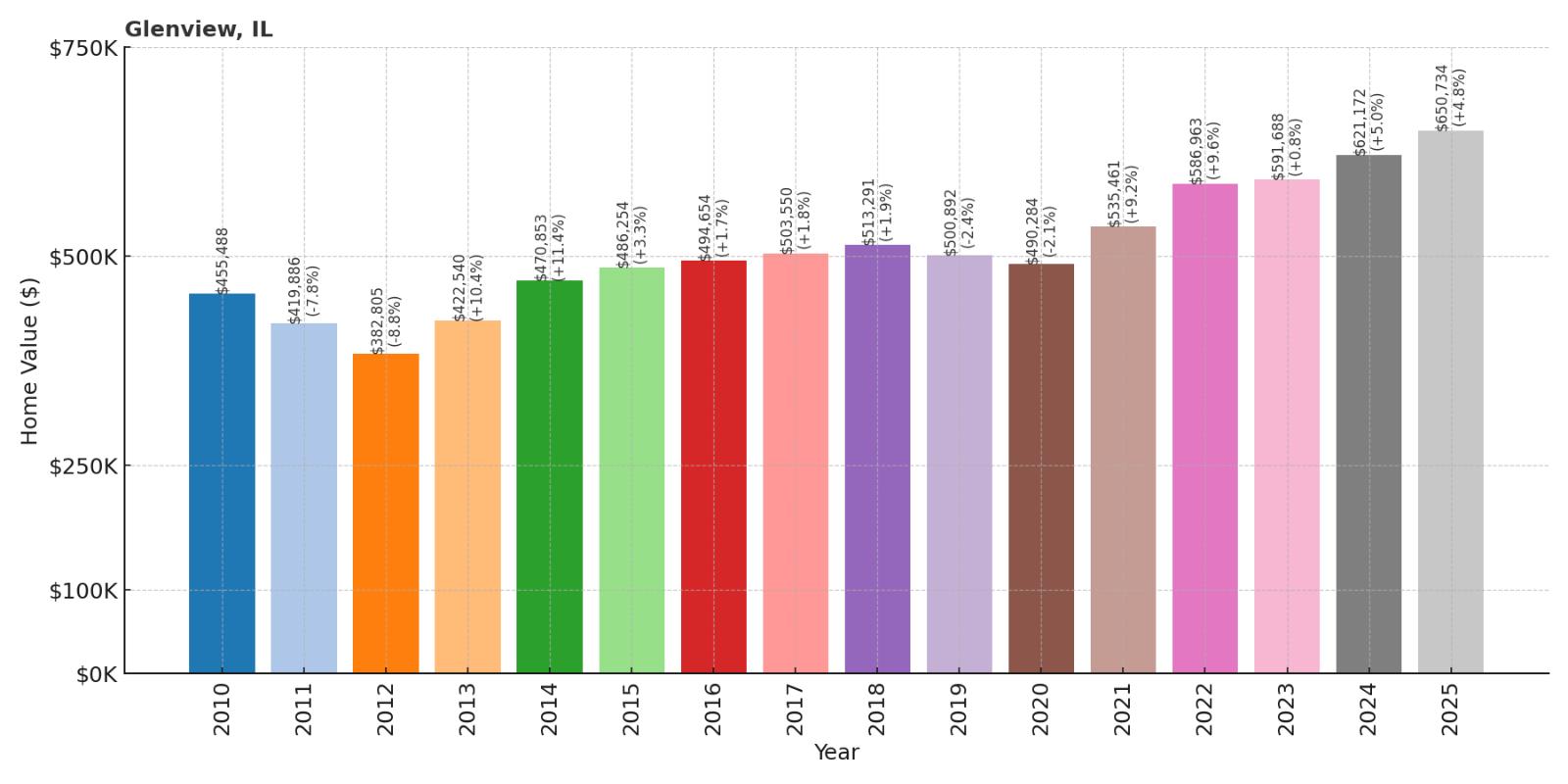
- 2010: $455,488
- 2011: $419,886
- 2012: $382,805
- 2013: $422,540
- 2014: $470,853
- 2015: $486,254
- 2016: $494,654
- 2017: $503,550
- 2018: $513,291
- 2019: $500,892
- 2020: $490,284
- 2021: $535,461
- 2022: $586,963
- 2023: $591,688
- 2024: $621,172
- 2025: $650,734
Glenview’s market trajectory mirrors regional patterns with notable dips in 2011-2012 followed by steady rebuilding through 2018. The community experienced another softening around 2019-2020 before surging 33% in the past four years. Today’s median price of $650,734 represents solid appreciation despite periodic market adjustments.
Why Glenview?
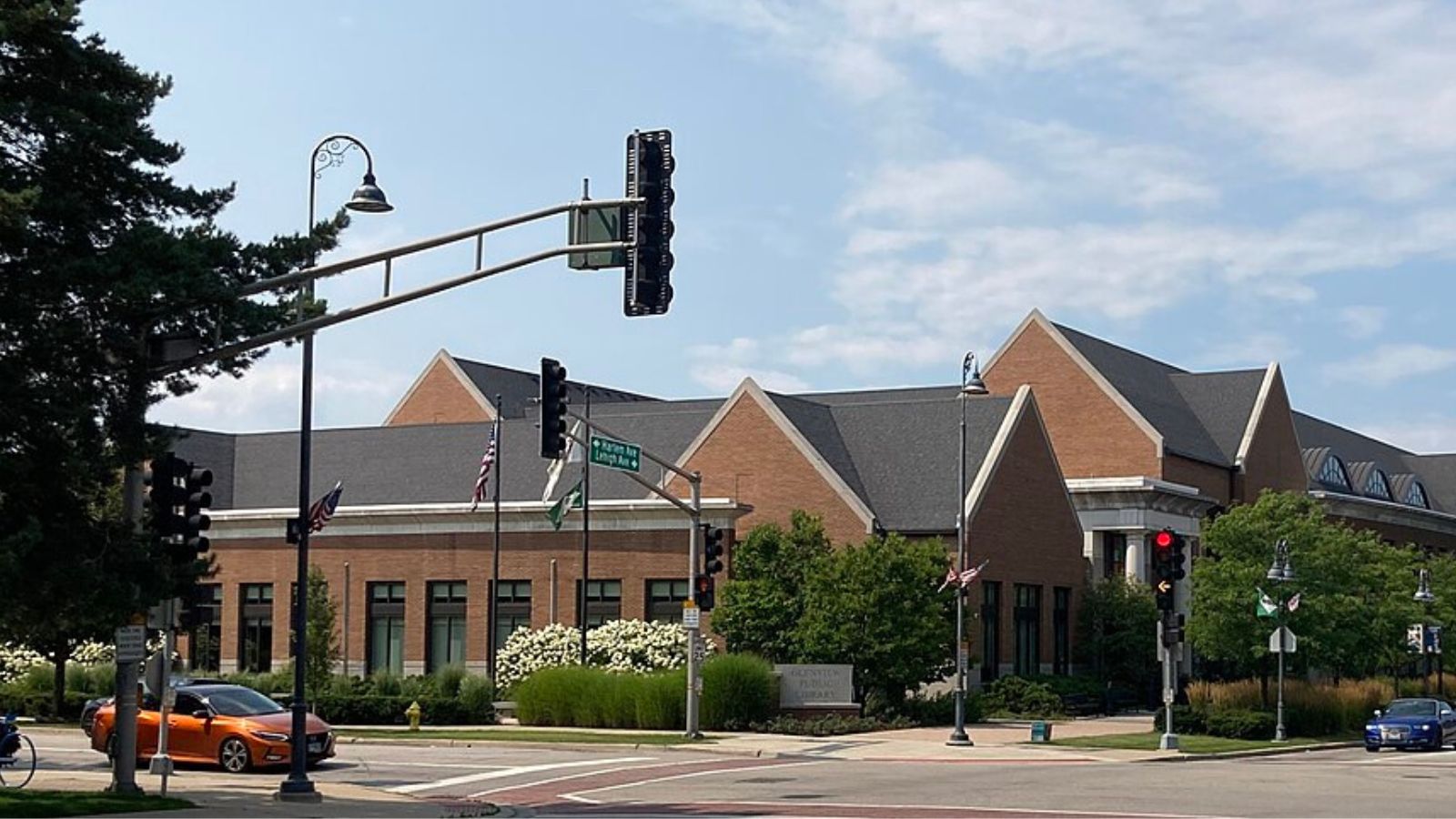
Why are people willing to pay so much to live here? What’s special about it?
Glenview offers an exceptional balance of suburban amenities and urban accessibility that appeals to diverse households. Families are drawn to the highly-rated Glenbrook schools and abundant park space, while professionals appreciate multiple transportation options including Metra service and proximity to major highways. The town successfully combines residential neighborhoods with thriving commercial districts.
The community’s size provides big-town amenities while maintaining manageable scale and civic engagement. Residents enjoy access to The Glen shopping center, numerous recreational facilities, and well-maintained infrastructure. Housing stock ranges from modest starter homes to luxury estates, creating economic diversity while supporting strong overall property values.
How Glenview Rose to Prominence
Glenview’s origins trace to 1851 when German immigrant Robert Kennicott established a farm in the area. The community grew slowly until the Chicago and Milwaukee Railroad arrived in 1872, transforming it into a commuter suburb. Early residents were primarily Chicago businessmen seeking country estates with convenient rail access to the city.
The town incorporated in 1899 and experienced steady growth through the early 20th century. Post-World War II suburban expansion brought significant residential development, while the establishment of Glenview Naval Air Station (now closed) added economic stability. Modern Glenview emerged as the former naval base was redeveloped into mixed-use neighborhoods, creating one of the most successful military-to-civilian land conversions in the region.
3 Interesting Tidbits
1. Aviation Heritage – Glenview Naval Air Station operated from 1937-1995, and the current master-planned community “The Glen” incorporates aviation-themed street names and design elements honoring this military legacy.
2. Prairie Preservation – The village maintains several prairie restoration sites that showcase native Illinois ecosystems, reflecting environmental stewardship values important to many residents.
3. Corporate Neighbors – Glenview’s location attracts major corporate headquarters, including Kraft Heinz and Anixter, providing high-paying jobs that support local property values.
28. Campton Hills – 62% Home Price Increase Since 2010
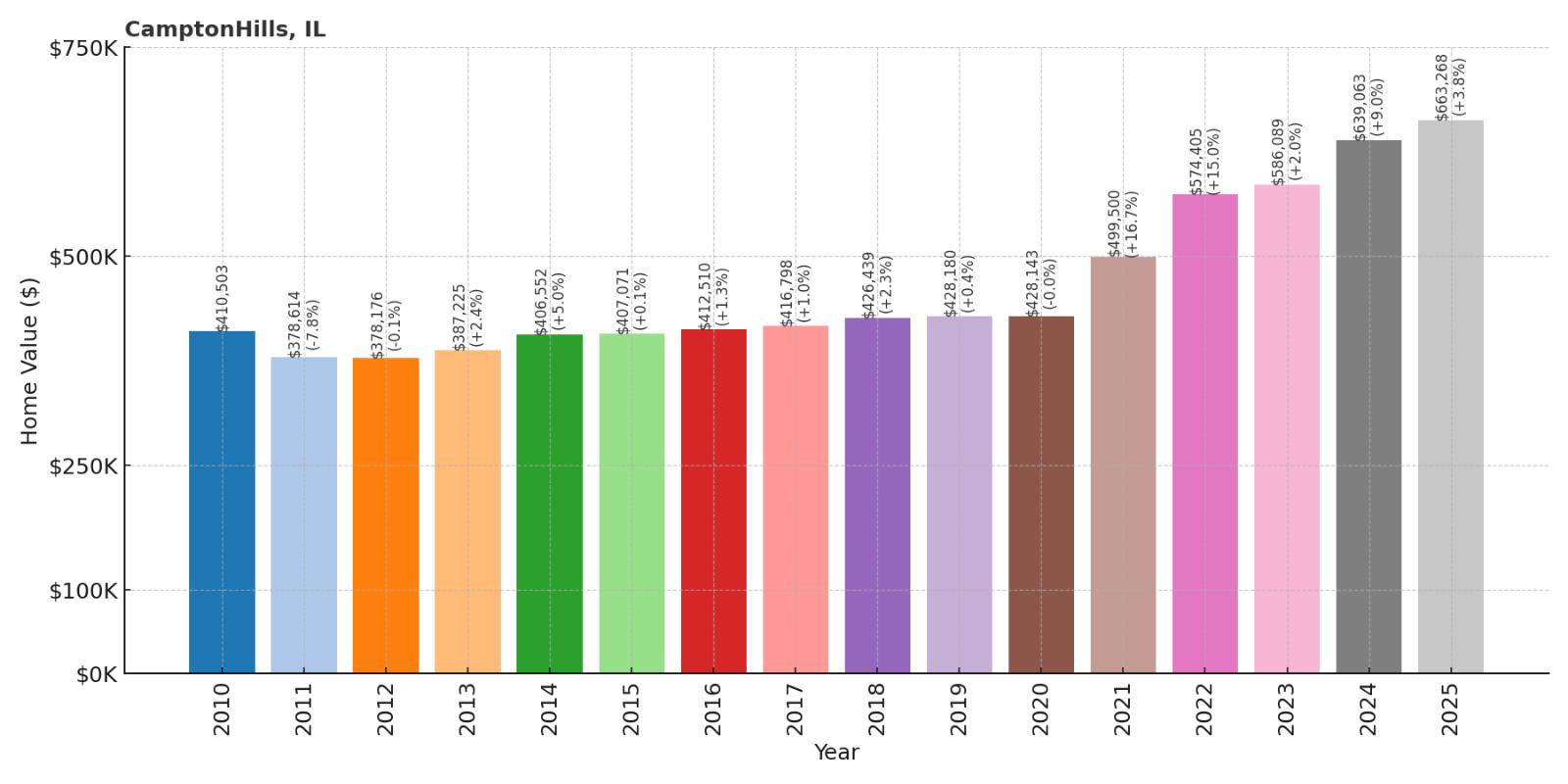
- 2010: $410,503
- 2011: $378,614
- 2012: $378,176
- 2013: $387,225
- 2014: $406,552
- 2015: $407,071
- 2016: $412,510
- 2017: $416,798
- 2018: $426,439
- 2019: $428,180
- 2020: $428,143
- 2021: $499,500
- 2022: $574,405
- 2023: $586,089
- 2024: $639,063
- 2025: $663,268
Campton Hills shows remarkable recent appreciation after years of modest growth from 2010-2020. The community remained surprisingly stable during market downturns but has surged 55% since 2020. Current values at $663,268 reflect strong pandemic-era demand for spacious suburban properties with rural character.
Why Campton Hills?
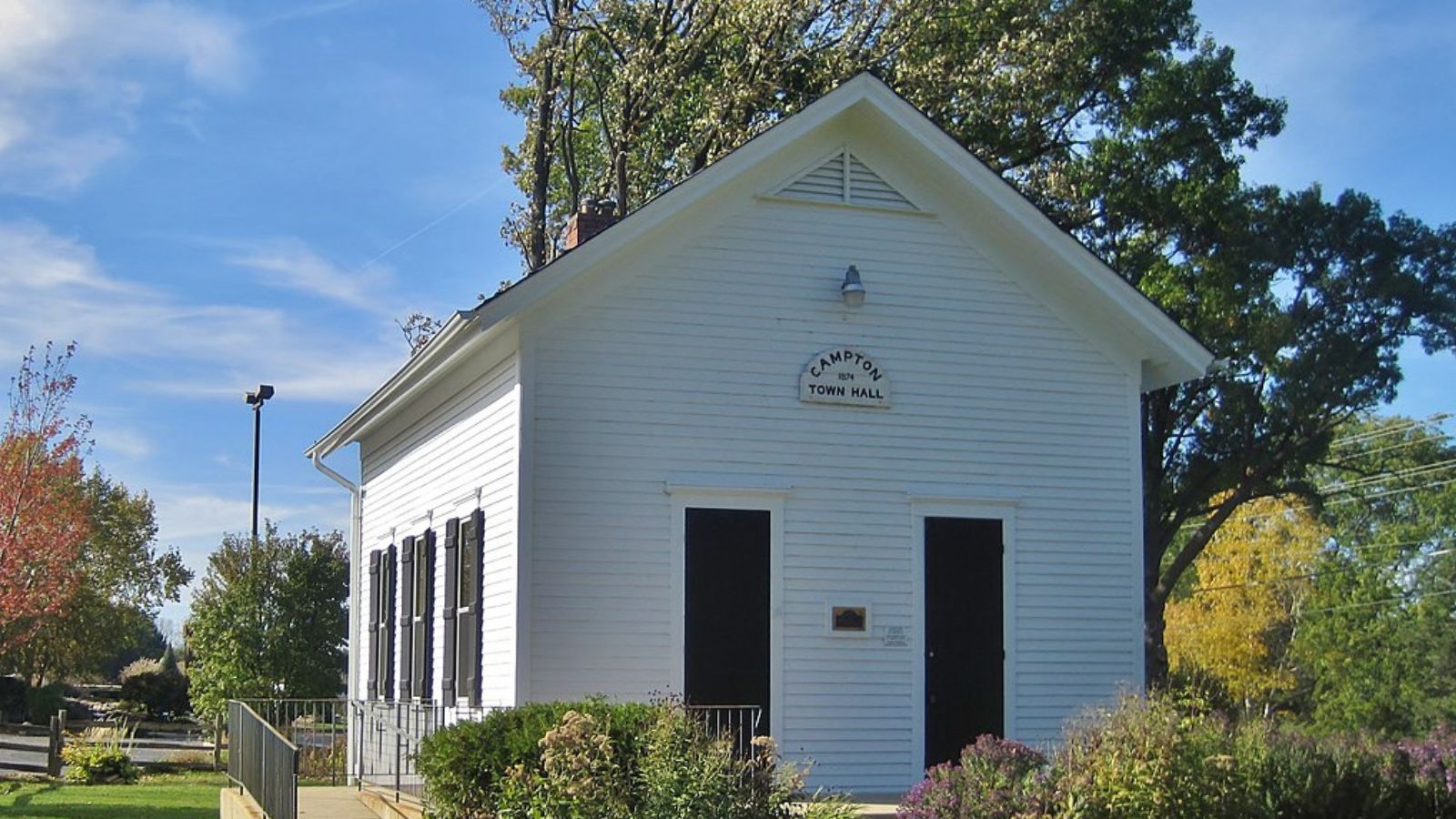
Why are people willing to pay so much to live here? What’s special about it?
Campton Hills attracts buyers seeking luxury homes on large lots with semi-rural ambiance while maintaining Chicago area access. The village offers estate-sized properties with privacy, mature trees, and often custom architecture that appeals to affluent families. Residents value the peaceful environment, excellent schools, and strong property maintenance standards that preserve neighborhood character.
The community’s zoning protects open space and prevents overdevelopment, ensuring continued exclusivity and environmental quality. Many properties feature equestrian facilities, extensive landscaping, and custom-built homes that cater to discerning buyers. This careful development approach supports premium pricing and attracts households prioritizing space, privacy, and natural beauty.
How Campton Hills Rose to Prominence
Campton Hills began as agricultural land in Kane County, settled primarily by farmers in the mid-1800s. The area remained largely rural until suburban expansion reached westward from Chicago in the late 20th century. Incorporation as a village in 2007 formalized community governance and development standards that attracted upscale residential projects.
The village’s proximity to major employment centers in Schaumburg, Hoffman Estates, and the Northwest suburbs made it attractive for executive-level housing. Developers capitalized on available land, natural beauty, and transportation access to create luxury subdivisions. Modern Campton Hills represents successful transition from agricultural land to premium suburban community while preserving rural character through careful planning.
3 Interesting Tidbits
1. Newest Village – Campton Hills incorporated in 2007, making it one of Illinois’ newest municipalities, formed specifically to maintain development control and rural character.
2. Horse Country – Many properties include horse facilities and riding trails, reflecting the area’s agricultural heritage and appeal to equestrian enthusiasts.
3. Conservation Focus – The village requires large minimum lot sizes and maintains extensive open space requirements that preserve natural areas and wildlife habitat.
27. Northbrook – 46% Home Price Increase Since 2010
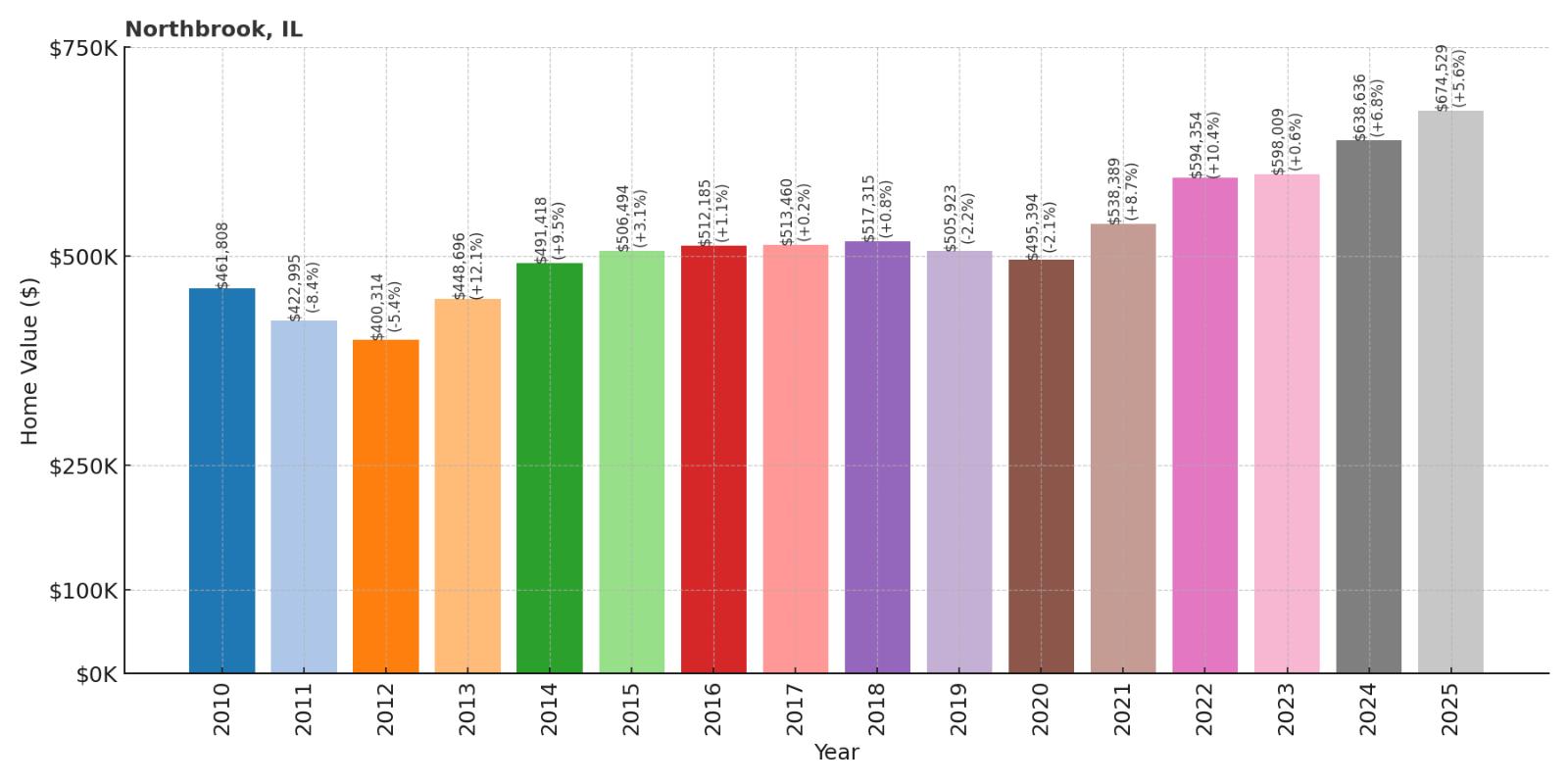
- 2010: $461,808
- 2011: $422,995
- 2012: $400,314
- 2013: $448,696
- 2014: $491,418
- 2015: $506,494
- 2016: $512,185
- 2017: $513,460
- 2018: $517,315
- 2019: $505,923
- 2020: $495,394
- 2021: $538,389
- 2022: $594,354
- 2023: $598,009
- 2024: $638,636
- 2025: $674,529
Northbrook recovered steadily from 2012 lows, showing consistent growth through 2018 before experiencing typical pre-pandemic softening. Strong appreciation since 2020 has pushed median values to $674,529, demonstrating continued appeal of this established North Shore community. The 36% gain over the past four years reflects robust demand for quality suburban living.
Why Northbrook?
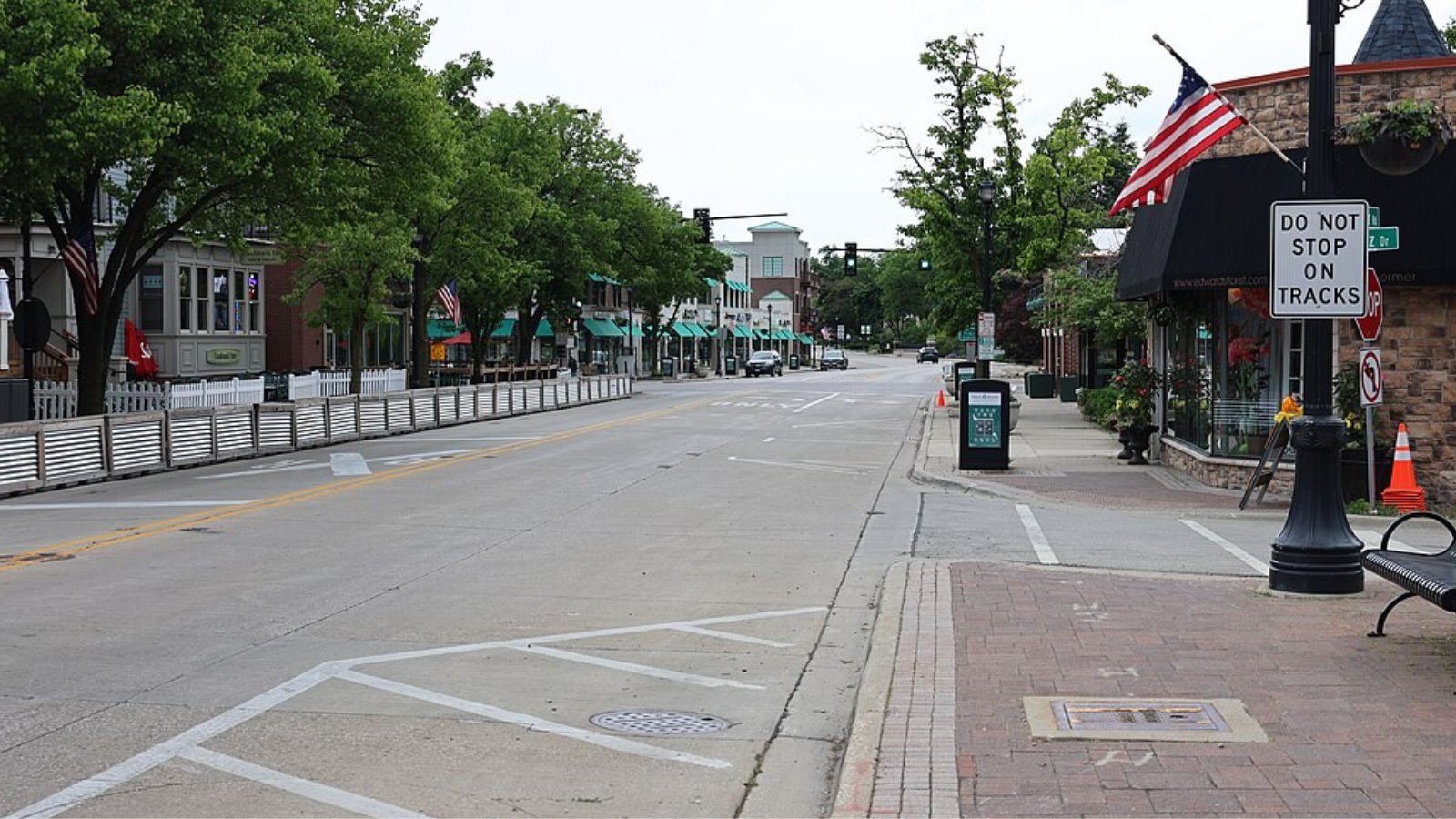
Why are people willing to pay so much to live here? What’s special about it?
Northbrook combines North Shore prestige with family-friendly amenities that attract professionals and affluent families. The community offers excellent public schools, extensive park systems, and a vibrant downtown district with shopping and dining options. Residents appreciate the balance of suburban tranquility and urban sophistication, plus convenient access to both Chicago and Milwaukee.
The village’s mature neighborhoods feature diverse architectural styles on well-maintained properties with established landscaping. Northbrook’s location provides multiple transportation options while maintaining distinct community identity. Strong local government services, cultural amenities, and recreational facilities create quality of life that justifies premium housing costs.
How Northbrook Rose to Prominence
Northbrook originated as a farming community in the 1840s, initially settled by German immigrants attracted to fertile soil and proximity to Chicago markets. The arrival of the Milwaukee Road railroad in the 1870s transformed the area into a commuter suburb, though development remained modest until after World War II.
Post-war suburban expansion brought significant residential development as Chicago-area professionals sought larger homes with suburban amenities. The village incorporated in 1901 and grew steadily through strategic annexation and planned development. Northbrook’s modern character emerged through careful balance of residential growth, commercial development, and preservation of green spaces that maintain its appeal to affluent households.
3 Interesting Tidbits
1. Corporate Campus – Northbrook hosts major corporate facilities including Allstate Insurance headquarters, providing high-paying local employment that supports residential property values.
2. Cultural Hub – The village operates an active performing arts center and maintains extensive recreational programming that enhances community life beyond basic municipal services.
3. Green Initiative – Northbrook was among the first Chicago suburbs to implement comprehensive sustainability programs, including renewable energy initiatives and environmental preservation efforts.
26. River Forest – 52% Home Price Increase Since 2010
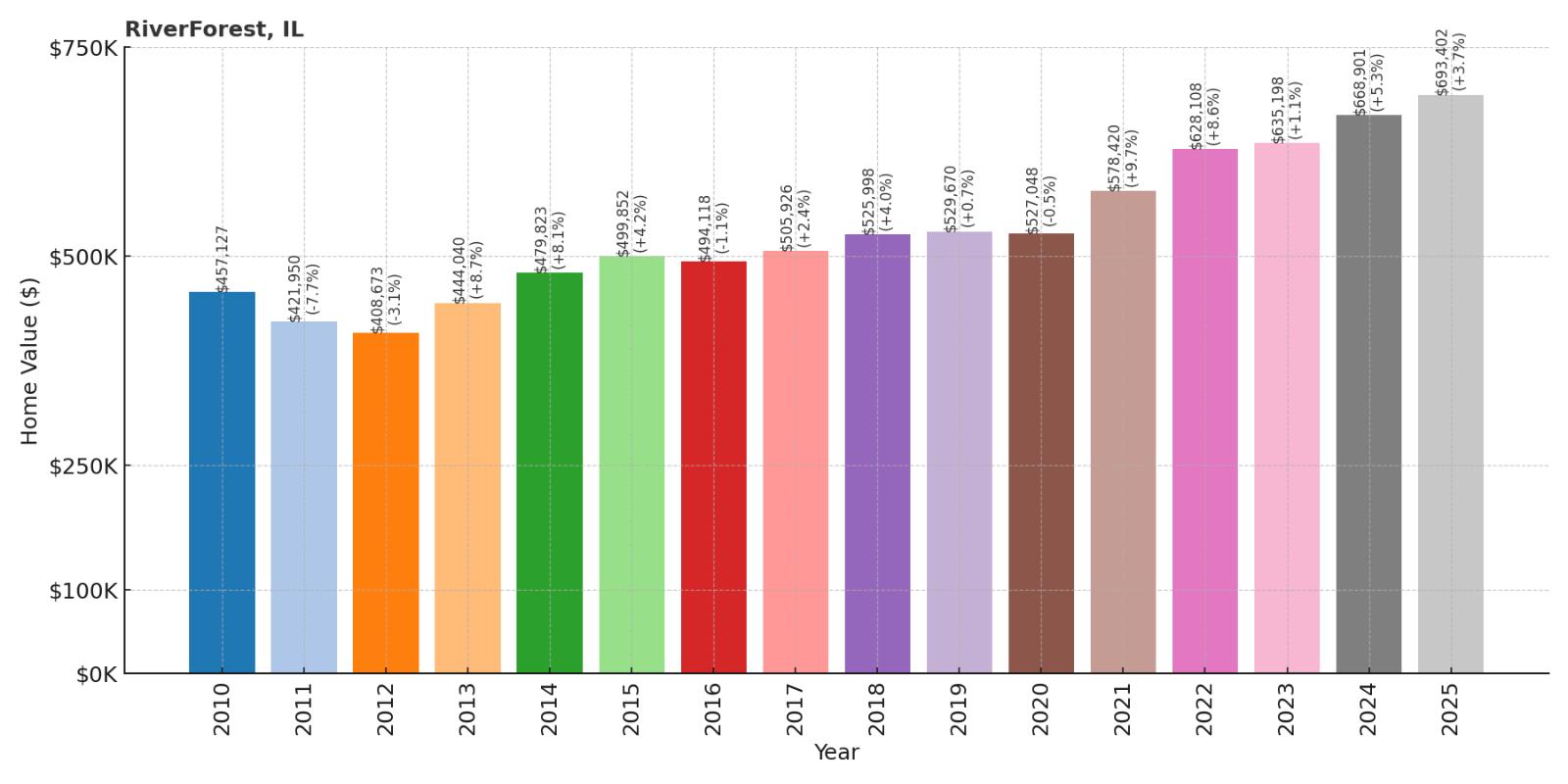
- 2010: $457,127
- 2011: $421,950
- 2012: $408,673
- 2013: $444,040
- 2014: $479,823
- 2015: $499,852
- 2016: $494,118
- 2017: $505,926
- 2018: $525,998
- 2019: $529,670
- 2020: $527,048
- 2021: $578,420
- 2022: $628,108
- 2023: $635,198
- 2024: $668,901
- 2025: $693,402
River Forest displayed steady appreciation through most periods, with notable strength from 2013-2019 and accelerated growth since 2020. The community avoided sharp downturns while maintaining consistent upward trajectory to current levels around $693,402. This performance reflects the stability and desirability of this historic western suburb.
Why River Forest?
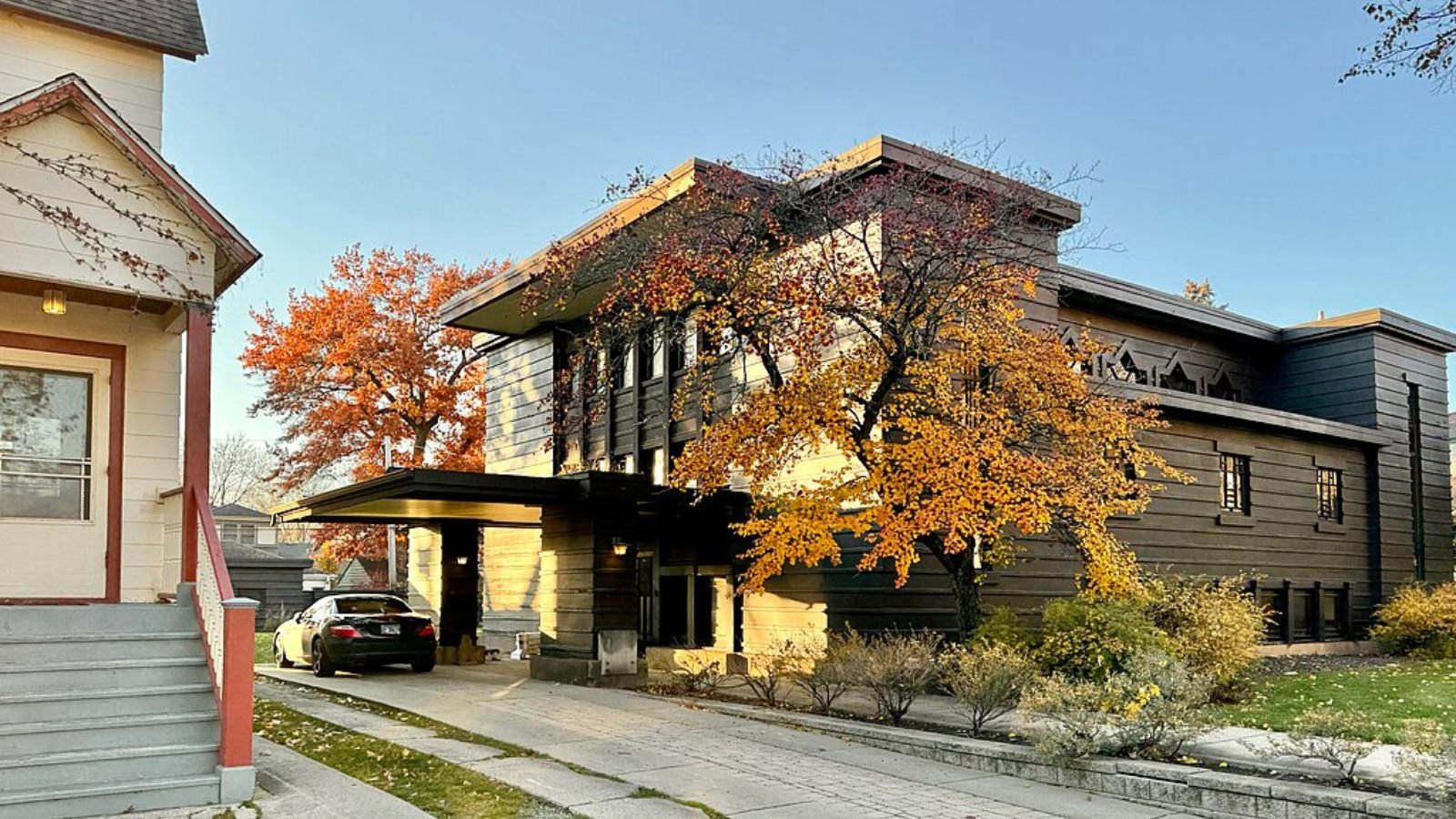
Why are people willing to pay so much to live here? What’s special about it?
River Forest attracts buyers seeking architectural significance in a walkable community with excellent transportation access. The village features numerous Frank Lloyd Wright-designed homes and other Prairie School architecture that creates unique character. Residents value the tree-lined streets, historic preservation efforts, and strong sense of community identity that distinguishes River Forest from typical suburbs.
The compact village layout encourages walking and cycling while providing convenient CTA and Metra service to downtown Chicago. Quality schools, well-maintained infrastructure, and active civic engagement create an environment that appeals to educated professionals and families. This combination of historic charm, modern amenities, and urban accessibility supports premium property values.
How River Forest Rose to Prominence
River Forest was platted in 1880 as a planned community designed to attract Chicago’s professional class seeking suburban living. Early development emphasized architectural quality and environmental preservation, establishing standards that continue today. The village incorporated in 1880 and quickly became known for innovative urban planning and architectural experimentation.
Frank Lloyd Wright’s residence and studio in nearby Oak Park influenced River Forest’s architectural character, attracting clients and fellow architects who built significant homes in the community. The arrival of elevated rail service in 1899 enhanced accessibility to Chicago, supporting continued growth through the early 20th century. River Forest maintained its exclusive character through careful zoning and historic preservation that protects its unique architectural heritage.
3 Interesting Tidbits
1. Wright Connection – River Forest contains several Frank Lloyd Wright-designed homes, including the iconic Winslow House (1893), his first major commission outside Oak Park.
2. Forest Preserve – The village name reflects its commitment to preserving mature oak forests, with many streets maintaining canopy cover that predates residential development.
3. Academic Town – Dominican University’s campus adds intellectual character while Concordia University Chicago provides additional educational amenities that enhance community culture.
25. Lincolnshire – 55% Home Price Increase Since 2010
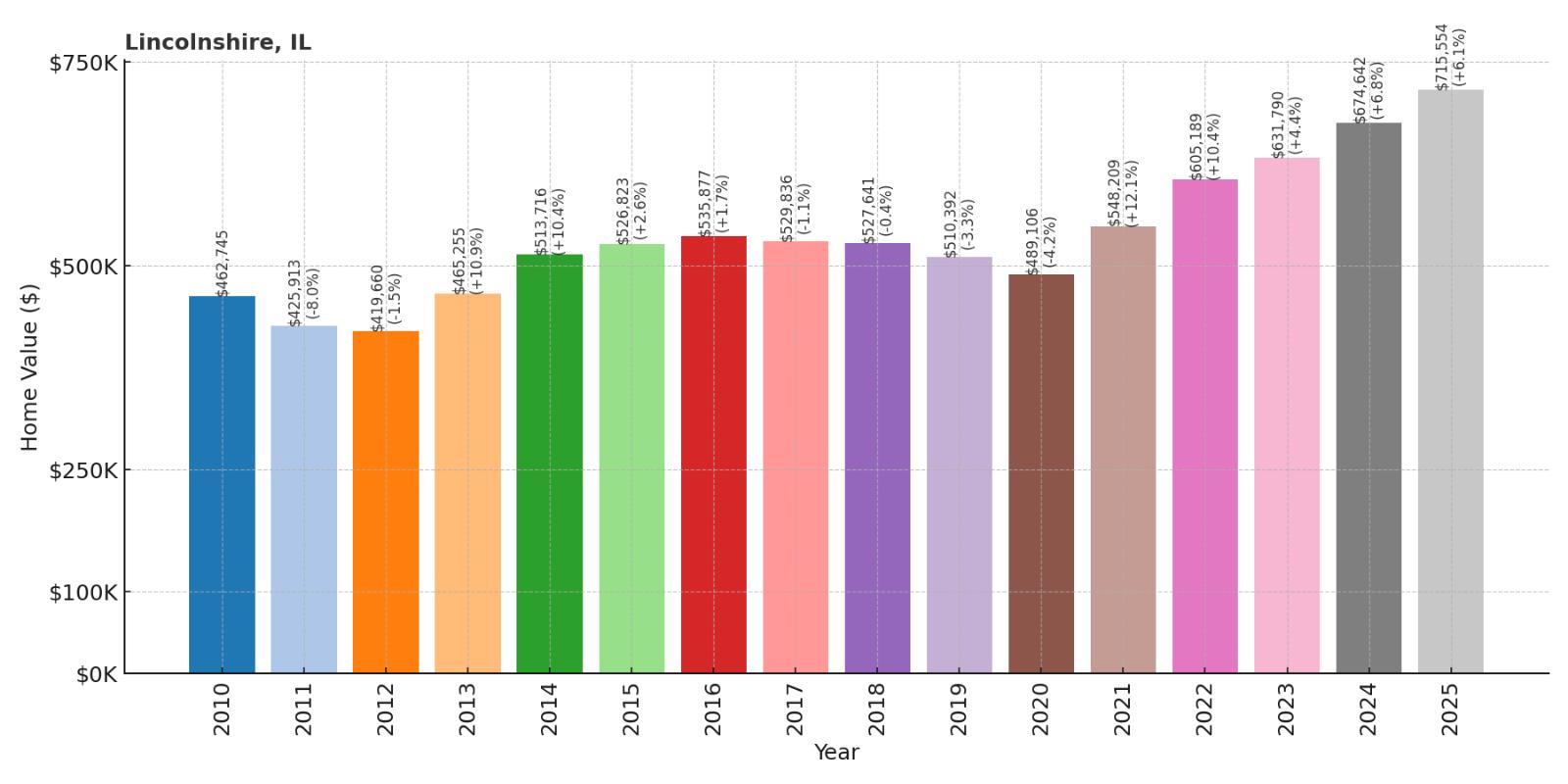
- 2010: $462,745
- 2011: $425,913
- 2012: $419,660
- 2013: $465,255
- 2014: $513,716
- 2015: $526,823
- 2016: $535,877
- 2017: $529,836
- 2018: $527,641
- 2019: $510,392
- 2020: $489,106
- 2021: $548,209
- 2022: $605,189
- 2023: $631,790
- 2024: $674,642
- 2025: $715,554
Lincolnshire recovered from early 2010s weakness to reach peak values around 2016, then experienced gradual decline through 2020. Recent appreciation has been dramatic, with 46% growth since pandemic lows bringing median prices to $715,554. This pattern reflects the community’s appeal to affluent households seeking suburban luxury with corporate accessibility.
Why Lincolnshire?
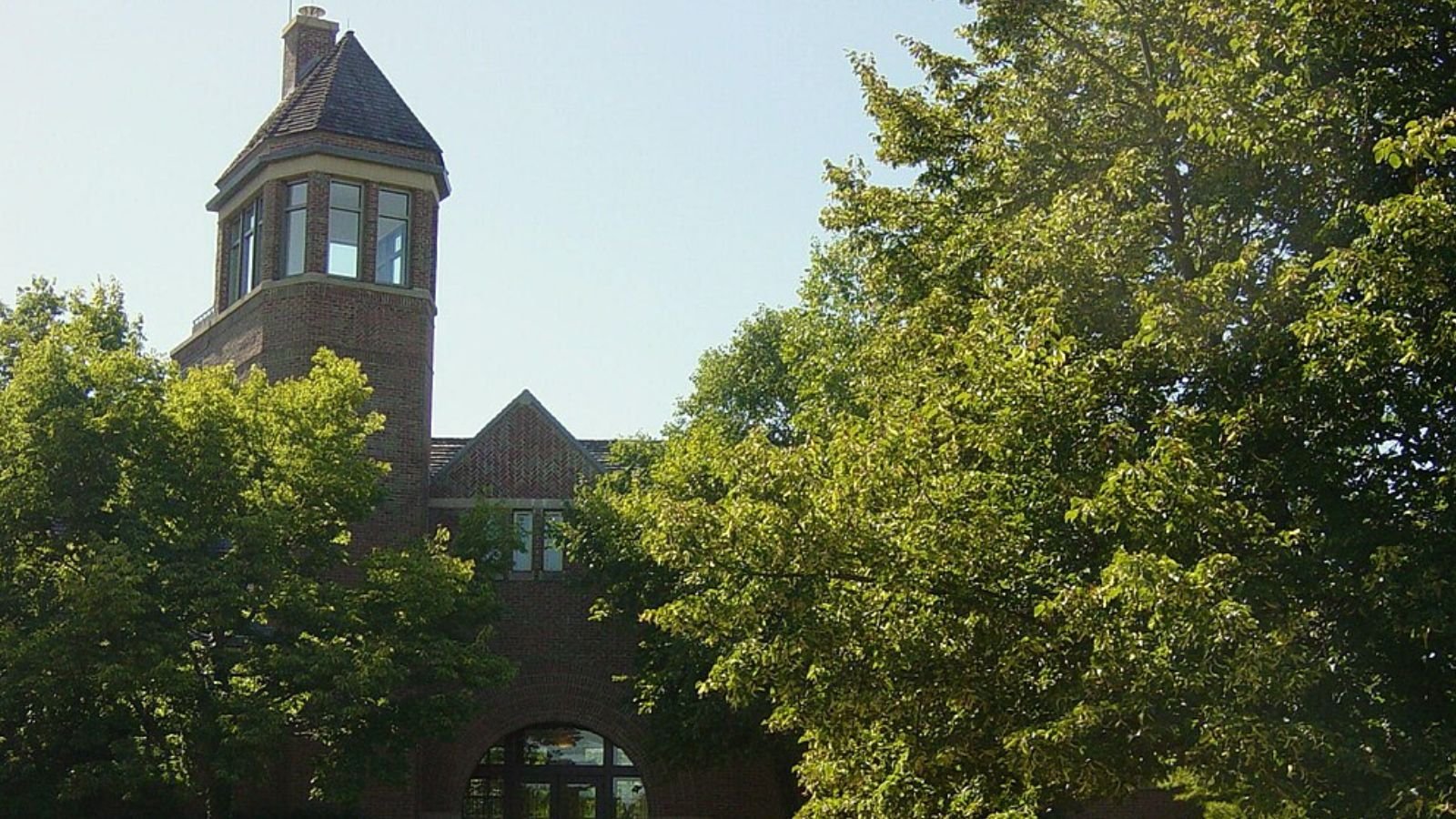
Why are people willing to pay so much to live here? What’s special about it?
Lincolnshire appeals to corporate executives and affluent families seeking upscale suburban living with business district amenities. The village hosts numerous corporate headquarters and office complexes, creating a unique environment where residents can live and work in the same community. High-end shopping, fine dining, and luxury services cater to affluent households while maintaining suburban character.
The community offers large homes on spacious lots with mature landscaping and golf course access. Residents benefit from excellent schools, low crime rates, and well-maintained infrastructure that supports property values. Lincolnshire’s planned development approach ensures continued exclusivity while providing modern conveniences and recreational amenities.
How Lincolnshire Rose to Prominence
Lincolnshire began as agricultural land in Lake County, remaining largely undeveloped until post-World War II suburban expansion. The area’s transformation accelerated in the 1950s and 1960s as corporations relocated from downtown Chicago to suburban office parks, bringing high-paying jobs and affluent employees seeking nearby housing.
The village incorporated in 1957 with the specific goal of controlling development and maintaining high standards for residential and commercial construction. Strategic planning attracted major corporations while preserving green spaces and creating upscale neighborhoods. Modern Lincolnshire represents successful integration of corporate and residential development that supports both economic growth and quality of life.
3 Interesting Tidbits
1. Corporate Hub – Lincolnshire hosts headquarters for major companies including CDW, Zebra Technologies, and Aon, creating local employment for high-income professionals.
2. Marriott Theatre – The village’s professional theater company offers Broadway-quality productions in an intimate setting, adding cultural sophistication to suburban amenities.
3. Planned Excellence – The community was designed from inception as an integrated corporate and residential environment, with zoning that maintains clear separation between commercial and residential areas.
24. Hawthorn Woods – 49% Home Price Increase Since 2010
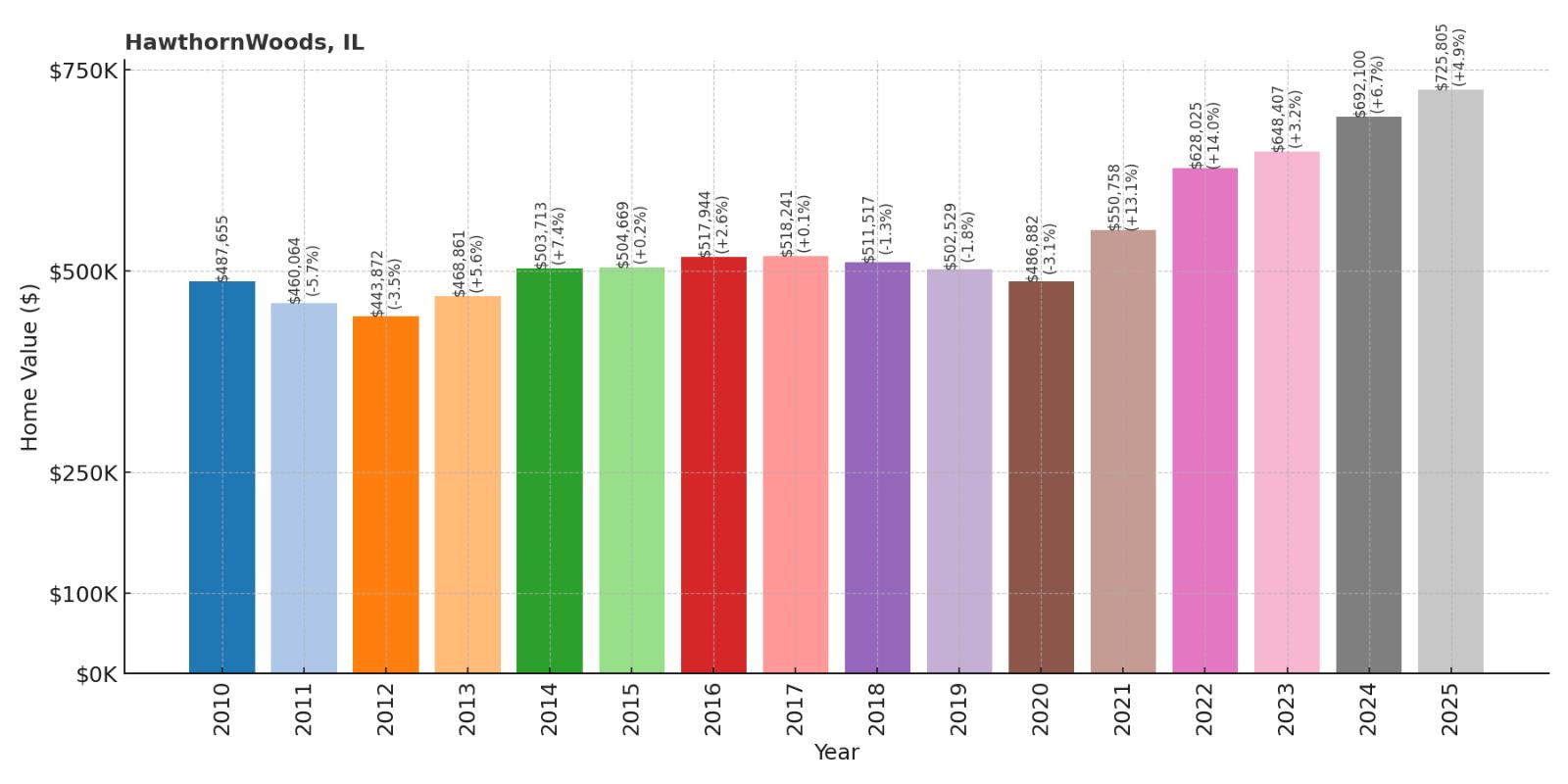
- 2010: $487,655
- 2011: $460,064
- 2012: $443,872
- 2013: $468,861
- 2014: $503,713
- 2015: $504,669
- 2016: $517,944
- 2017: $518,241
- 2018: $511,517
- 2019: $502,529
- 2020: $486,882
- 2021: $550,758
- 2022: $628,025
- 2023: $648,407
- 2024: $692,100
- 2025: $725,805
Hawthorn Woods showed gradual growth through 2016 followed by softening through 2020, typical of many luxury markets during that period. The community has experienced strong appreciation since 2021, with current median values at $725,805 representing 49% growth over fifteen years. Recent momentum suggests continued appeal among affluent buyers seeking spacious suburban properties.
Why Hawthorn Woods?
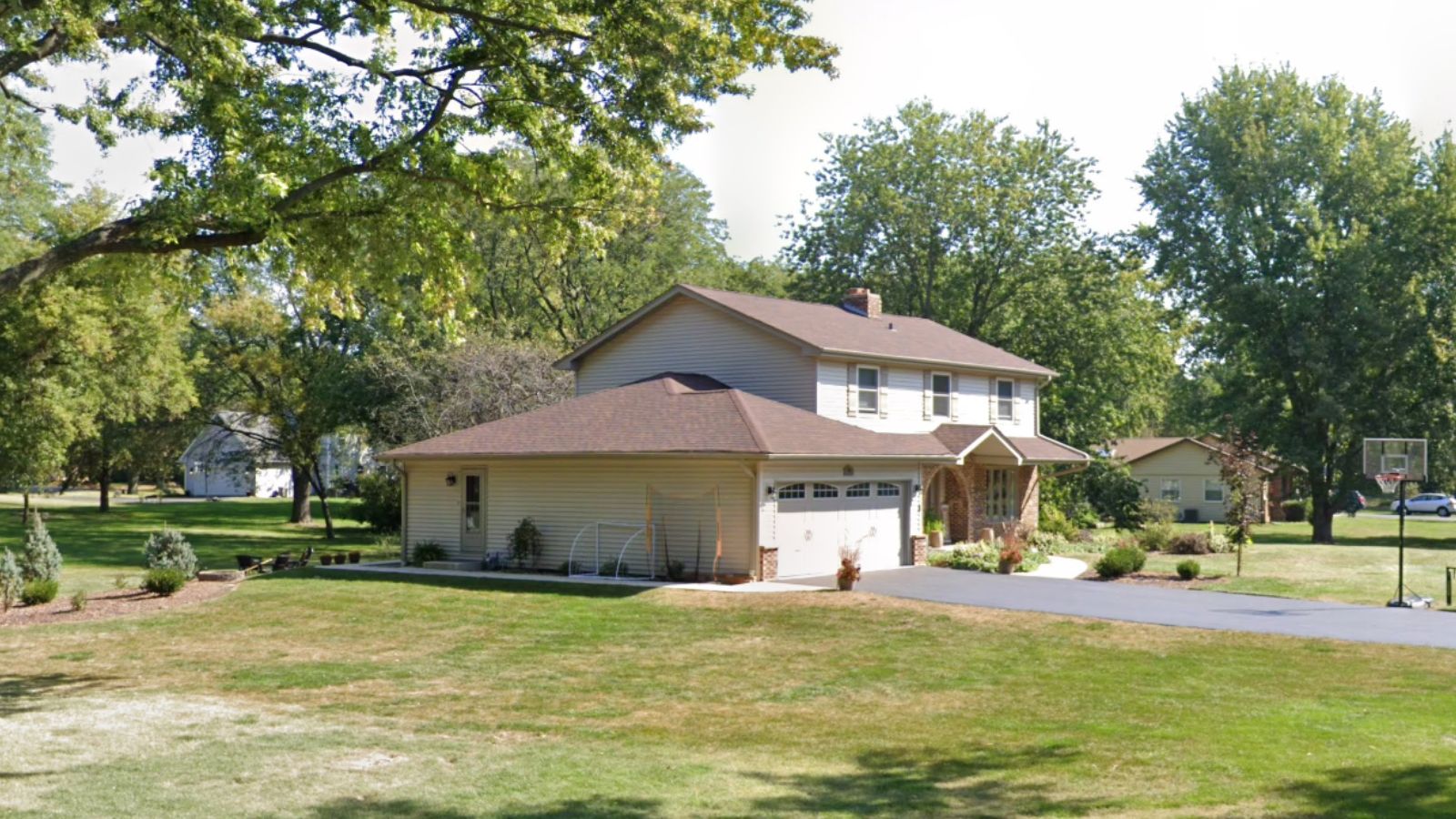
Why are people willing to pay so much to live here? What’s special about it?
Hawthorn Woods attracts affluent families seeking luxury homes on large, wooded lots that provide privacy and natural beauty. The village maintains strict development standards that preserve mature forests and require substantial setbacks, creating an exclusive enclave feel. Residents appreciate the rural character combined with access to excellent schools, upscale amenities, and major transportation corridors.
The community’s zoning protects environmental quality while supporting custom home construction on oversized lots. Many properties feature equestrian facilities, extensive landscaping, and architectural details that cater to discerning buyers. This careful development approach ensures continued exclusivity and environmental preservation that justifies premium pricing.
How Hawthorn Woods Rose to Prominence
Hawthorn Woods incorporated in 1958 as Lake County’s suburban development expanded westward from Lake Michigan. Early residents were drawn by large lots available for custom home construction in a forested setting that retained rural character. The village established strict zoning requirements that prevented typical suburban subdivision development.
Strategic location between major employment centers in Schaumburg and Lake County attracted corporate executives seeking spacious estates with convenient access to business districts. The community’s development philosophy emphasized environmental preservation and architectural quality, creating a unique suburban environment. Modern Hawthorn Woods represents successful balance between growth and conservation that maintains exclusivity while supporting property values.
3 Interesting Tidbits
1. Forest Preservation – Village ordinances require preservation of mature trees and native vegetation, maintaining the natural forest character that gives the community its name and appeal.
2. Equestrian Heritage – Many properties include horse facilities and riding trails, reflecting the area’s agricultural past and continued appeal to horse enthusiasts.
3. Custom Architecture – Strict building codes encourage unique architectural design while maintaining consistency in scale and environmental integration.
23. Deer Park – 47% Home Price Increase Since 2010

- 2010: $505,361
- 2011: $468,865
- 2012: $461,426
- 2013: $491,792
- 2014: $530,465
- 2015: $524,563
- 2016: $531,960
- 2017: $534,828
- 2018: $528,779
- 2019: $523,644
- 2020: $506,905
- 2021: $584,590
- 2022: $652,594
- 2023: $673,934
- 2024: $710,873
- 2025: $742,491
Deer Park maintained relatively stable values through most periods, with modest appreciation from 2010-2020 followed by dramatic acceleration in recent years. The 46% surge since 2020 has brought median prices to $742,491, reflecting strong pandemic-era demand for spacious suburban properties. This recent performance demonstrates continued appeal of exclusive Lake County communities.
Why Deer Park?
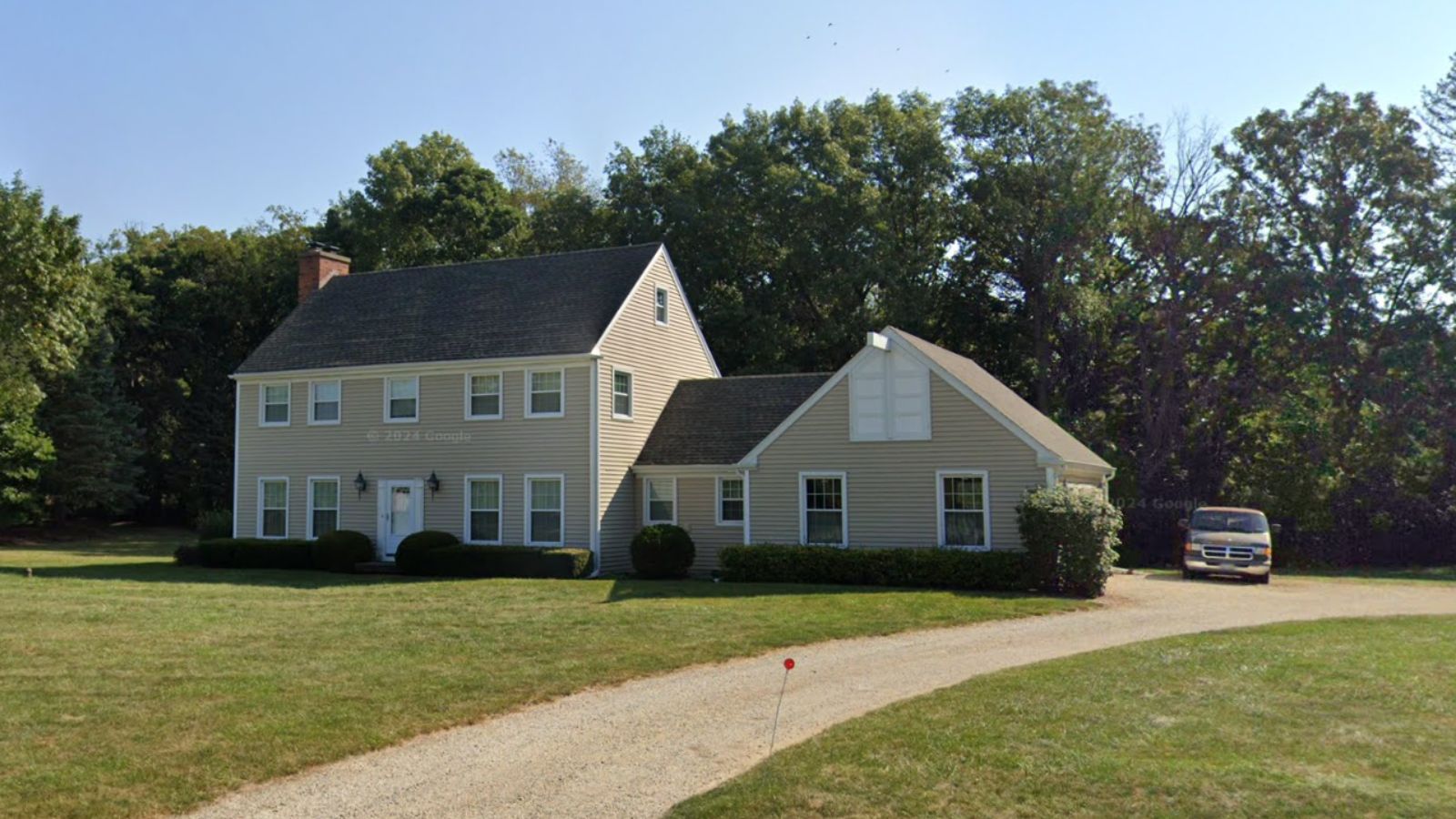
Why are people willing to pay so much to live here? What’s special about it?
Deer Park offers luxury living in a carefully planned community that balances exclusivity with modern amenities. The village features large custom homes on spacious lots with mature landscaping that creates privacy and natural beauty. Residents value the low-density development, excellent infrastructure, and convenient access to shopping, dining, and recreational facilities without urban congestion.
The community’s zoning maintains residential character while providing access to nearby commercial districts and transportation networks. Quality schools, well-maintained public spaces, and active community organizations enhance quality of life. This combination of exclusivity, convenience, and natural setting supports premium property values among discerning buyers.
How Deer Park Rose to Prominence
Deer Park incorporated in 1967 as suburban development expanded into northwest Lake County, attracting residents seeking custom homes on large lots with forest preserve access. The village’s location near major transportation corridors made it accessible to Chicago-area employment while maintaining rural character through careful zoning.
Early development emphasized environmental preservation and architectural quality, establishing standards that continue to attract affluent households. The community’s proximity to corporate centers in Schaumburg and northwest suburbs provided convenient access to high-paying employment. Modern Deer Park represents successful suburban planning that preserves natural amenities while supporting luxury residential development.
3 Interesting Tidbits
1. Nature Access – The village borders extensive Lake County Forest Preserves, providing residents with hiking trails, wildlife viewing, and recreational opportunities beyond typical suburban amenities.
2. Planned Community – Deer Park was specifically designed as a low-density residential community with strict architectural and landscaping standards that maintain consistent high-quality development.
3. Corporate Proximity – Strategic location near major corporate campuses allows residents to enjoy rural living while maintaining short commutes to high-paying professional positions.
22. Highland Park – 62% Home Price Increase Since 2010
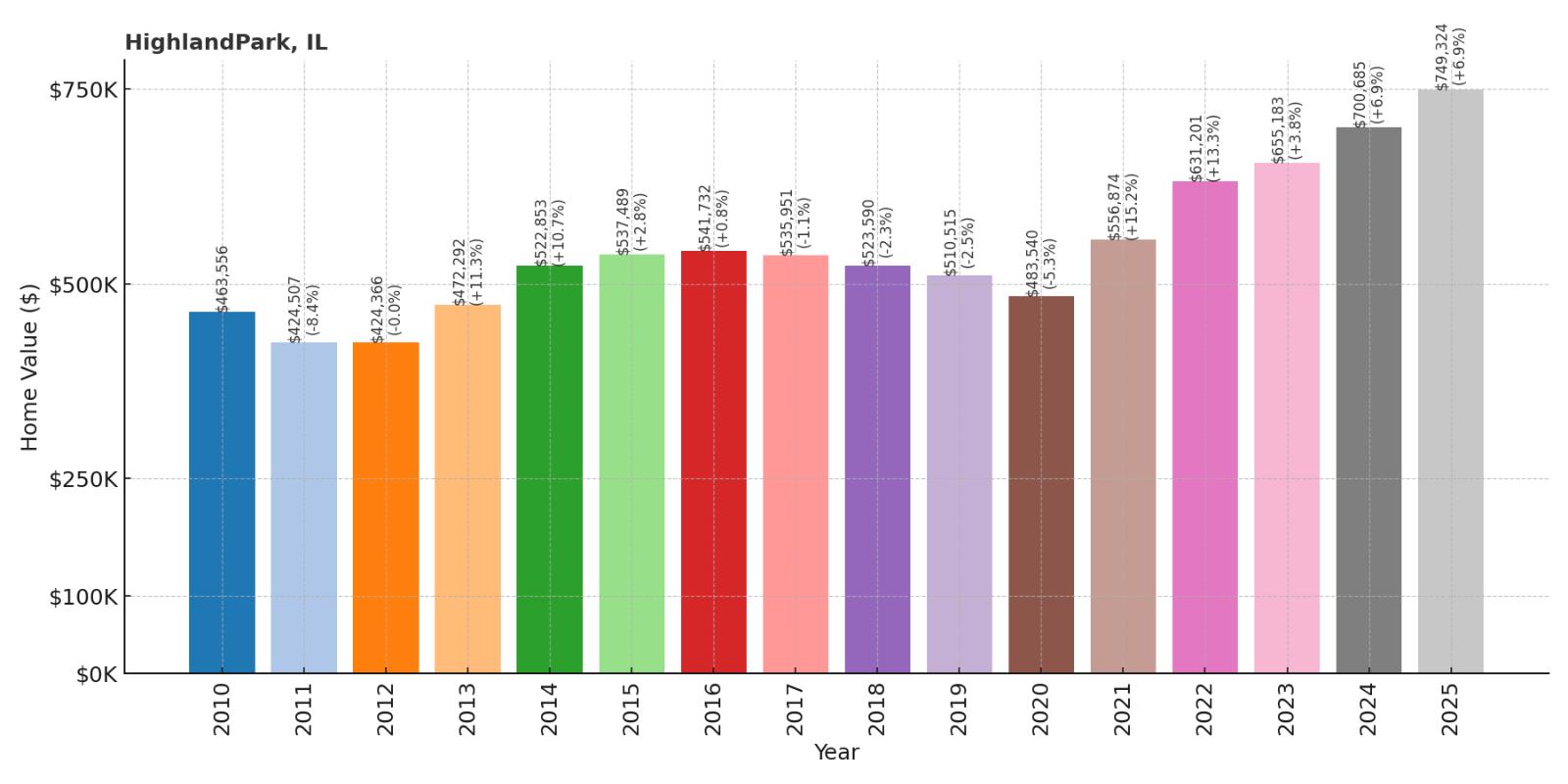
- 2010: $463,556
- 2011: $424,507
- 2012: $424,366
- 2013: $472,292
- 2014: $522,853
- 2015: $537,489
- 2016: $541,732
- 2017: $535,951
- 2018: $523,590
- 2019: $510,515
- 2020: $483,540
- 2021: $556,874
- 2022: $631,201
- 2023: $655,183
- 2024: $700,685
- 2025: $749,324
Highland Park experienced steady growth through 2016 before softening through 2020, a pattern reflecting broader luxury market trends. Recent appreciation has been exceptional, with 55% growth since pandemic lows bringing values to $749,324. This performance demonstrates the enduring appeal of North Shore lakefront communities among affluent buyers.
Why Highland Park?
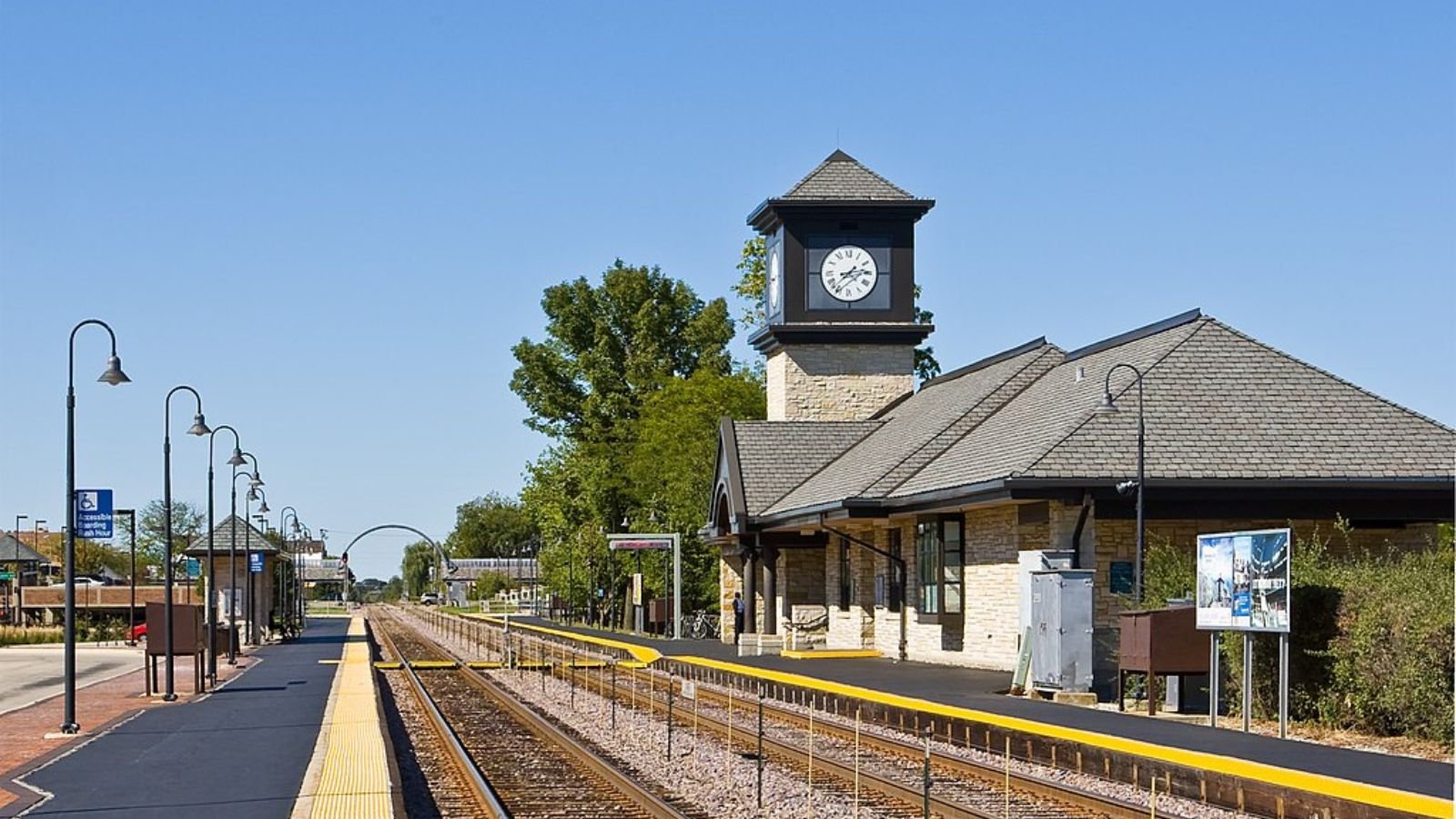
Why are people willing to pay so much to live here? What’s special about it?
Highland Park combines North Shore prestige with cultural amenities that create a sophisticated community environment. The city offers lakefront access, excellent schools, and the renowned Ravinia Festival, which hosts world-class musical performances throughout the summer. Residents appreciate the walkable downtown district, diverse architectural styles, and strong community engagement that distinguishes Highland Park from typical suburbs.
The community’s location provides direct access to Lake Michigan beaches and parks while maintaining convenient transportation to Chicago via Metra rail service. Historic neighborhoods feature mature trees and varied housing stock from modest bungalows to lakefront estates. This diversity creates economic integration while supporting overall property values through sustained demand across price ranges.
How Highland Park Rose to Prominence
Highland Park was founded in 1869 by a group of Chicago businessmen seeking to create an ideal suburban community with natural beauty and cultural amenities. Early planners emphasized parks, tree-lined streets, and architectural variety that established the community’s distinctive character. The arrival of railroad service in 1872 made commuting to Chicago practical for professional residents.
The establishment of Ravinia Park in 1904 as a summer music venue elevated Highland Park’s cultural profile and attracted artistic residents. Post-World War II development expanded the community while preserving historic neighborhoods and lakefront access. Modern Highland Park balances historic preservation with contemporary amenities, maintaining its appeal to educated professionals and families who value both culture and convenience.
3 Interesting Tidbits
1. Ravinia Legacy – The Ravinia Festival has operated continuously since 1904, making it North America’s oldest outdoor music festival and a defining cultural feature of the community.
2. Architectural Diversity – Highland Park contains examples of virtually every American architectural style from the late 19th and early 20th centuries, reflecting its long history of custom home construction.
3. Green Commitment – The city maintains over 1,000 acres of parks and open space, including lakefront beaches and forest preserves that enhance residential quality of life.
21. Wayne – 48% Home Price Increase Since 2010
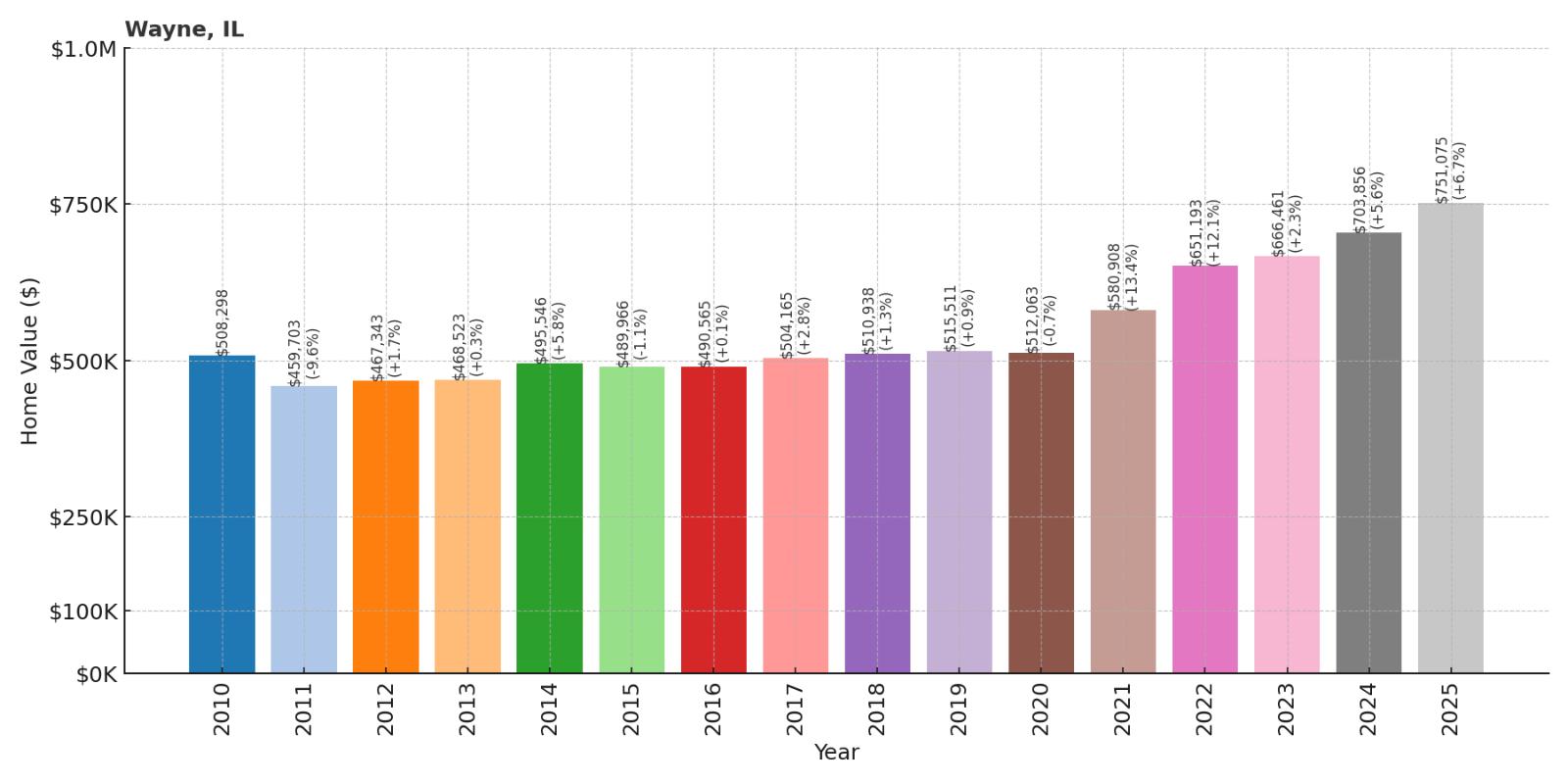
- 2010: $508,298
- 2011: $459,703
- 2012: $467,343
- 2013: $468,523
- 2014: $495,546
- 2015: $489,966
- 2016: $490,565
- 2017: $504,165
- 2018: $510,938
- 2019: $515,511
- 2020: $512,063
- 2021: $580,908
- 2022: $651,193
- 2023: $666,461
- 2024: $703,856
- 2025: $751,075
Wayne demonstrated remarkable stability through market fluctuations, maintaining values above $450,000 even during challenging periods from 2011-2016. Recent appreciation has accelerated significantly, with 47% growth since 2020 pushing median prices to $751,075. This performance reflects strong demand for luxury properties in exclusive DuPage County communities.
Why Wayne?
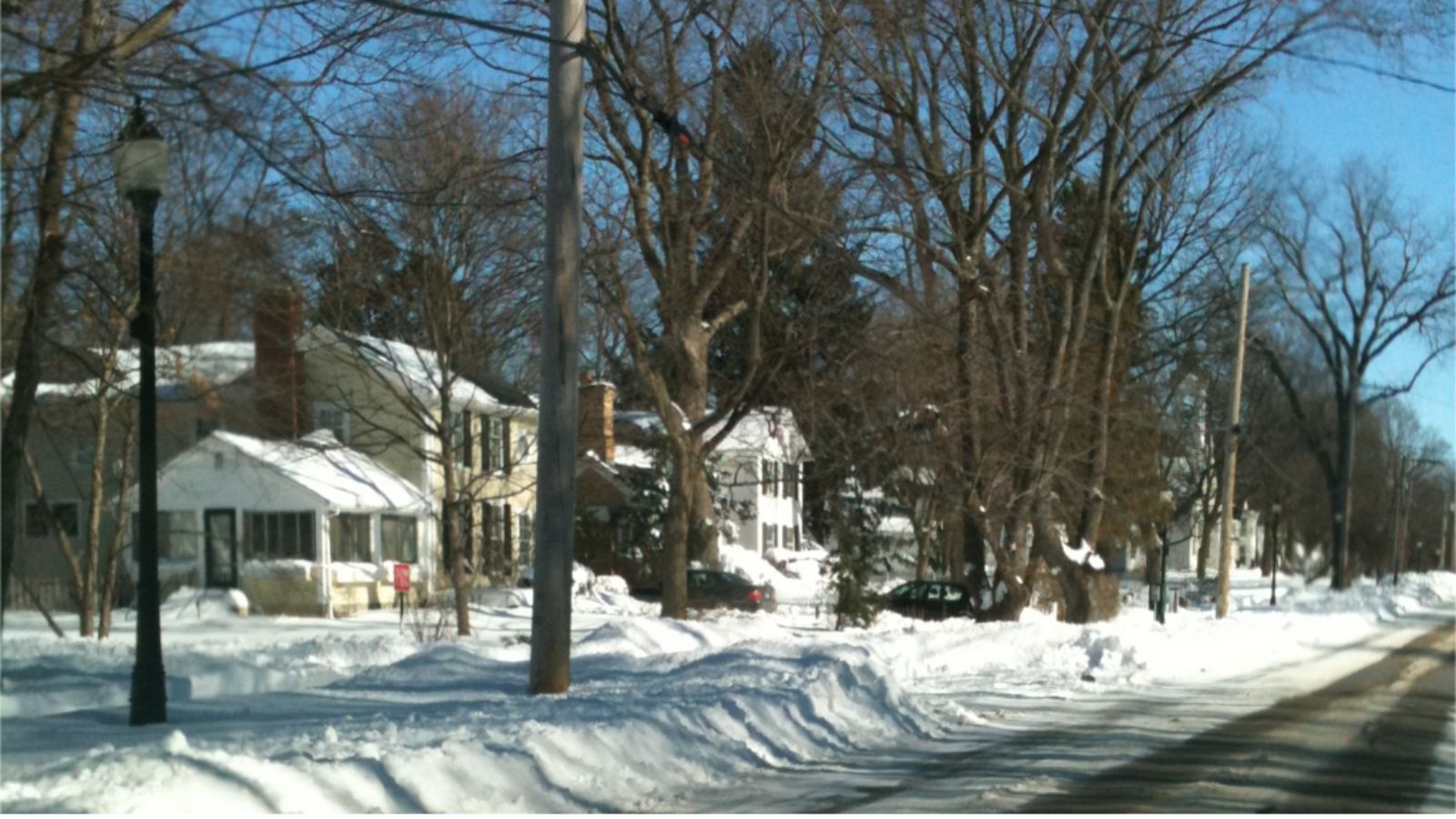
Why are people willing to pay so much to live here? What’s special about it?
Wayne attracts affluent buyers seeking estate-style living on large properties with rural character while maintaining suburban convenience. The village requires minimum lot sizes that ensure privacy and space, appealing to families who want custom homes with room for amenities like pools, gardens, and recreational facilities. Residents value the peaceful environment, excellent schools, and proximity to major employment centers.
The community’s strict development standards preserve open space and prevent overdevelopment while supporting premium home construction. Many properties feature luxury amenities and architectural details that cater to discerning buyers. This combination of exclusivity, space, and quality infrastructure supports sustained property value appreciation among high-end purchasers.
How Wayne Rose to Prominence
Wayne originated as an agricultural community in DuPage County, remaining largely rural until suburban expansion reached the area in the mid-20th century. The village incorporated in 1959 with specific goals of maintaining low-density development and rural character while accommodating suburban growth pressures.
Strategic zoning requiring large lot sizes attracted affluent families seeking estate-style properties with convenient access to Chicago and suburban employment centers. The community’s development philosophy emphasized environmental preservation and architectural quality, creating an exclusive enclave character. Modern Wayne represents successful balance between growth and conservation that maintains rural appeal while supporting luxury residential development.
3 Interesting Tidbits
1. Estate Zoning – Village ordinances require minimum lot sizes of one acre or more, ensuring continued low-density development that preserves rural character and privacy.
2. Dunham Castle – The historic Dunham Castle, built in 1881, serves as a community landmark and wedding venue that adds unique architectural character to the area.
3. Forest Preserve Access – Wayne borders extensive DuPage County Forest Preserves, providing residents with hiking trails and nature areas that enhance the rural living experience.
20. Inverness – 29% Home Price Increase Since 2010

- 2010: $605,568
- 2011: $564,752
- 2012: $515,658
- 2013: $543,967
- 2014: $578,734
- 2015: $589,796
- 2016: $586,598
- 2017: $586,481
- 2018: $591,060
- 2019: $575,150
- 2020: $558,984
- 2021: $618,703
- 2022: $687,209
- 2023: $702,411
- 2024: $743,238
- 2025: $781,445
Inverness showed the most restrained appreciation among expensive communities, with modest 29% growth since 2010 despite starting from a high base above $600,000. The community experienced significant decline through 2012 and remained relatively flat through 2020 before recent acceleration. Current values at $781,445 reflect renewed strength in this exclusive northwest suburb.
Why Inverness?
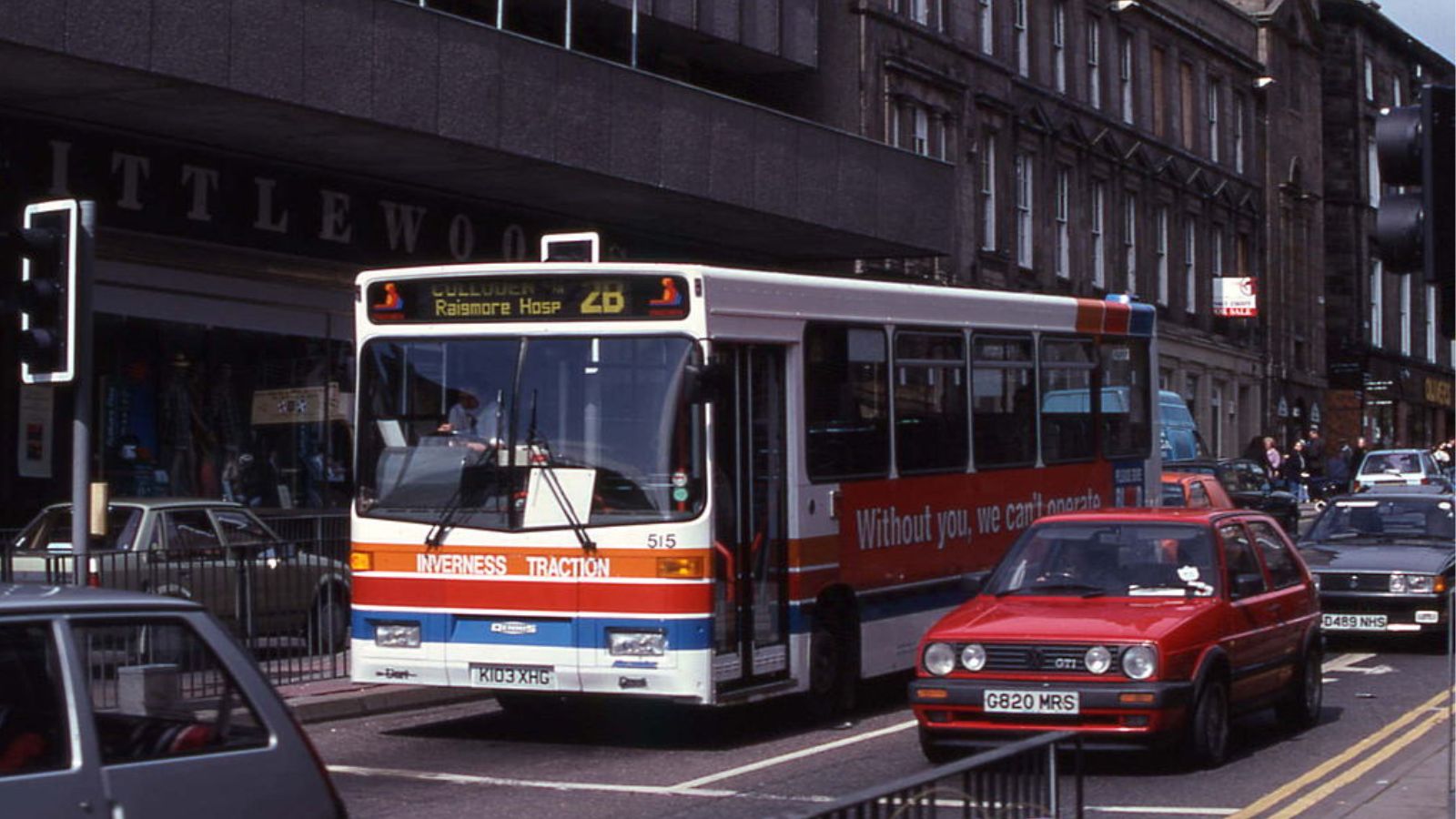
Why are people willing to pay so much to live here? What’s special about it?
Inverness appeals to affluent buyers seeking luxury homes in a planned community with golf course amenities and forest preserve access. The village features large custom homes on spacious lots with mature landscaping that creates an exclusive residential environment. Residents value the rural character, low crime rates, and proximity to major corporate centers while enjoying recreational facilities and natural beauty.
The community’s development standards ensure architectural quality and environmental preservation while providing modern infrastructure and amenities. Access to private golf clubs, riding trails, and forest preserves enhances quality of life beyond typical suburban offerings. This combination of luxury, nature, and convenience supports premium property values among discerning purchasers.
How Inverness Rose to Prominence
Inverness was developed in the 1960s as a master-planned community designed to attract affluent residents seeking country club living with Chicago area access. Early development centered around golf courses and equestrian facilities that established the community’s recreational and luxury character. The village incorporated in 1962 with strict zoning that maintained low-density development.
Strategic location in Cook County’s northwest suburbs provided convenient access to major employment centers while preserving rural character through careful planning. The community’s emphasis on environmental preservation and recreational amenities attracted corporate executives and affluent professionals. Modern Inverness represents successful planned community development that balances luxury residential living with natural area preservation.
3 Interesting Tidbits
1. Golf Heritage – Inverness Golf Club, designed by William Langford and Theodore Moreau, has hosted major professional tournaments and remains a centerpiece of community life.
2. Equestrian Culture – The village maintains extensive riding trails and supports equestrian activities, reflecting its development as a country estate community.
3. Master Planning – Inverness was among the first Chicago-area communities designed comprehensively with integrated residential, recreational, and natural areas from its inception.
19. Northfield – 38% Home Price Increase Since 2010
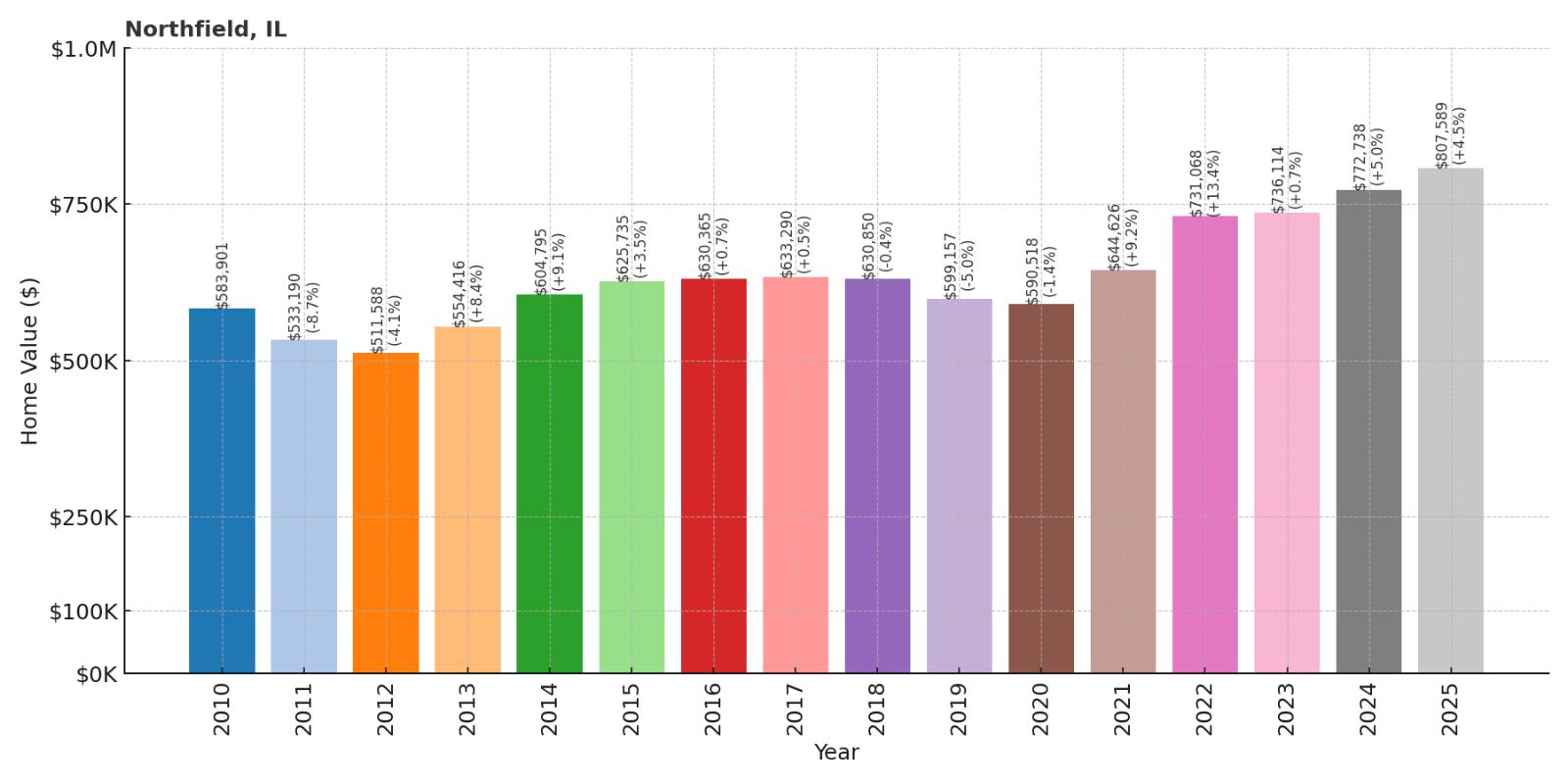
- 2010: $583,901
- 2011: $533,190
- 2012: $511,588
- 2013: $554,416
- 2014: $604,795
- 2015: $625,735
- 2016: $630,365
- 2017: $633,290
- 2018: $630,850
- 2019: $599,157
- 2020: $590,518
- 2021: $644,626
- 2022: $731,068
- 2023: $736,114
- 2024: $772,738
- 2025: $807,589
Northfield recovered from early 2010s weakness to reach peak values around 2017 before experiencing gradual decline through 2020. Recent appreciation has been strong, with 37% growth since pandemic lows bringing median values to $807,589. This pattern reflects typical North Shore market dynamics with renewed strength among affluent suburban communities.
Why Northfield?
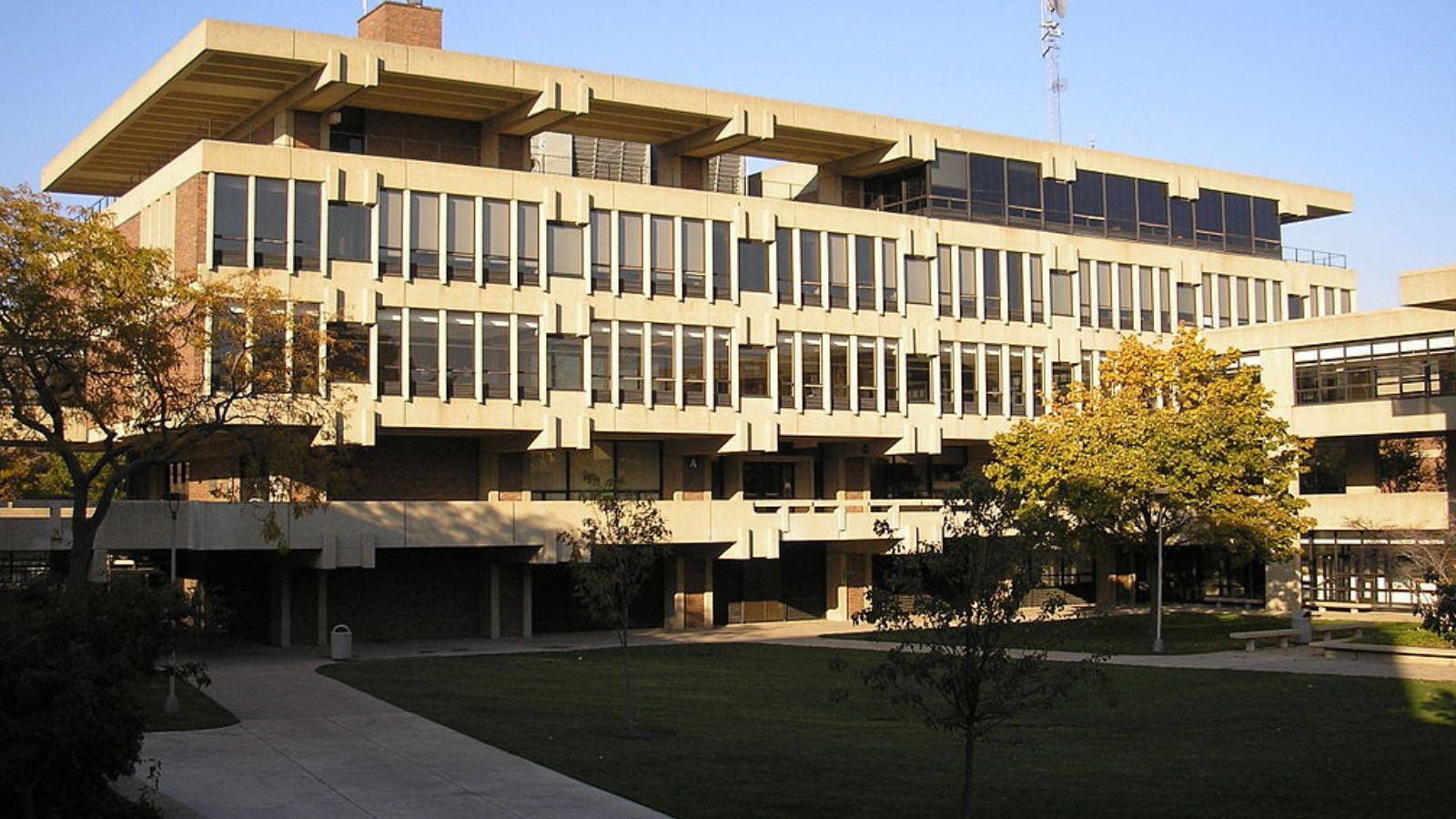
Why are people willing to pay so much to live here? What’s special about it?
Northfield attracts families seeking North Shore prestige in a compact, walkable community with excellent schools and convenient transportation. The village offers tree-lined streets, historic architecture, and a charming downtown district that creates small-town character while maintaining sophisticated amenities. Residents appreciate the balance of exclusivity and accessibility, plus strong community engagement and cultural activities.
The community’s location provides multiple options for Chicago commuting while offering local shopping, dining, and recreational facilities. Quality schools, well-maintained infrastructure, and active civic organizations enhance quality of life. This combination of convenience, character, and community creates sustained appeal among educated professionals and affluent families.
How Northfield Rose to Prominence
Northfield was established in 1872 when the Chicago and Milwaukee Railroad built a station in the area, transforming agricultural land into a commuter suburb. Early residents were primarily Chicago businessmen seeking country homes with convenient rail access to the city. The community incorporated in 1893 and developed steadily through the early 20th century.
Post-World War II suburban expansion brought significant residential development while preserving the village’s historic character and compact scale. Strategic planning maintained downtown vitality and prevented sprawl while accommodating modern housing needs. Modern Northfield represents successful balance between historic preservation and contemporary development that maintains small-town appeal within the metropolitan area.
3 Interesting Tidbits
1. Railroad Heritage – The original 1872 railroad station building still stands and serves as a community landmark, reflecting the village’s transportation-based founding.
2. Compact Character – Northfield maintains a walkable downtown with local businesses and services within easy walking distance of residential neighborhoods.
3. Education Excellence – New Trier High School, serving Northfield and surrounding communities, consistently ranks among the top public high schools in the United States.
18. North Barrington – 41% Home Price Increase Since 2010
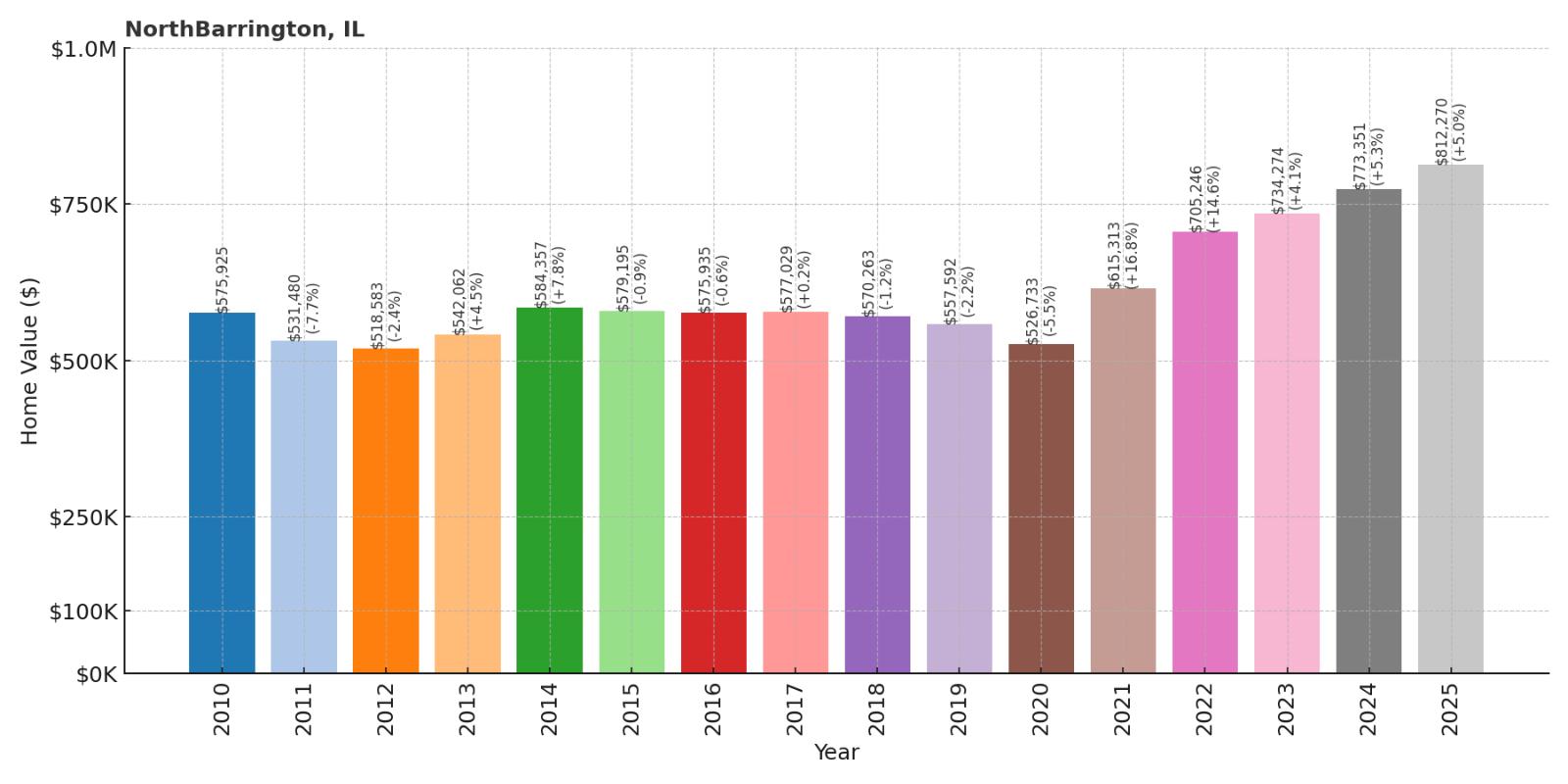
- 2010: $575,925
- 2011: $531,480
- 2012: $518,583
- 2013: $542,062
- 2014: $584,357
- 2015: $579,195
- 2016: $575,935
- 2017: $577,029
- 2018: $570,263
- 2019: $557,592
- 2020: $526,733
- 2021: $615,313
- 2022: $705,246
- 2023: $734,274
- 2024: $773,351
- 2025: $812,270
North Barrington maintained relatively stable values through extended periods, showing resilience during market downturns from 2011-2020. Recent appreciation has been dramatic, with 54% growth since 2020 bringing median prices to $812,270. This performance demonstrates strong demand for luxury properties in exclusive Barrington area communities.
Why North Barrington?

Why are people willing to pay so much to live here? What’s special about it?
North Barrington attracts affluent buyers seeking estate-style living with golf course access and equestrian facilities in a semi-rural setting. The village features large custom homes on spacious lots with mature landscaping that provides privacy and natural beauty. Residents value the exclusive character, recreational amenities, and convenient access to major employment centers while enjoying country club atmosphere.
The community’s development standards preserve open space and support luxury home construction while maintaining rural character. Access to private golf clubs, riding trails, and forest preserves enhances quality of life beyond typical suburban offerings. This combination of exclusivity, recreation, and natural setting supports premium property values among discerning purchasers seeking luxury suburban living.
How North Barrington Rose to Prominence
North Barrington developed as part of the broader Barrington area’s transformation from agricultural land to exclusive suburban community in the mid-20th century. The village incorporated in 1959 with specific goals of maintaining low-density development and rural character while accommodating suburban growth pressures from Chicago’s expanding metropolitan area.
Strategic location in Cook and Lake Counties provided convenient access to major employment centers while preserving rural character through careful zoning and development standards. The community’s emphasis on golf courses, equestrian facilities, and environmental preservation attracted affluent professionals seeking country estate living. Modern North Barrington represents successful luxury suburban development that maintains exclusive character while providing modern amenities.
3 Interesting Tidbits
1. Golf Paradise – The village contains multiple private golf courses including Wynstone Golf Club, which has hosted PGA Tour events and provides world-class recreational amenities.
2. Horse Country – Many properties include equestrian facilities and the area maintains extensive riding trails that connect to forest preserves and neighboring communities.
3. Dual County – North Barrington spans both Cook and Lake Counties, providing residents with options for services while maintaining unified community character.
17. Burr Ridge – 31% Home Price Increase Since 2010
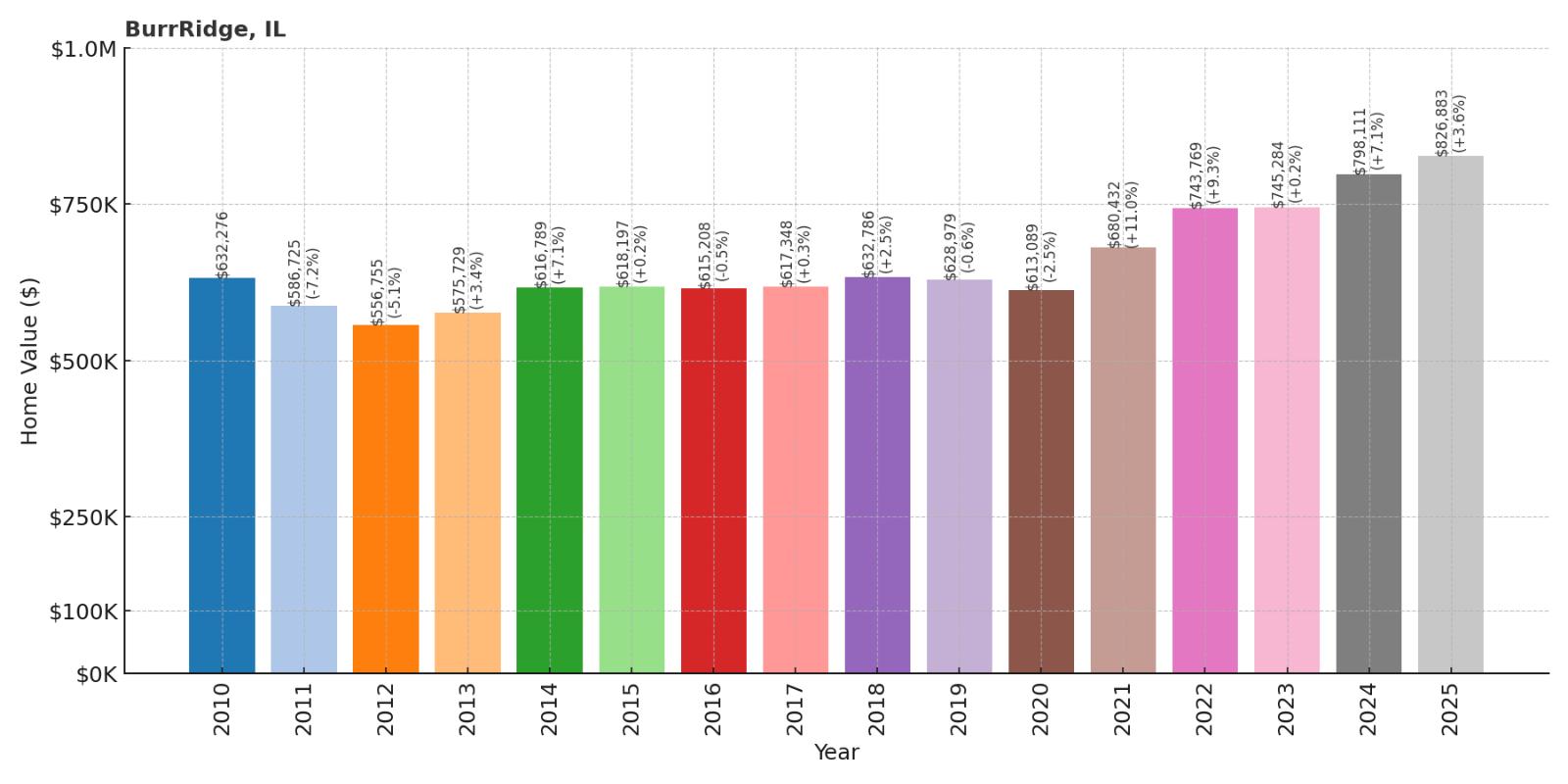
- 2010: $632,276
- 2011: $586,725
- 2012: $556,755
- 2013: $575,729
- 2014: $616,789
- 2015: $618,197
- 2016: $615,208
- 2017: $617,348
- 2018: $632,786
- 2019: $628,979
- 2020: $613,089
- 2021: $680,432
- 2022: $743,769
- 2023: $745,284
- 2024: $798,111
- 2025: $826,883
Burr Ridge showed moderate appreciation with extended stability from 2014-2020, starting from a high base above $630,000 in 2010. Recent growth has accelerated significantly, with 35% appreciation since 2020 bringing current values to $826,883. This pattern reflects sustained appeal of established western suburbs among affluent buyers seeking luxury amenities.
Why Burr Ridge?

Why are people willing to pay so much to live here? What’s special about it?
Burr Ridge appeals to affluent families seeking luxury homes in a well-established community with excellent schools and upscale amenities. The village features custom-built homes on large lots with mature landscaping, many backing to forest preserves or golf courses. Residents value the quiet suburban character, low crime rates, and convenient access to major employment centers while enjoying recreational facilities and shopping options.
The community’s development standards ensure architectural quality and environmental preservation while providing modern infrastructure and services. Access to private clubs, forest preserves, and upscale commercial districts enhances quality of life. This combination of luxury, convenience, and natural amenities supports premium property values among discerning buyers seeking established suburban excellence.
How Burr Ridge Rose to Prominence
Burr Ridge evolved from rural DuPage County farmland into a planned suburban community beginning in the 1960s. Early development emphasized large lots and custom homes that attracted affluent families seeking spacious properties with convenient access to Chicago and emerging suburban employment centers. The village incorporated in 1956 with zoning that maintained low-density development.
Strategic location near major highways and corporate centers in Oak Brook and Naperville supported continued growth while preserving residential character. The community’s emphasis on environmental preservation and architectural quality established its reputation for luxury suburban living. Modern Burr Ridge represents successful suburban development that balances growth with conservation while maintaining exclusive residential character.
3 Interesting Tidbits
1. Forest Integration – Much of Burr Ridge borders Salt Creek Forest Preserve, providing residents with hiking trails and natural areas that enhance suburban living with outdoor recreation.
2. Corporate Proximity – The village’s location near Oak Brook’s corporate corridor provides convenient access to Fortune 500 headquarters while maintaining residential tranquility.
3. Golf Heritage – Multiple golf courses within and adjacent to the village create recreational amenities while preserving open space that enhances property values.
16. Western Springs – 44% Home Price Increase Since 2010

- 2010: $575,393
- 2011: $534,994
- 2012: $491,974
- 2013: $529,580
- 2014: $576,424
- 2015: $601,475
- 2016: $601,975
- 2017: $612,507
- 2018: $622,279
- 2019: $620,779
- 2020: $610,653
- 2021: $677,370
- 2022: $741,646
- 2023: $750,358
- 2024: $779,722
- 2025: $827,376
Western Springs recovered steadily from 2012 lows, showing consistent growth through 2019 before slight softening in 2020. Recent appreciation has been strong, with 35% growth since pandemic lows bringing median values to $827,376. This performance reflects continued appeal of established western suburbs with historic character and convenient transportation access.
Why Western Springs?
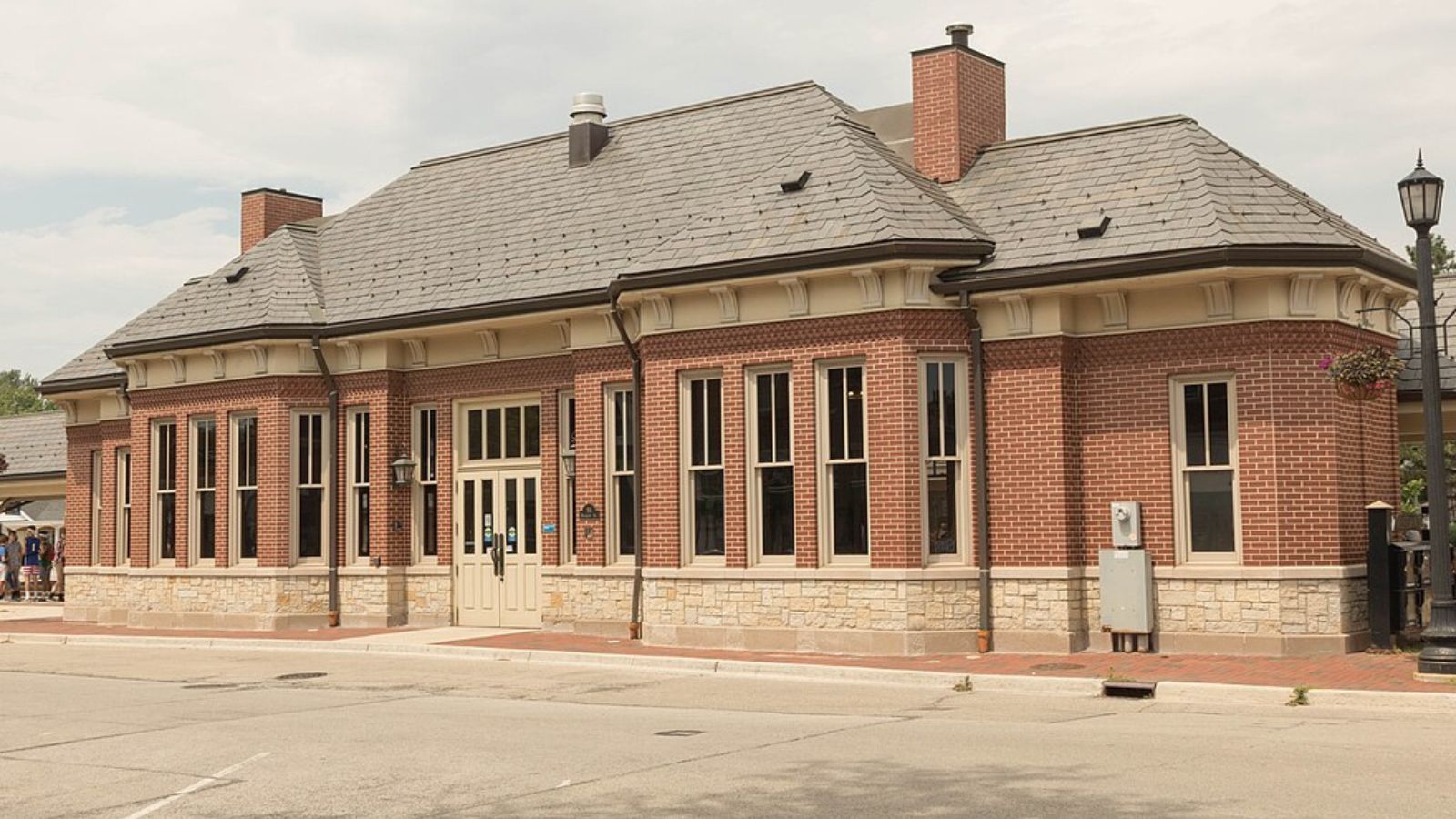
Why are people willing to pay so much to live here? What’s special about it?
Western Springs attracts families seeking historic charm in a walkable community with excellent schools and convenient train service to Chicago. The village features tree-lined streets, diverse architectural styles, and a vibrant downtown district that creates small-town character while maintaining sophisticated amenities. Residents appreciate the balance of suburban tranquility and urban accessibility, plus strong community engagement and cultural activities.
The community’s compact layout encourages walking and cycling while providing quality shopping, dining, and services within the village. Historic neighborhoods offer varied housing options from vintage bungalows to contemporary estates. This combination of character, convenience, and community creates sustained appeal among professionals and families seeking both charm and practicality.
How Western Springs Rose to Prominence
Western Springs was founded in 1886 around natural springs that attracted health-seekers and Chicago residents desiring country living. The arrival of railroad service made commuting practical, transforming the area into a desirable suburban community. Early development emphasized architectural variety and environmental preservation that established the village’s distinctive character.
Post-World War II growth brought suburban expansion while preserving historic neighborhoods and downtown vitality. The community successfully balanced development pressure with historic preservation, maintaining small-town character within the expanding metropolitan area. Modern Western Springs represents successful integration of historic preservation with contemporary suburban amenities that appeals to educated professionals and families.
3 Interesting Tidbits
1. Spring Heritage – The village name reflects natural springs that originally attracted settlers and health-seekers in the late 19th century, with some springs still active today.
2. Architectural Diversity – Western Springs contains excellent examples of Prairie School, Arts and Crafts, and Colonial Revival architecture, reflecting its development during early suburban growth periods.
3. Forest Preserve Access – The village borders Salt Creek Forest Preserve, providing residents with extensive hiking and biking trails plus natural areas for recreation and wildlife viewing.
15. Kildeer – 38% Home Price Increase Since 2010
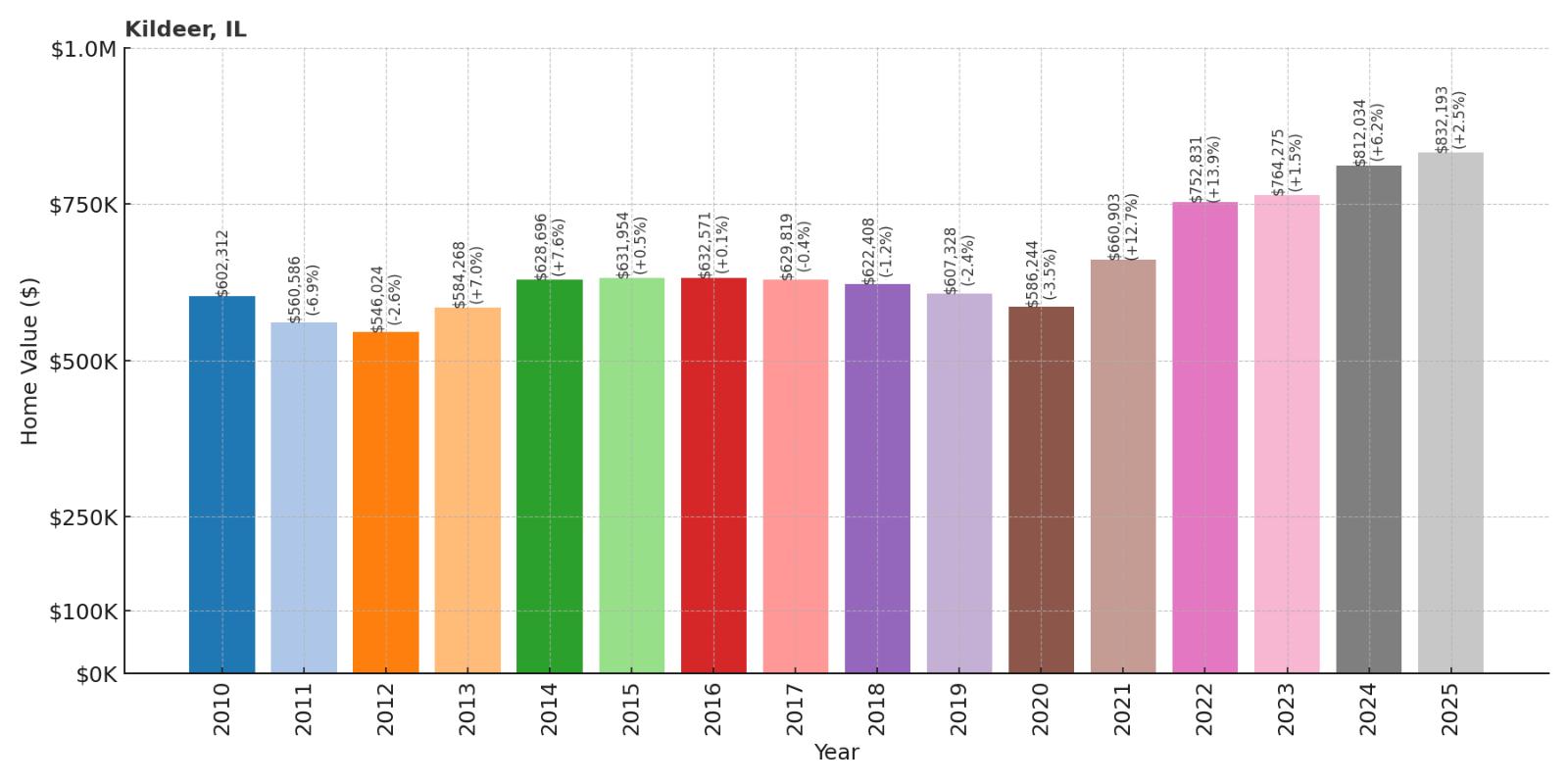
- 2010: $602,312
- 2011: $560,586
- 2012: $546,024
- 2013: $584,268
- 2014: $628,696
- 2015: $631,954
- 2016: $632,571
- 2017: $629,819
- 2018: $622,408
- 2019: $607,328
- 2020: $586,244
- 2021: $660,903
- 2022: $752,831
- 2023: $764,275
- 2024: $812,034
- 2025: $832,193
Kildeer reached peak values around 2016 before experiencing gradual decline through 2020, typical of luxury markets during that period. Recent appreciation has been significant, with 42% growth since pandemic lows bringing current values to $832,193. This performance demonstrates continued appeal of exclusive Lake County communities among affluent buyers seeking luxury suburban properties.
Why Kildeer?
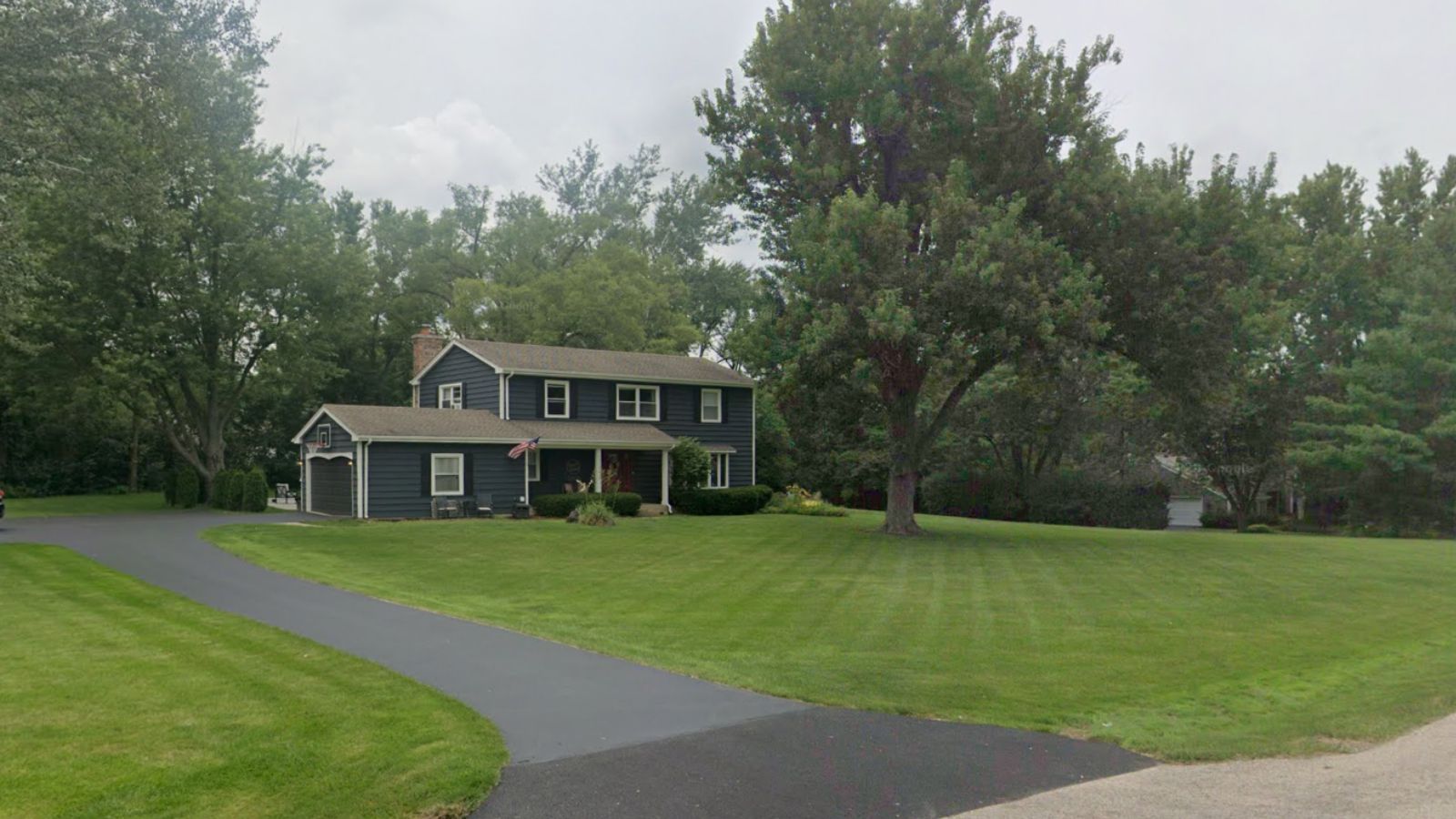
Why are people willing to pay so much to live here? What’s special about it?
Kildeer attracts affluent buyers seeking luxury homes in a carefully planned community with forest preserve access and recreational amenities. The village features large custom homes on wooded lots that provide privacy and natural beauty while maintaining convenient access to major employment centers. Residents value the exclusive character, environmental preservation, and proximity to shopping and dining options.
The community’s development standards ensure architectural quality while preserving mature forests and natural features. Many properties include luxury amenities and custom architectural details that cater to discerning buyers. This combination of exclusivity, natural beauty, and convenience supports premium property values among high-end purchasers seeking sophisticated suburban living.
How Kildeer Rose to Prominence
Kildeer incorporated in 1958 as suburban development expanded into Lake County’s forested areas. Early planning emphasized environmental preservation and low-density development that attracted affluent families seeking spacious properties with natural amenities. The village established strict zoning that maintained rural character while accommodating luxury residential development.
Strategic location between major employment centers and Lake Michigan provided convenient access while preserving forest character through careful development standards. The community’s emphasis on environmental quality and architectural standards established its reputation for exclusive suburban living. Modern Kildeer represents successful balance between development and conservation that maintains natural appeal while supporting luxury residential growth.
3 Interesting Tidbits
1. Forest Preservation – Village ordinances require preservation of mature oak and maple forests, maintaining the natural character that gives the community its distinctive wooded appeal.
2. Planned Excellence – Kildeer was among the first Lake County communities to implement comprehensive environmental preservation standards that continue to guide development decisions.
3. Corporate Access – The village’s location provides convenient access to corporate centers in Schaumburg, Lincolnshire, and downtown Chicago while maintaining secluded residential character.
14. Wilmette – 41% Home Price Increase Since 2010
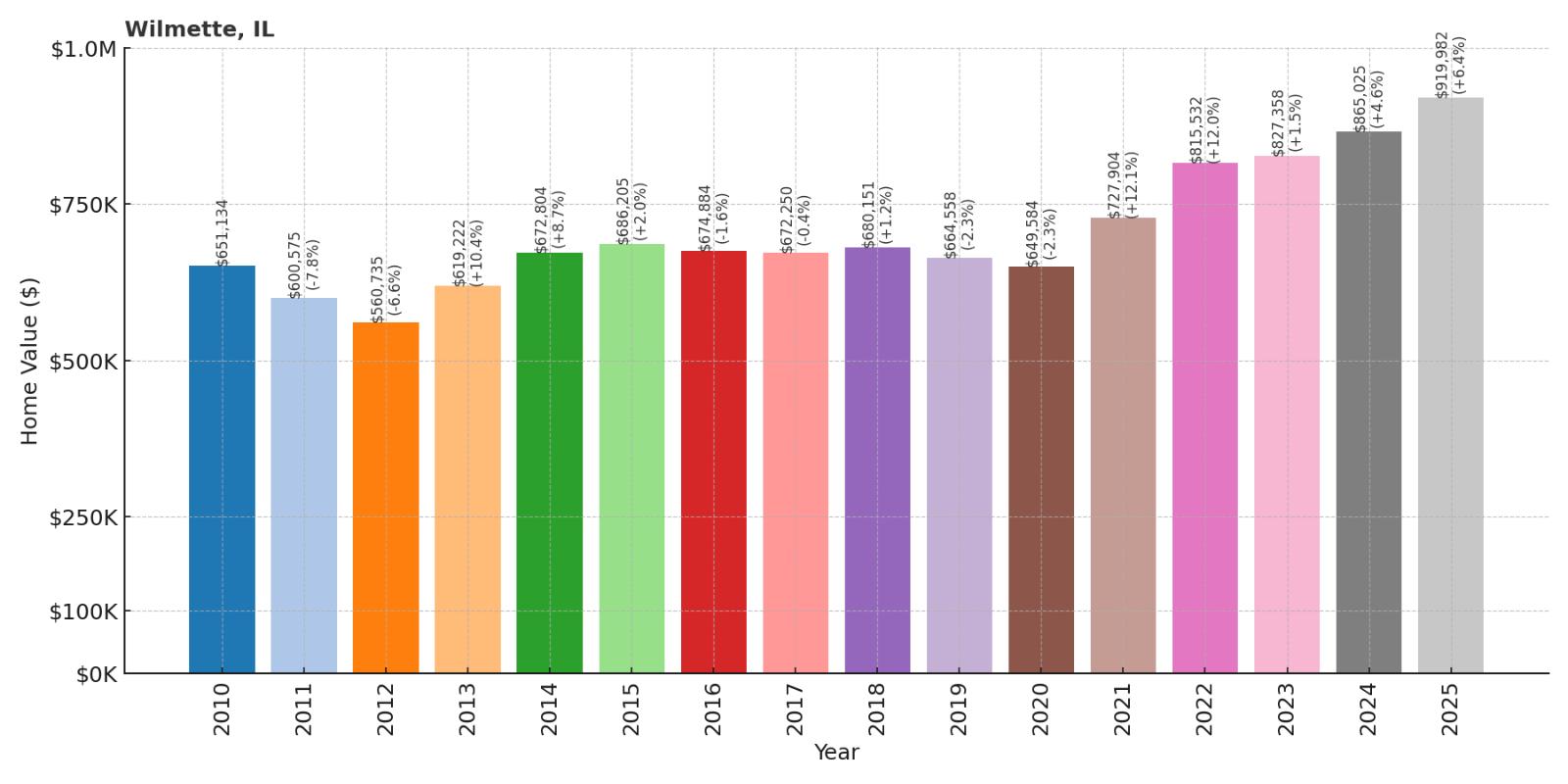
- 2010: $651,134
- 2011: $600,575
- 2012: $560,735
- 2013: $619,222
- 2014: $672,804
- 2015: $686,205
- 2016: $674,884
- 2017: $672,250
- 2018: $680,151
- 2019: $664,558
- 2020: $649,584
- 2021: $727,904
- 2022: $815,532
- 2023: $827,358
- 2024: $865,025
- 2025: $919,982
Wilmette demonstrated resilience through market fluctuations, recovering from 2012 lows to maintain values above $650,000 through most periods. Recent appreciation has been exceptional, with 42% growth since 2020 bringing median prices to $919,982. This performance reflects strong demand for North Shore properties with lakefront access and excellent amenities.
Why Wilmette?
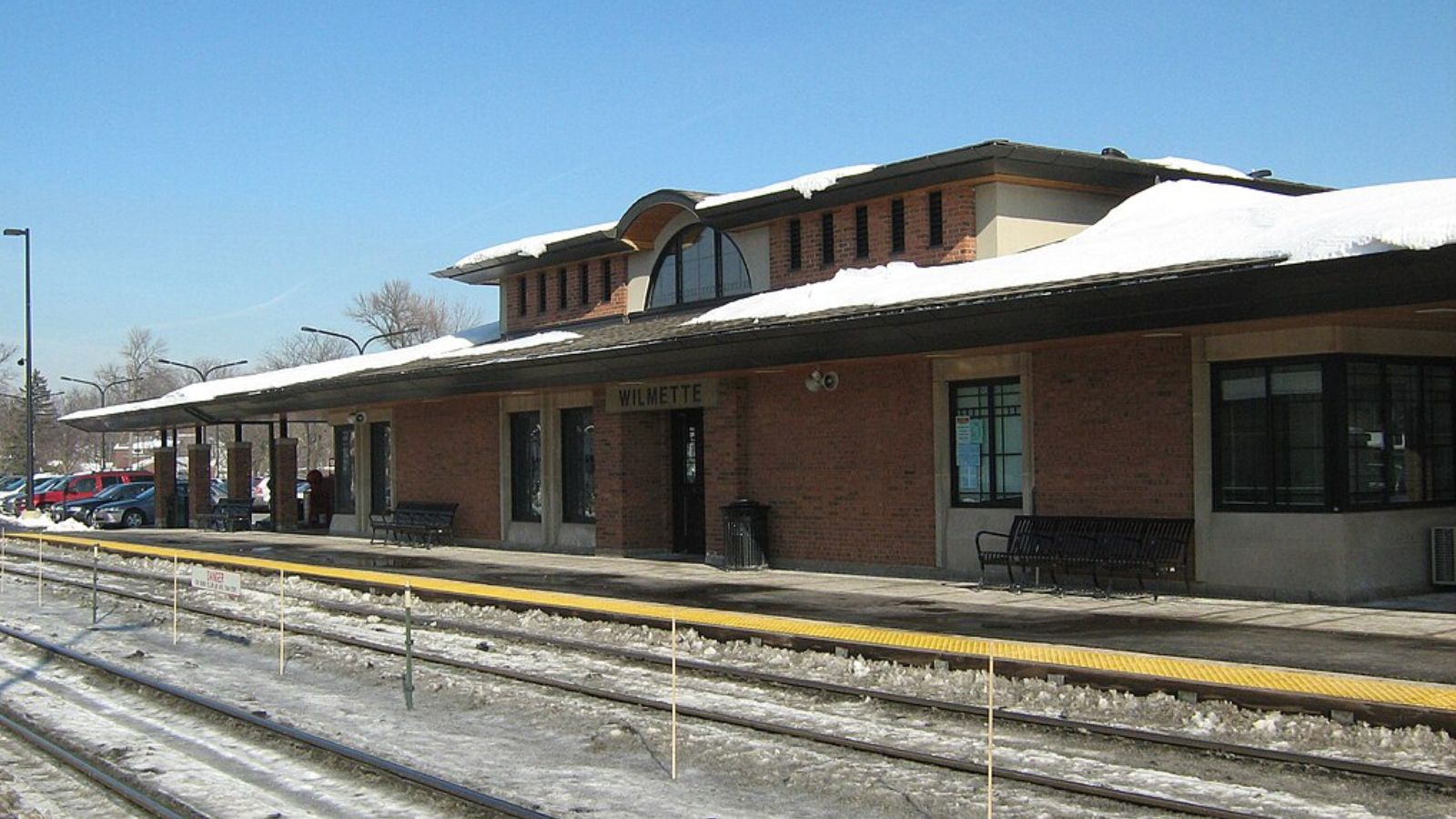
Why are people willing to pay so much to live here? What’s special about it?
Wilmette combines North Shore prestige with family-friendly amenities including lakefront beaches, excellent schools, and walkable neighborhoods. The village offers diverse housing options from historic homes to contemporary estates, all within a community known for civic engagement and cultural sophistication. Residents appreciate convenient CTA and Metra access to Chicago while enjoying suburban tranquility and recreational facilities.
The community’s lakefront location provides beaches, parks, and recreational opportunities that enhance quality of life beyond typical suburban offerings. Tree-lined streets, historic architecture, and vibrant commercial districts create appealing environment for professionals and families. This combination of location, amenities, and community character supports sustained property value appreciation among discerning buyers.
How Wilmette Rose to Prominence
Wilmette was established in 1872 with the arrival of railroad service that made commuting to Chicago practical for suburban residents. Early development attracted Chicago professionals seeking lakefront living with convenient transportation access. The community incorporated in 1872 and grew steadily through strategic planning that preserved lakefront access while accommodating residential growth.
The establishment of Northwestern University in nearby Evanston added intellectual character while maintaining Wilmette’s residential focus. Post-World War II suburban expansion brought significant development while preserving historic neighborhoods and environmental amenities. Modern Wilmette represents successful balance between growth and preservation that maintains North Shore character while providing contemporary suburban amenities.
3 Interesting Tidbits
1. Bahá’í Temple – The stunning Bahá’í House of Worship, completed in 1953, serves as a distinctive architectural landmark and spiritual center that attracts visitors from around the world.
2. Beach Access – Wilmette maintains multiple Lake Michigan beaches and parks that provide residents with swimming, boating, and recreational opportunities typically unavailable in suburban communities.
3. Green Bay Trail – This former railroad corridor now serves as a popular biking and walking trail connecting Wilmette to other North Shore communities and Chicago.
13. Long Grove – 48% Home Price Increase Since 2010
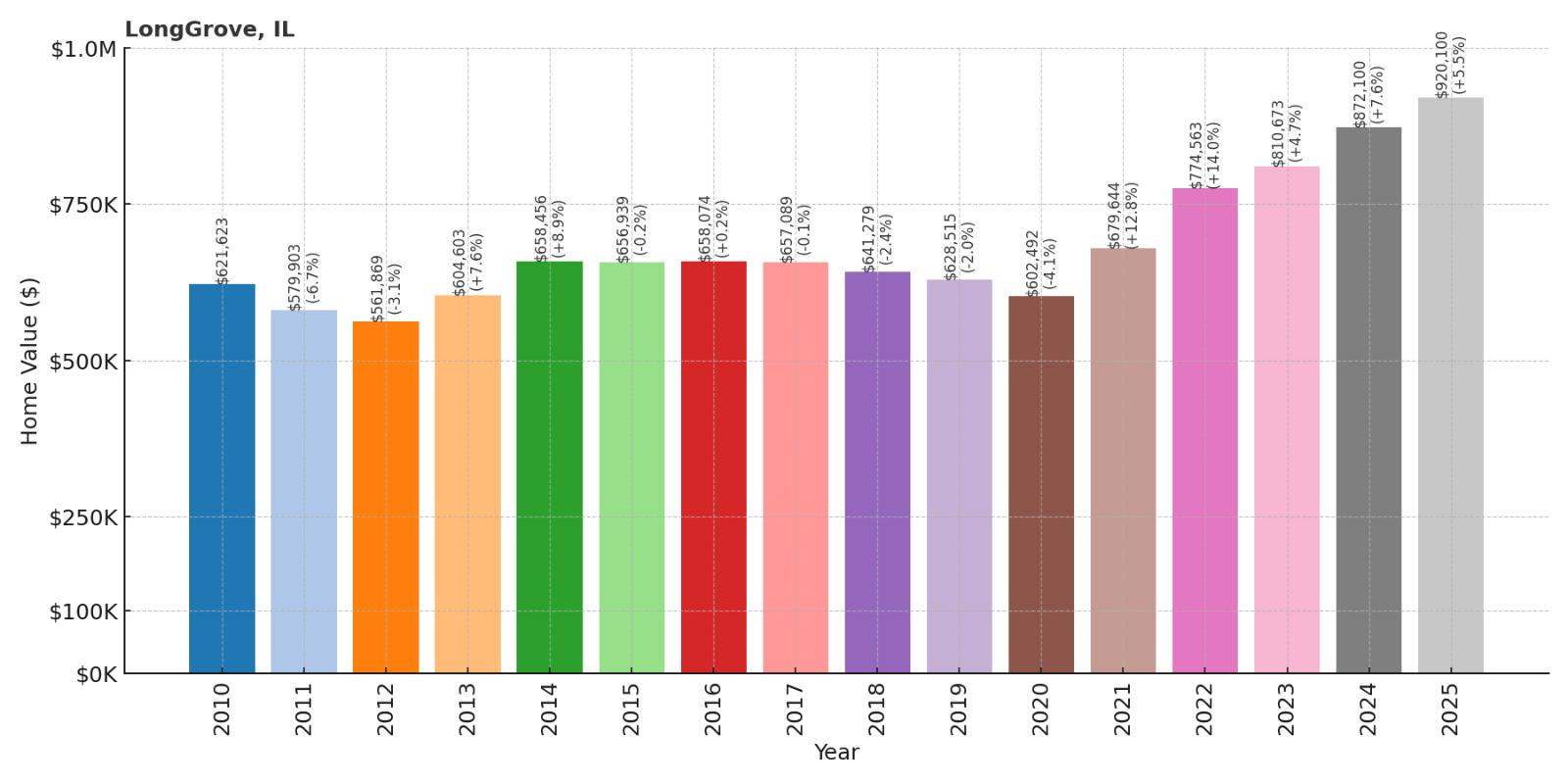
- 2010: $621,623
- 2011: $579,903
- 2012: $561,869
- 2013: $604,603
- 2014: $658,456
- 2015: $656,939
- 2016: $658,074
- 2017: $657,089
- 2018: $641,279
- 2019: $628,515
- 2020: $602,492
- 2021: $679,644
- 2022: $774,563
- 2023: $810,673
- 2024: $872,100
- 2025: $920,100
Long Grove maintained relatively stable values through extended periods, showing resilience during market downturns with consistent performance around $650,000 from 2014-2020. Recent appreciation has been dramatic, with 53% growth since 2020 bringing median prices to $920,100. This performance reflects strong demand for historic village character combined with luxury amenities.
Why Long Grove?
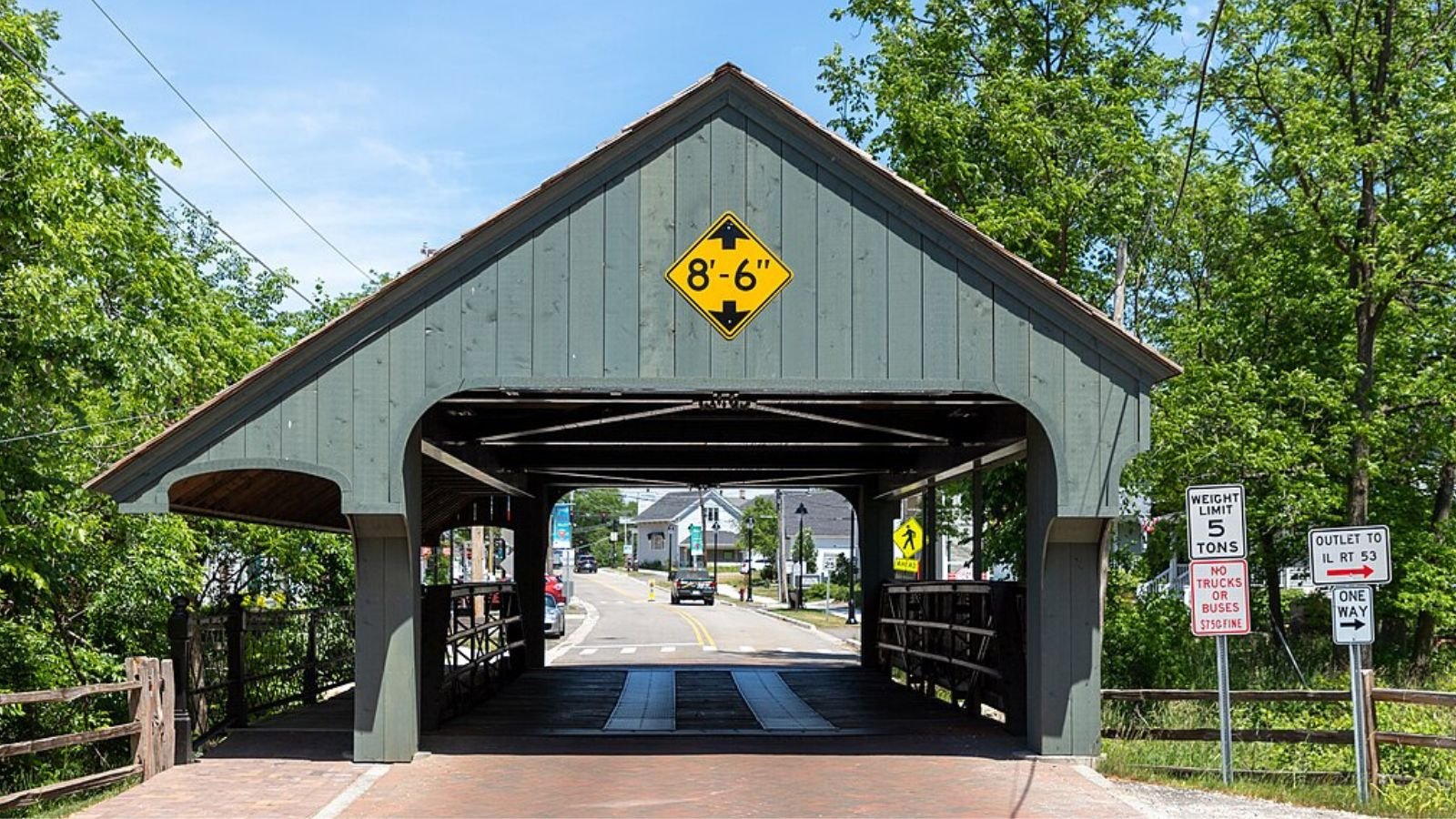
Why are people willing to pay so much to live here? What’s special about it?
Long Grove attracts affluent buyers seeking unique village character with historic charm and modern luxury amenities. The community features the iconic covered bridge, quaint downtown shops, and frequent festivals that create small-town atmosphere while offering upscale homes on large wooded lots. Residents value the preservation of rural character, excellent schools, and convenient access to major employment centers.
The village’s strict development standards protect historic architecture and natural features while supporting custom home construction on spacious properties. Many homes feature luxury amenities and unique architectural details that reflect the community’s commitment to quality and character. This combination of authenticity, exclusivity, and modern convenience supports premium property values among buyers seeking distinctive suburban living.
How Long Grove Rose to Prominence
Long Grove was settled in the 1840s by German immigrants who established farms and small businesses in what became a thriving agricultural community. The village maintained its rural character through the early and mid-20th century while surrounding areas experienced typical suburban development. Community leaders made deliberate decisions to preserve historic buildings and rural atmosphere.
In the 1960s and 1970s, Long Grove embraced historic preservation and tourism, transforming old farm buildings into specialty shops and restaurants that attracted visitors while maintaining residential character. This strategy created unique appeal that attracted affluent families seeking authentic village living with modern amenities. Modern Long Grove represents successful preservation-based development that maintains historic character while supporting luxury residential growth.
3 Interesting Tidbits
1. Covered Bridge – Long Grove’s iconic covered bridge, built in 1906, serves as the community’s symbol and hosts the annual Covered Bridge Festival that attracts thousands of visitors.
2. Apple Heritage – The village celebrates its agricultural past with annual Apple Fest and maintains historic orchards that provide authentic rural character in a suburban setting.
3. Historic Preservation – Long Grove was among the first Chicago-area communities to implement comprehensive historic preservation ordinances that protect architectural character while allowing sensitive development.
12. Oak Brook – 42% Home Price Increase Since 2010
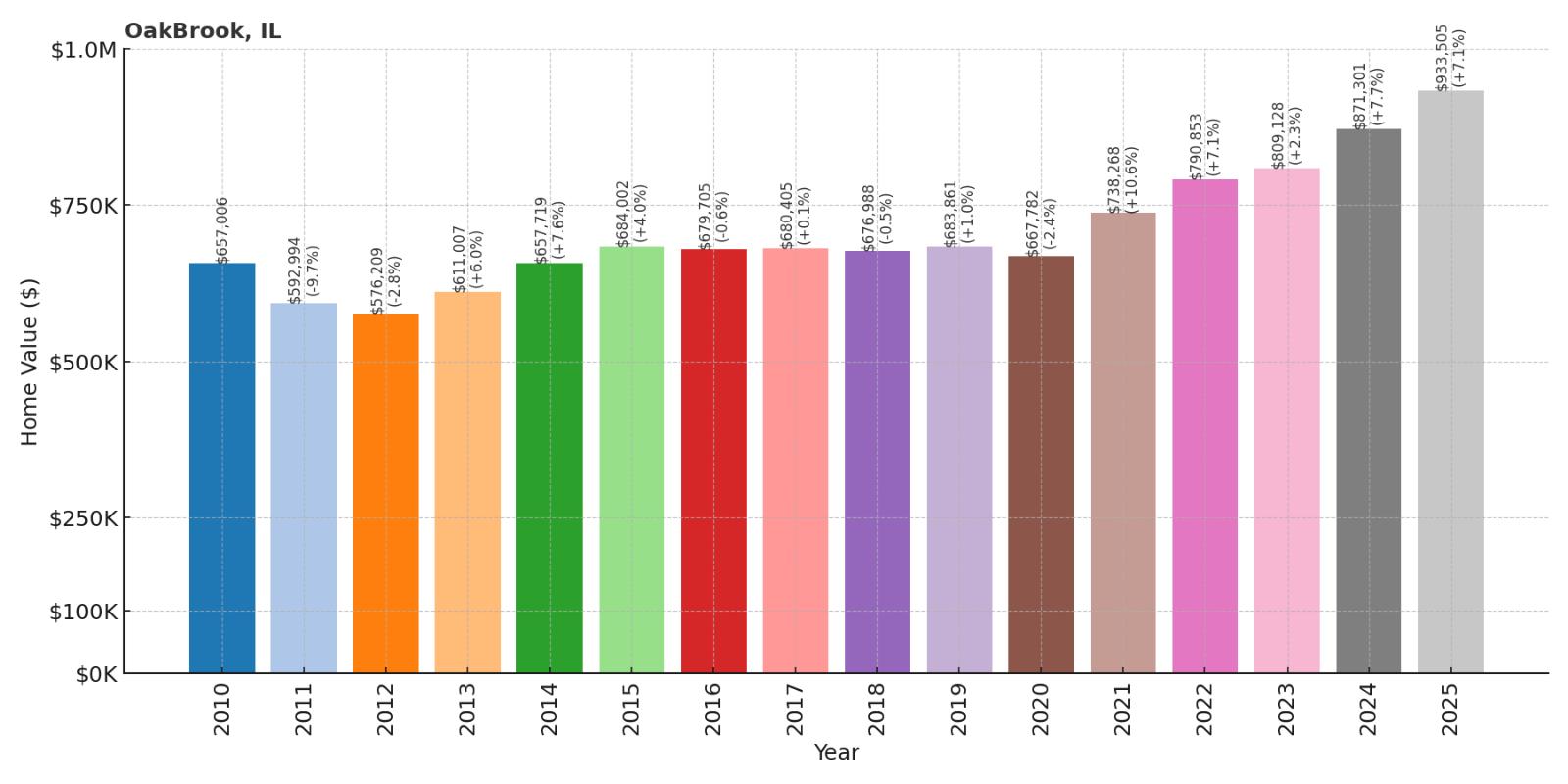
- 2010: $657,006
- 2011: $592,994
- 2012: $576,209
- 2013: $611,007
- 2014: $657,719
- 2015: $684,002
- 2016: $679,705
- 2017: $680,405
- 2018: $676,988
- 2019: $683,861
- 2020: $667,782
- 2021: $738,268
- 2022: $790,853
- 2023: $809,128
- 2024: $871,301
- 2025: $933,505
Oak Brook demonstrated remarkable stability starting from a high base above $657,000, maintaining values near $680,000 through extended periods from 2015-2020. Recent appreciation has been strong, with 40% growth since 2020 bringing median values to $933,505. This performance reflects sustained appeal of established corporate suburbs with luxury amenities.
Why Oak Brook?
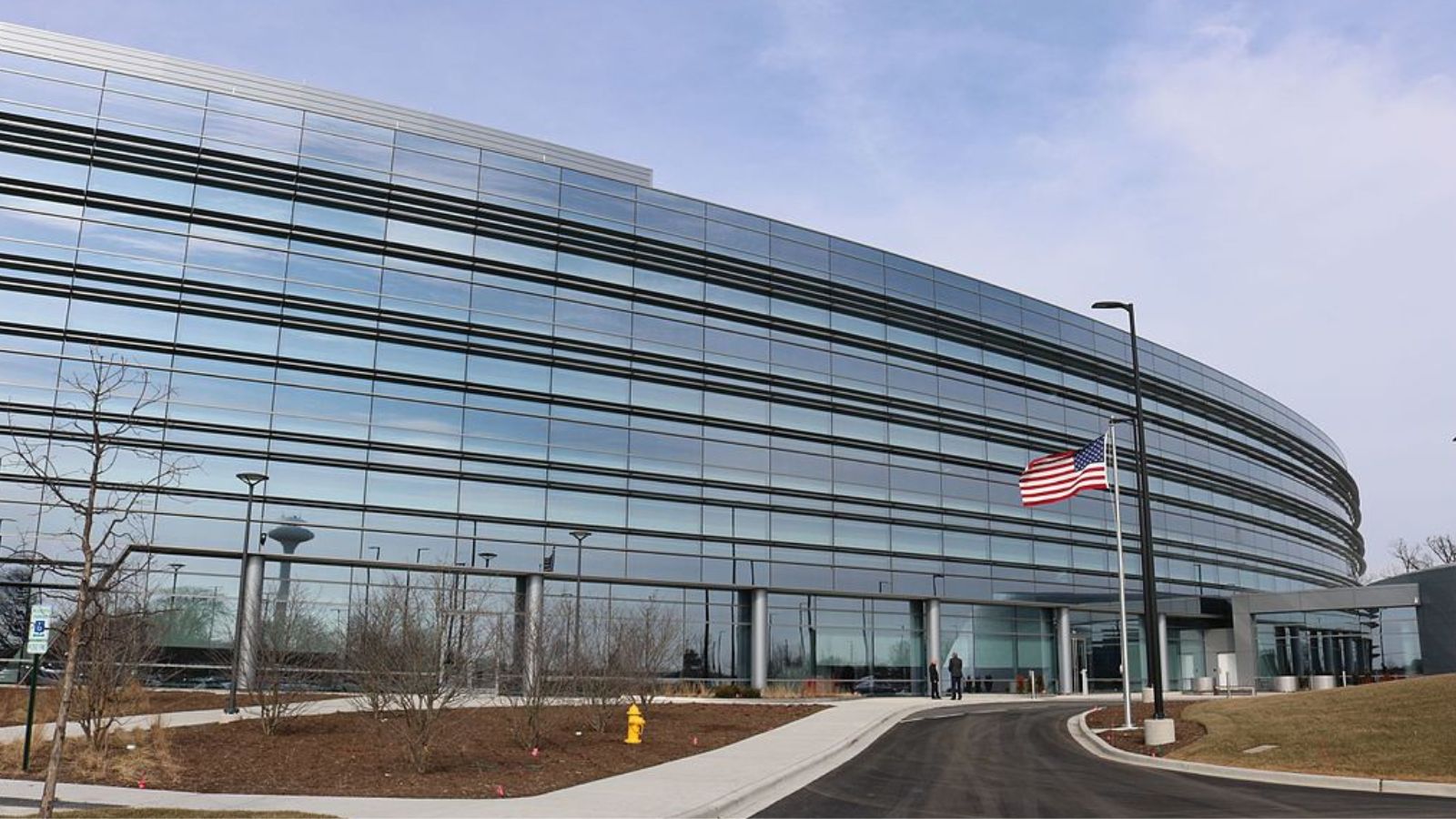
Why are people willing to pay so much to live here? What’s special about it?
Oak Brook appeals to corporate executives and affluent professionals seeking luxury living in a business-friendly environment with world-class amenities. The village hosts numerous Fortune 500 headquarters while maintaining exclusive residential neighborhoods with custom homes and golf course access. Residents appreciate the combination of career opportunities, upscale shopping and dining, and recreational facilities all within the same community.
The community’s master-planned development integrates residential, commercial, and recreational uses while preserving open space and environmental quality. Access to private clubs, forest preserves, and premium services creates quality of life that justifies high housing costs. This unique blend of business district amenities and luxury residential character supports sustained property value appreciation.
How Oak Brook Rose to Prominence
Oak Brook was developed in the 1960s as a master-planned community designed to attract major corporations seeking suburban headquarters locations with executive housing nearby. Early planners integrated office parks, residential neighborhoods, and recreational amenities to create a comprehensive business and living environment.
The successful attraction of Fortune 500 companies including McDonald’s Corporation established Oak Brook as a major corporate center while supporting luxury residential development for executives. Strategic planning preserved open space while accommodating both commercial and residential growth. Modern Oak Brook represents successful integration of business and residential development that creates unique appeal for affluent professionals.
3 Interesting Tidbits
1. Corporate Capital – Oak Brook hosts headquarters for major corporations including McDonald’s, Ace Hardware, and Federal Signal, creating one of the Midwest’s premier corporate concentrations.
2. Polo Heritage – Oak Brook Polo Club has operated since 1922 and continues to host international competitions, adding distinctive recreational and social amenities.
3. Master Planning – The village was among the first planned communities to successfully integrate corporate headquarters, luxury housing, and recreational amenities in a cohesive environment.
11. Riverwoods – 47% Home Price Increase Since 2010
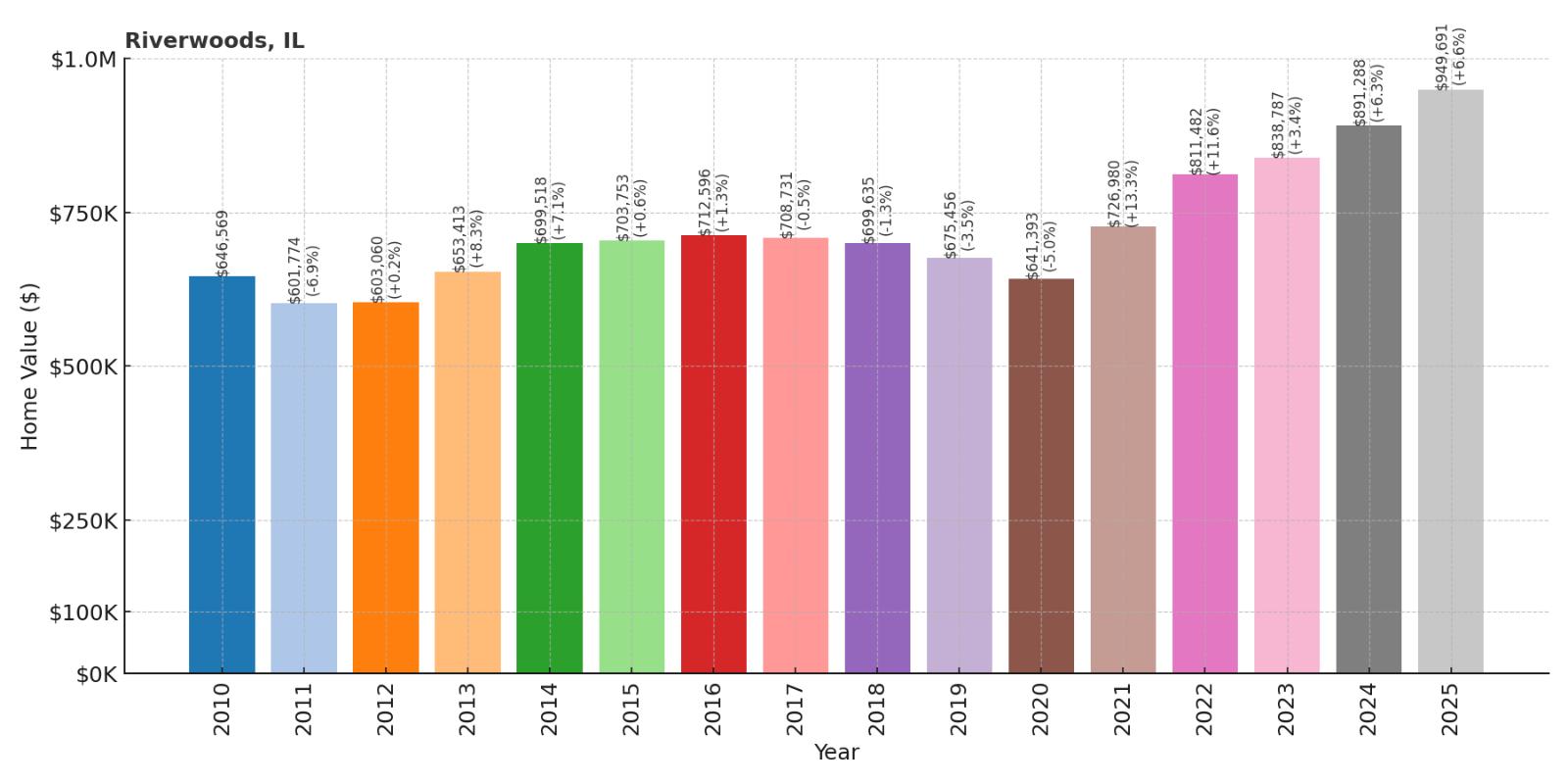
- 2010: $646,569
- 2011: $601,774
- 2012: $603,060
- 2013: $653,413
- 2014: $699,518
- 2015: $703,753
- 2016: $712,596
- 2017: $708,731
- 2018: $699,635
- 2019: $675,456
- 2020: $641,393
- 2021: $726,980
- 2022: $811,482
- 2023: $838,787
- 2024: $891,288
- 2025: $949,691
Riverwoods showed steady appreciation through 2016 before experiencing typical luxury market softening through 2020. Recent growth has been exceptional, with 48% appreciation since pandemic lows bringing current values to $949,691. This performance demonstrates continued appeal of exclusive Lake County communities with forest preserve access and luxury amenities.
Why Riverwoods?
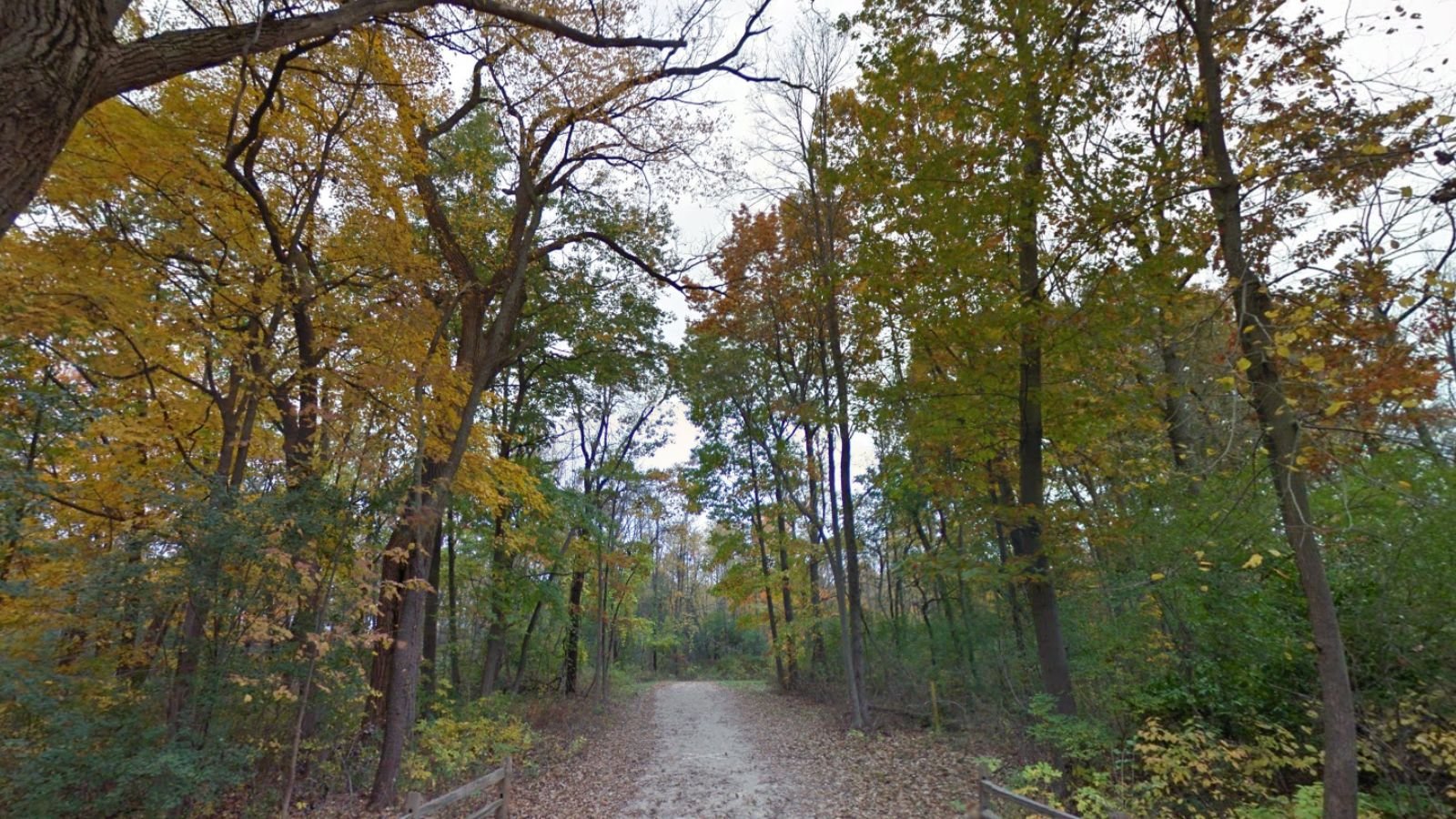
Why are people willing to pay so much to live here? What’s special about it?
Riverwoods attracts affluent buyers seeking luxury homes in a heavily wooded environment that provides privacy and natural beauty while maintaining convenient access to major employment centers. The village features custom-built homes on large lots with mature forests and rolling terrain that creates exclusive residential character. Residents value the environmental preservation, low crime rates, and proximity to recreational facilities including golf courses and forest preserves.
The community’s development standards require preservation of natural features while supporting luxury home construction with architectural variety and quality. Many properties include premium amenities and custom design elements that cater to discerning buyers. This combination of natural beauty, exclusivity, and convenience supports premium property values among high-end purchasers seeking sophisticated suburban living.
How Riverwoods Rose to Prominence
Riverwoods incorporated in 1959 as suburban development expanded into Lake County’s forested areas along the Des Plaines River. Early planning emphasized environmental preservation and low-density development that attracted affluent families seeking spacious properties with natural amenities. The village established strict zoning that maintained rural character while accommodating luxury residential development.
Strategic location between Chicago and Milwaukee provided convenient access to multiple employment centers while preserving forest character through careful development standards. The community’s emphasis on environmental quality and architectural standards established its reputation for exclusive suburban living. Modern Riverwoods represents successful balance between development and conservation that maintains natural appeal while supporting luxury residential growth.
3 Interesting Tidbits
1. Forest Sanctuary – Village ordinances require preservation of mature oak and maple forests, maintaining over 60% tree coverage that creates one of the most heavily wooded communities in the Chicago area.
2. River Access – The Des Plaines River borders the village, providing water recreation opportunities and additional natural amenities that enhance residential appeal.
3. Wildlife Habitat – Extensive forest preservation supports diverse wildlife including deer, foxes, and numerous bird species that create natural suburban environment unusual in metropolitan areas.
10. Mettawa – 50% Home Price Increase Since 2010

- 2010: $634,558
- 2011: $600,162
- 2012: $587,011
- 2013: $625,434
- 2014: $678,072
- 2015: $684,131
- 2016: $680,914
- 2017: $674,357
- 2018: $671,536
- 2019: $658,036
- 2020: $627,188
- 2021: $724,732
- 2022: $820,865
- 2023: $843,790
- 2024: $890,598
- 2025: $951,560
Mettawa reached peak values around 2015 before experiencing gradual decline through 2020, following typical luxury market patterns. Recent appreciation has been significant, with 52% growth since pandemic lows bringing current values to $951,560. This performance reflects strong demand for exclusive Lake County properties with equestrian facilities and forest preserve access.
Why Mettawa?
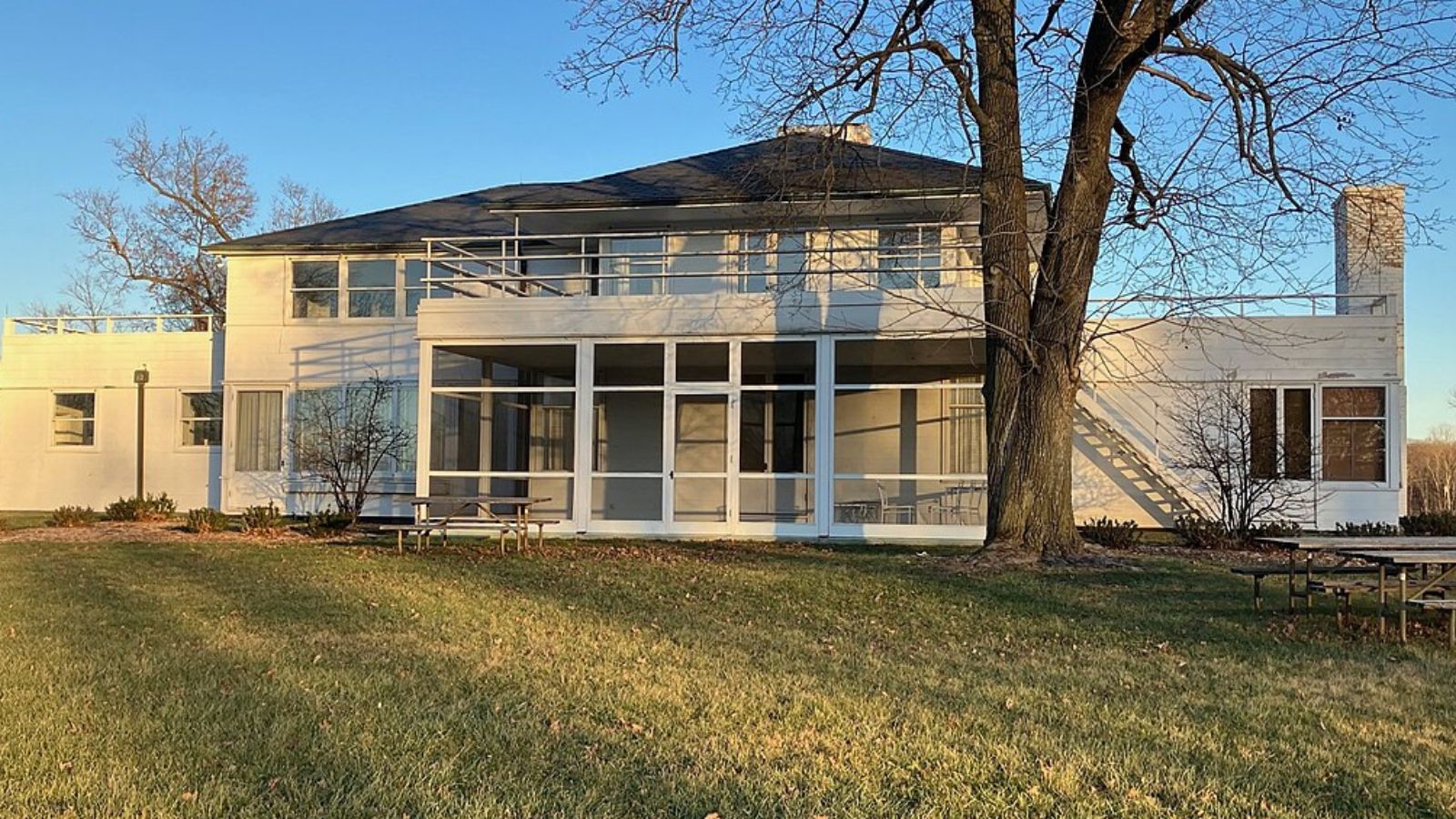
Why are people willing to pay so much to live here? What’s special about it?
Mettawa attracts affluent buyers seeking estate-style living with equestrian facilities and extensive natural amenities in a carefully preserved rural environment. The village features custom homes on large wooded lots, many with horse facilities and riding trails that connect to forest preserves. Residents value the exclusive character, environmental preservation, and recreational opportunities while maintaining convenient access to corporate centers.
The community’s strict development standards protect forests and prairies while supporting luxury home construction with architectural variety and quality. Village amenities include riding trails, nature preserves, and recreational facilities that enhance quality of life beyond typical suburban offerings. This combination of exclusivity, natural beauty, and recreational amenities supports premium property values among discerning purchasers seeking unique suburban living.
How Mettawa Rose to Prominence
Mettawa incorporated in 1960 with the specific mission of preserving rural character and preventing typical suburban development in Lake County’s rolling terrain and forests. Early planners established large minimum lot sizes and environmental preservation requirements that attracted affluent families seeking country estate living with Chicago area access.
The village’s commitment to equestrian activities and environmental preservation created unique appeal that differentiated it from conventional suburbs. Strategic location between major employment centers provided convenient access while maintaining rural character through strict zoning and development standards. Modern Mettawa represents successful preservation-based development that maintains country character while supporting luxury residential growth.
3 Interesting Tidbits
1. Horse Capital – Mettawa maintains extensive equestrian facilities including over 20 miles of riding trails that connect private properties with forest preserves and neighboring communities.
2. Prairie Preservation – The village protects significant remnants of original Illinois prairie that provide educational opportunities and wildlife habitat within the suburban environment.
3. Conservation Mission – Mettawa was founded specifically to preserve rural character, making it one of the few Chicago-area communities where conservation was the primary development goal from incorporation.
9. Barrington Hills – 29% Home Price Increase Since 2010
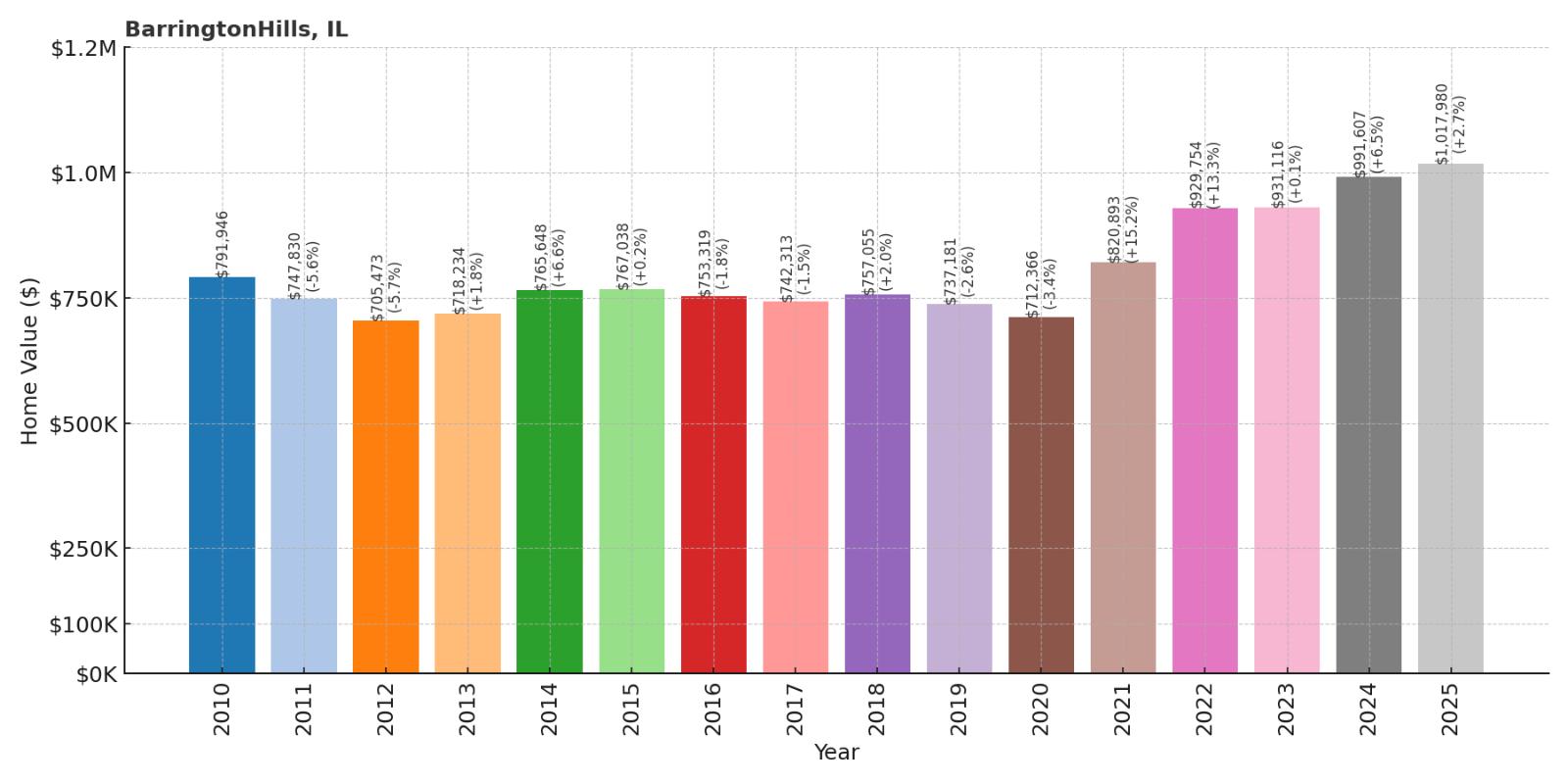
- 2010: $791,946
- 2011: $747,830
- 2012: $705,473
- 2013: $718,234
- 2014: $765,648
- 2015: $767,038
- 2016: $753,319
- 2017: $742,313
- 2018: $757,055
- 2019: $737,181
- 2020: $712,366
- 2021: $820,893
- 2022: $929,754
- 2023: $931,116
- 2024: $991,607
- 2025: $1,017,980
Barrington Hills showed modest appreciation from a high base near $800,000, with extended stability through 2020 despite starting from luxury price levels. Recent growth has accelerated significantly, with 43% appreciation since 2020 bringing current values above $1 million to $1,017,980. This performance reflects renewed strength in ultra-exclusive suburban markets with extensive acreage and equestrian amenities.
Why Barrington Hills?
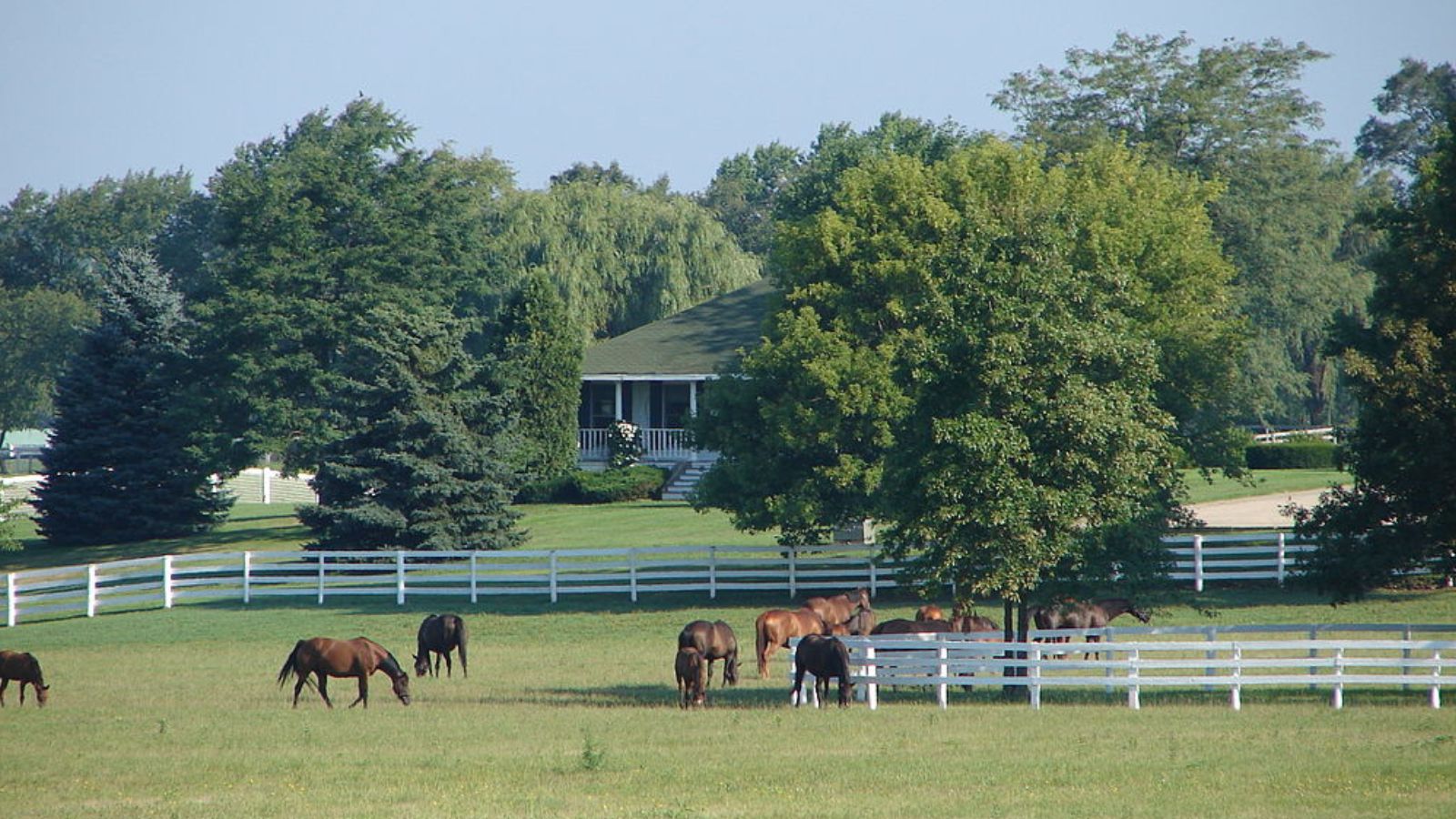
Why are people willing to pay so much to live here? What’s special about it?
Barrington Hills attracts ultra-affluent buyers seeking estate-style living on large acreage with equestrian facilities and complete privacy in a rural setting. The village requires minimum five-acre lots that ensure exclusivity and space for custom estates, horse facilities, and extensive landscaping. Residents value the rural character, environmental preservation, and recreational opportunities while maintaining reasonable access to Chicago and suburban employment centers.
The community’s unique zoning protects agricultural character while supporting luxury home construction with no restrictions on lot coverage or architectural style. Many properties include working farms, extensive gardens, and recreational facilities that create country estate atmosphere. This combination of space, privacy, and rural amenities supports premium property values among buyers seeking ultimate suburban exclusivity.
How Barrington Hills Rose to Prominence
Barrington Hills incorporated in 1957 with the specific goal of preserving rural character through large-lot zoning that prevented typical suburban subdivision development. Early settlers were attracted by rolling terrain, mature forests, and agricultural land that provided space for country estates within commuting distance of Chicago.
The village’s five-acre minimum lot requirement created immediate exclusivity while preserving the agricultural and equestrian character that attracted affluent residents. Strategic location in the Barrington area provided convenient access to transportation and services while maintaining rural isolation. Modern Barrington Hills represents successful rural preservation that creates unique appeal for ultra-affluent households seeking maximum space and privacy.
3 Interesting Tidbits
1. Five-Acre Minimum – Village zoning requires minimum five-acre lots, creating one of the most exclusive residential environments in the Chicago metropolitan area with guaranteed space and privacy.
2. Equestrian Paradise – Extensive horse facilities and riding trails throughout the village support a thriving equestrian community with competitions, shows, and recreational riding opportunities.
3. Celebrity Haven – The village’s privacy and exclusivity have attracted numerous celebrities and business leaders seeking secluded luxury living within the Chicago area.
8. South Barrington – 22% Home Price Increase Since 2010
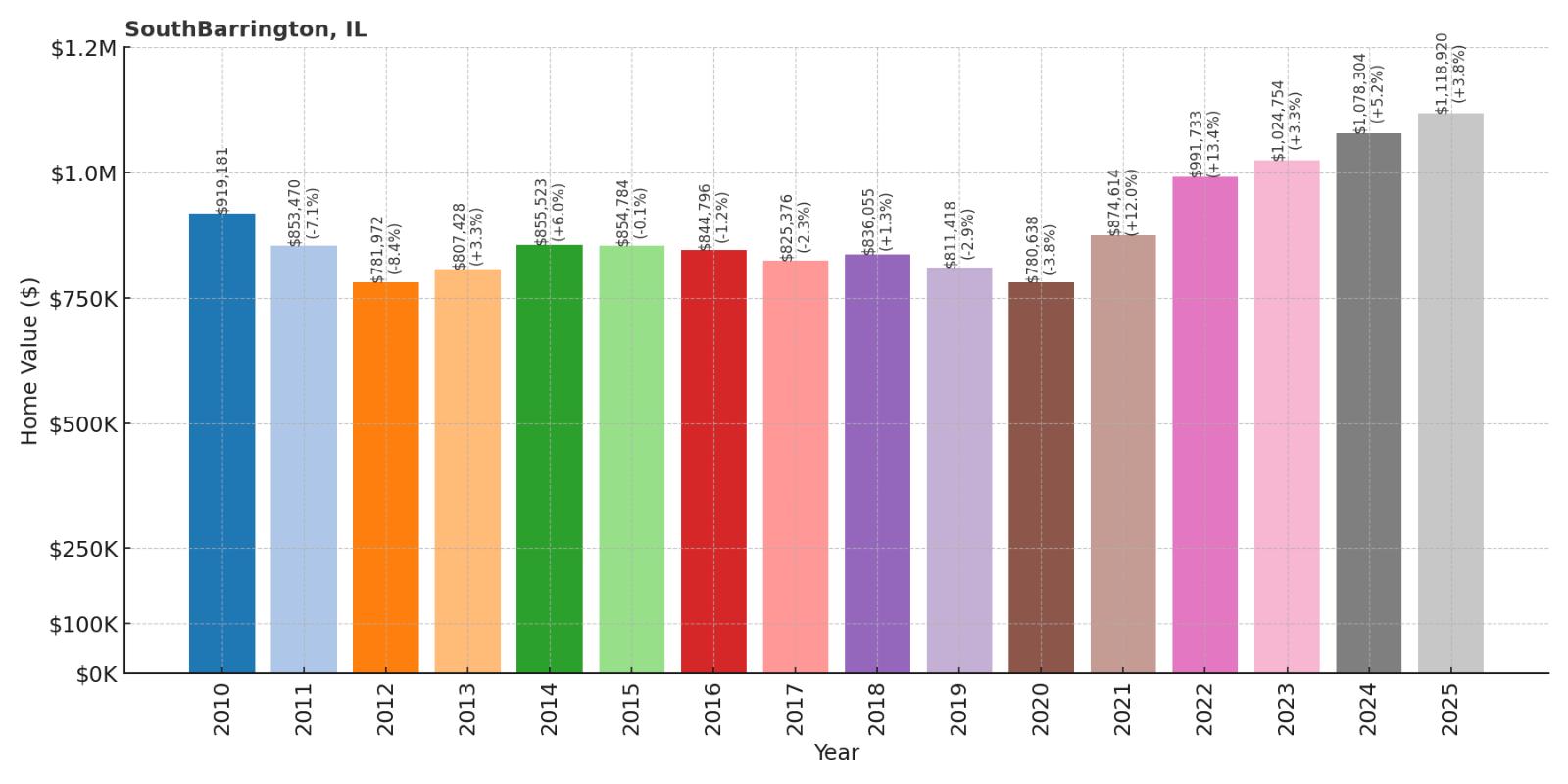
- 2010: $919,181
- 2011: $853,470
- 2012: $781,972
- 2013: $807,428
- 2014: $855,523
- 2015: $854,784
- 2016: $844,796
- 2017: $825,376
- 2018: $836,055
- 2019: $811,418
- 2020: $780,638
- 2021: $874,614
- 2022: $991,733
- 2023: $1,024,754
- 2024: $1,078,304
- 2025: $1,118,920
South Barrington started from the highest base values in 2010 above $900,000 but experienced extended softening through 2020, reflecting luxury market challenges during that period. Recent appreciation has been dramatic, with 43% growth since pandemic lows bringing current values to $1,118,920. This performance demonstrates resilient demand for ultra-luxury suburban properties with comprehensive amenities.
Why South Barrington?
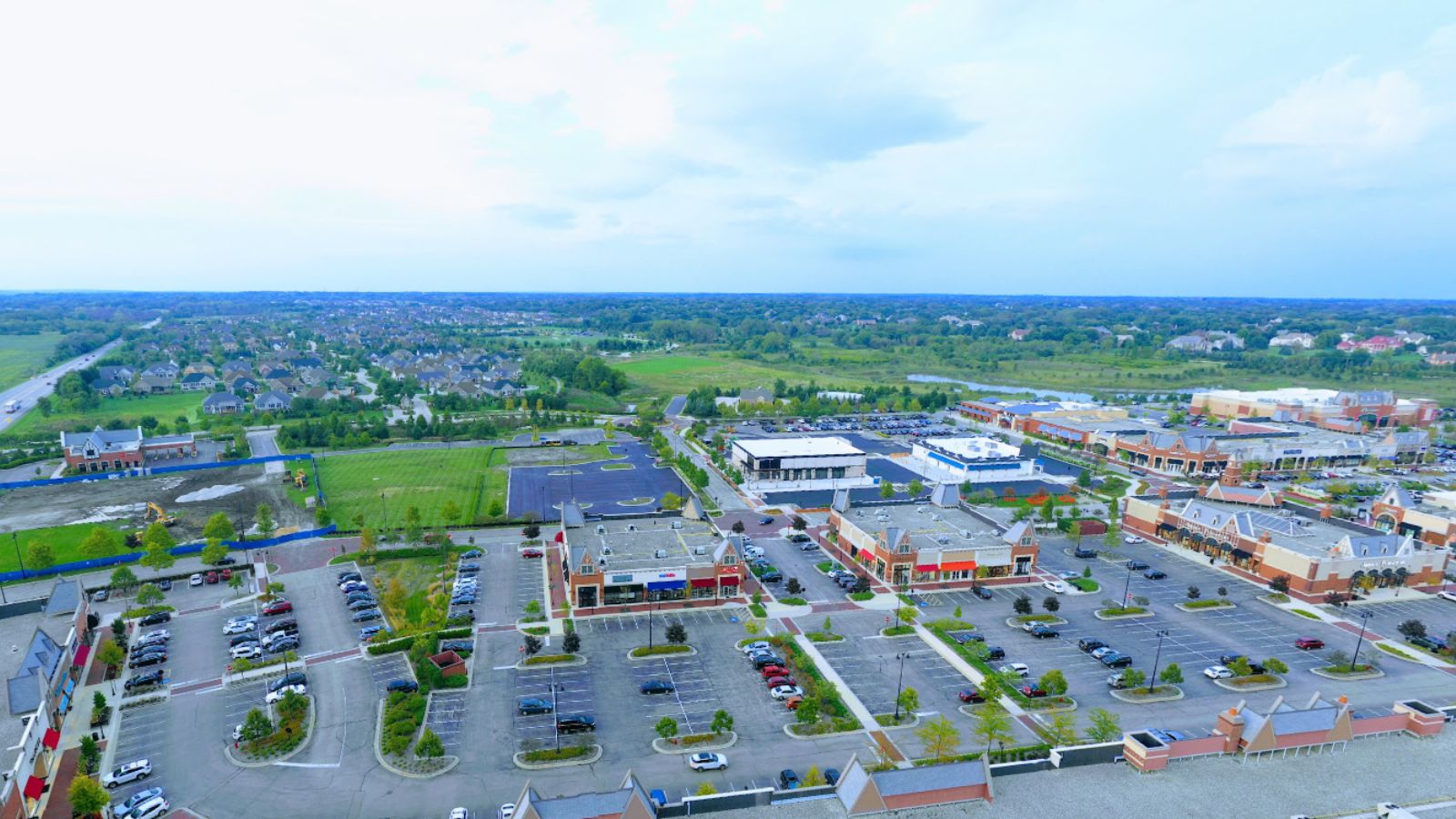
Why are people willing to pay so much to live here? What’s special about it?
South Barrington appeals to ultra-affluent buyers seeking luxury estates with golf course access, equestrian facilities, and comprehensive recreational amenities in an exclusive planned community. The village features custom-built homes on large lots with premium finishes and architectural variety that cater to discerning tastes. Residents value the country club atmosphere, privacy, and convenient access to major corporate centers while enjoying resort-style living.
The community’s master-planned development integrates residential neighborhoods with recreational facilities including golf courses, riding trails, and nature preserves. Access to private clubs and premium services creates lifestyle amenities that justify ultra-luxury pricing. This combination of exclusivity, recreation, and convenience supports sustained property value appreciation among the most affluent suburban buyers.
How South Barrington Rose to Prominence
South Barrington was developed beginning in the 1970s as a master-planned luxury community designed to attract corporate executives and affluent professionals seeking country club living with Chicago area access. Early development centered around golf courses and equestrian facilities that established the community’s recreational and luxury character.
Strategic location in Cook County’s northwest suburbs provided convenient access to major employment centers while maintaining exclusive character through careful planning and premium amenities. The community’s emphasis on recreational facilities and architectural quality attracted ultra-affluent households seeking comprehensive luxury suburban living. Modern South Barrington represents successful luxury community development that integrates residential excellence with resort-style amenities.
3 Interesting Tidbits
1. Golf Excellence – The community features multiple championship golf courses including Makray Memorial Golf Club, which has hosted professional tournaments and provides world-class recreational amenities.
2. Planned Luxury – South Barrington was among the first Chicago-area communities designed comprehensively as a luxury residential environment with integrated recreational and natural amenities.
3. Corporate Convenience – The village’s location provides convenient access to Schaumburg’s corporate corridor while maintaining rural character and exclusive residential amenities.
7. Lake Forest – 40% Home Price Increase Since 2010
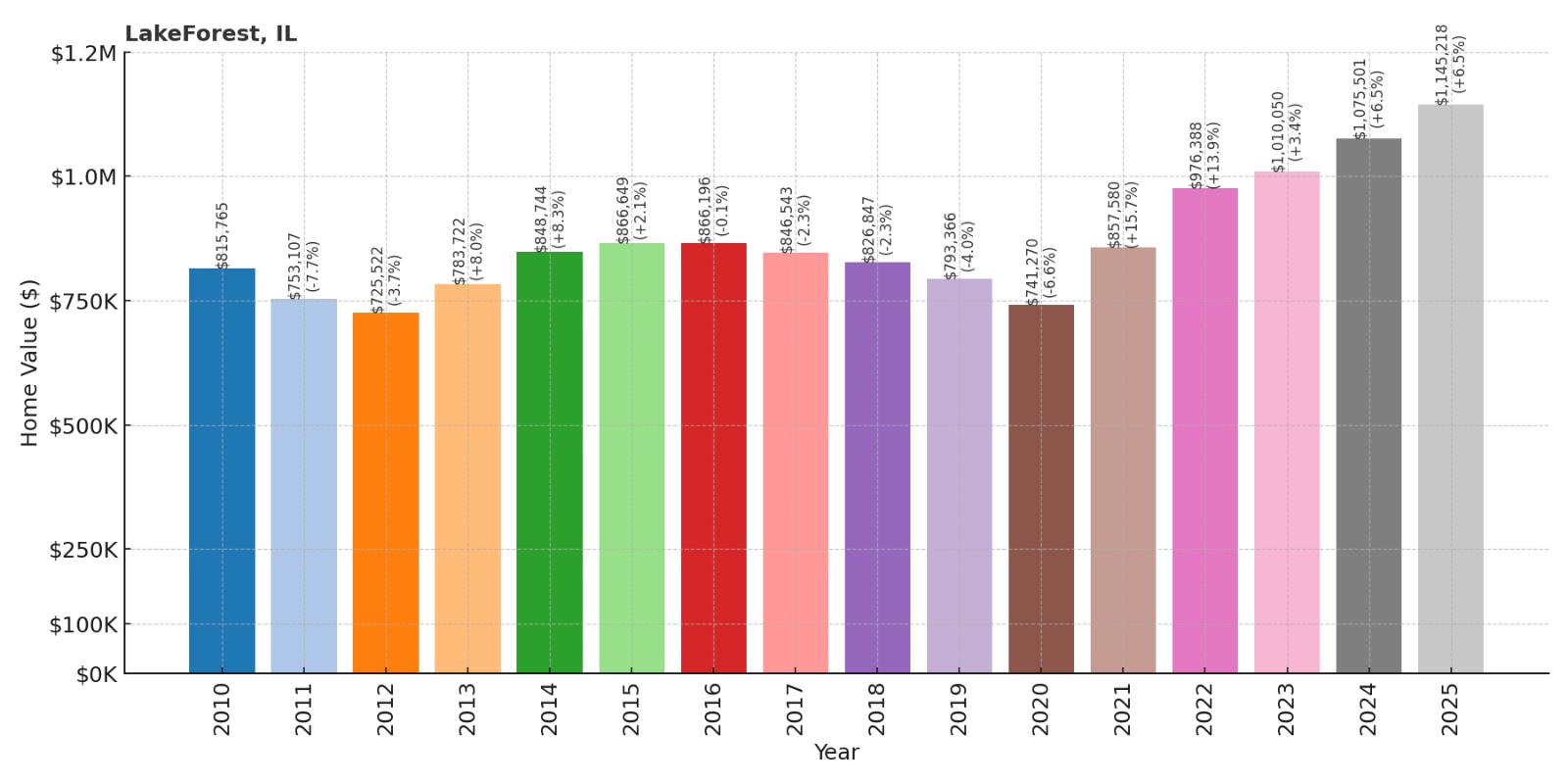
- 2010: $815,765
- 2011: $753,107
- 2012: $725,522
- 2013: $783,722
- 2014: $848,744
- 2015: $866,649
- 2016: $866,196
- 2017: $846,543
- 2018: $826,847
- 2019: $793,366
- 2020: $741,270
- 2021: $857,580
- 2022: $976,388
- 2023: $1,010,050
- 2024: $1,075,501
- 2025: $1,145,218
Lake Forest experienced significant appreciation through 2016 reaching $866,000 before gradual decline through 2020 to $741,270, reflecting broader luxury market trends. Recent recovery has been exceptional, with 54% growth since pandemic lows bringing current values to $1,145,218. This performance demonstrates the enduring appeal of premier North Shore communities with lakefront access and historic character.
Why Lake Forest?
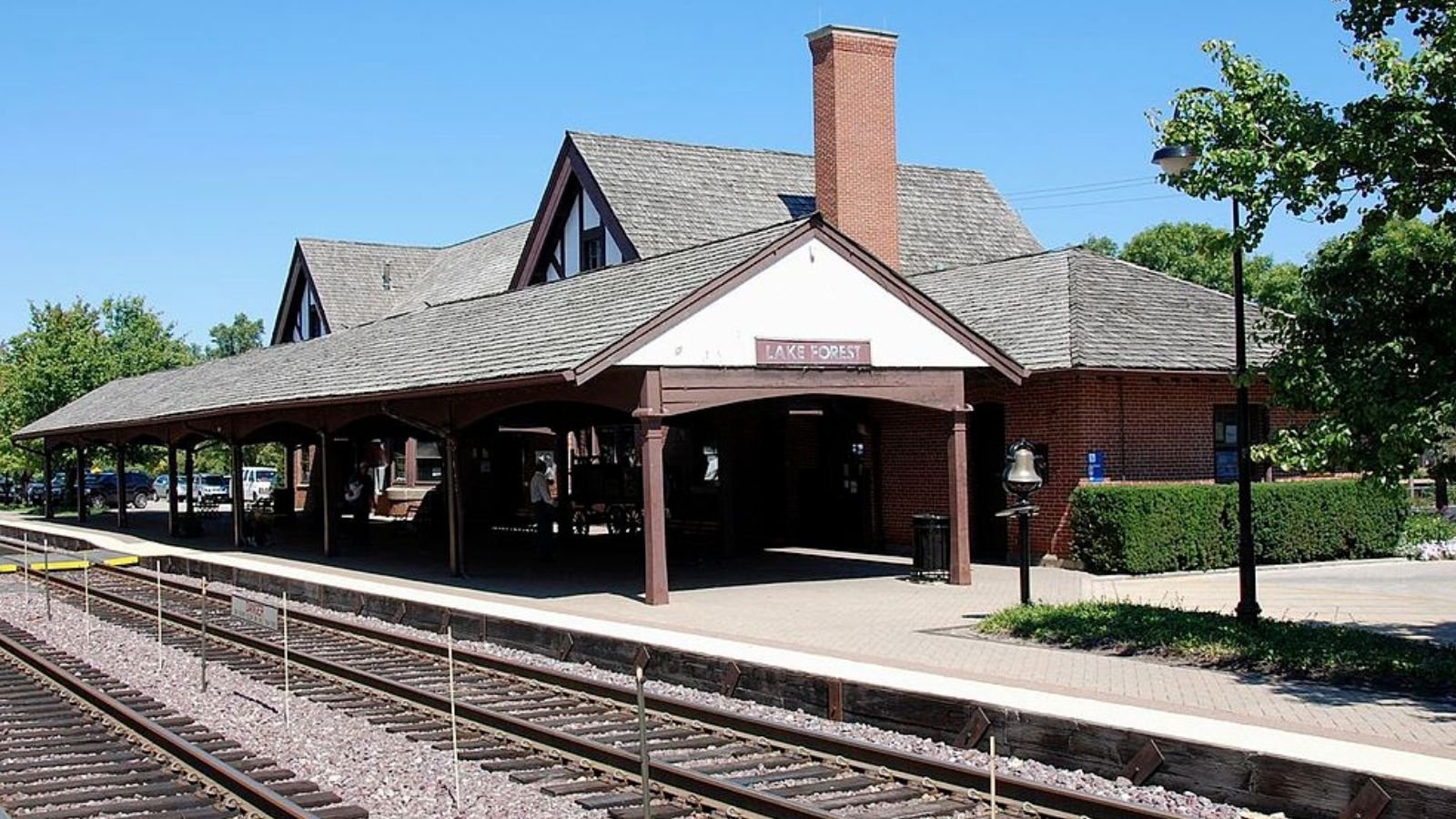
Why are people willing to pay so much to live here? What’s special about it?
Lake Forest attracts ultra-affluent buyers seeking the pinnacle of North Shore living with direct Lake Michigan access, historic estates, and cultural sophistication. The city offers magnificent lakefront properties, excellent private and public schools, and walkable downtown districts with upscale shopping and dining. Residents value the combination of natural beauty, architectural significance, and convenient transportation access to Chicago while maintaining exclusive suburban character.
The community’s strict historic preservation standards protect architectural heritage while supporting luxury home construction and renovation. Many properties feature historic significance, mature landscaping, and lakefront access that creates unique appeal. This combination of location, heritage, and exclusivity supports sustained property value appreciation among the most discerning suburban buyers seeking prestigious addresses.
How Lake Forest Rose to Prominence
Lake Forest was founded in 1857 as a planned community by Chicago businessmen seeking to create an ideal suburban environment with natural beauty and cultural amenities. Early planners emphasized architectural quality, environmental preservation, and educational institutions that established the community’s prestigious character. The arrival of railroad service made commuting to Chicago practical for affluent residents.
The establishment of Lake Forest University and the development of significant estates by Chicago’s industrial leaders created lasting institutional and architectural foundations. Post-World War II development expanded the community while preserving historic neighborhoods and lakefront access. Modern Lake Forest represents successful balance between historic preservation and contemporary luxury that maintains North Shore preeminence among exclusive suburban communities.
3 Interesting Tidbits
1. University Town – Lake Forest University, founded in 1857, adds intellectual character and cultural amenities while providing educational opportunities that enhance community appeal.
2. Architectural Heritage – The city contains numerous historic estates designed by prominent architects including David Adler and Howard Van Doren Shaw, creating one of America’s finest collections of residential architecture.
3. Ravine System – Natural ravines throughout the city provide scenic beauty and environmental diversity while creating unique topography that enhances property appeal and preserves natural character.
6. Hinsdale – 31% Home Price Increase Since 2010
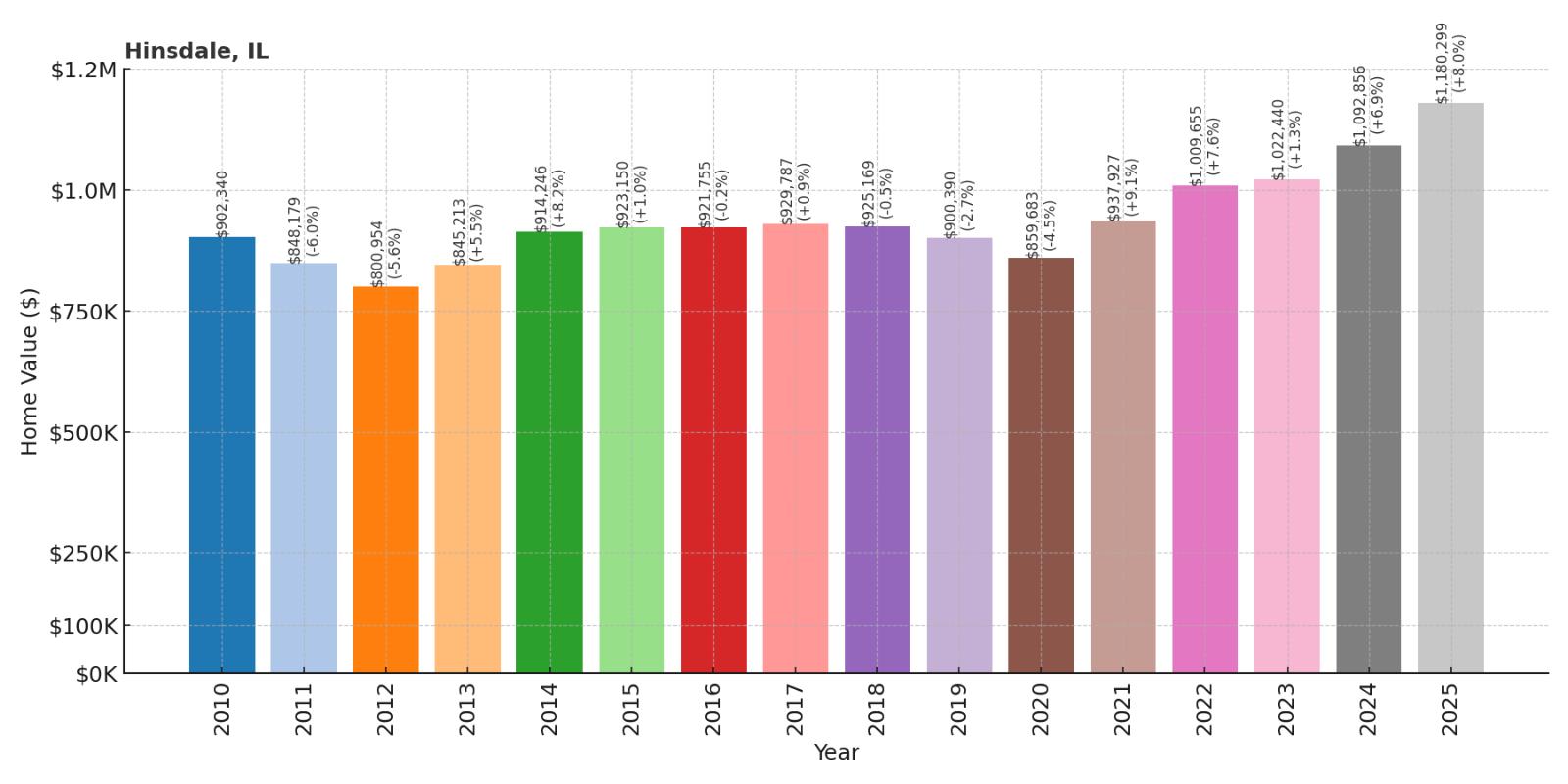
- 2010: $902,340
- 2011: $848,179
- 2012: $800,954
- 2013: $845,213
- 2014: $914,246
- 2015: $923,150
- 2016: $921,755
- 2017: $929,787
- 2018: $925,169
- 2019: $900,390
- 2020: $859,683
- 2021: $937,927
- 2022: $1,009,655
- 2023: $1,022,440
- 2024: $1,092,856
- 2025: $1,180,299
Hinsdale demonstrated remarkable stability starting from a high base above $900,000, maintaining values near that level through most periods despite market fluctuations. Recent appreciation has accelerated, with 37% growth since 2020 bringing current values to $1,180,299. This performance reflects sustained demand for established western suburbs with historic character and excellent amenities.
Why Hinsdale?
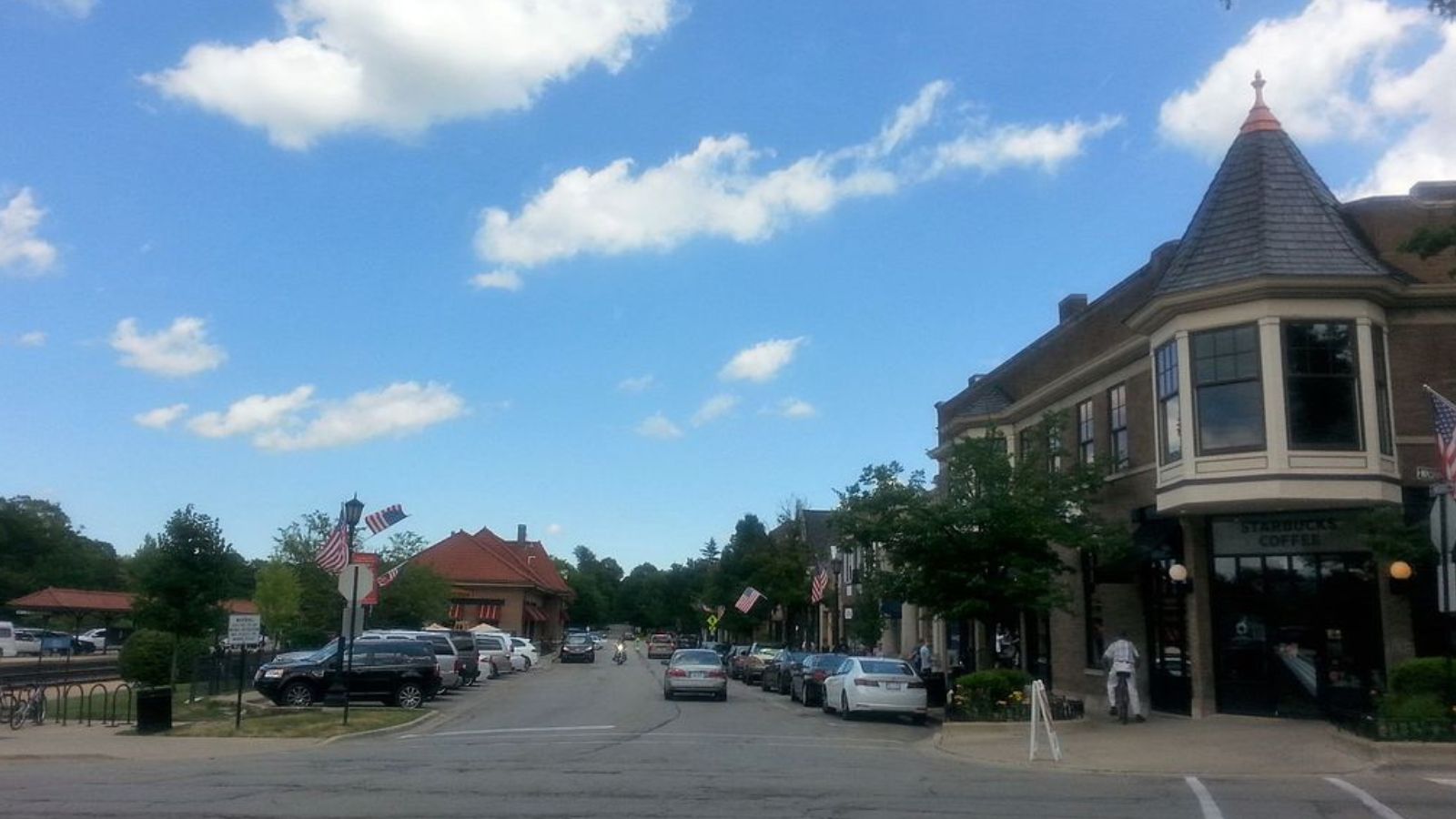
Why are people willing to pay so much to live here? What’s special about it?
Hinsdale attracts affluent families seeking historic charm in a walkable community with excellent schools, convenient transportation, and upscale amenities. The village features tree-lined streets, diverse architectural styles, and a vibrant downtown district that creates sophisticated small-town character while maintaining easy access to Chicago. Residents appreciate the balance of suburban tranquility and urban convenience, plus strong community engagement and cultural activities.
The community’s compact layout encourages walking and social interaction while providing quality shopping, dining, and services within the village. Historic neighborhoods offer varied housing options from vintage estates to contemporary luxury homes. This combination of character, convenience, and community creates sustained appeal among professionals and families seeking both charm and practicality in an established suburban environment.
How Hinsdale Rose to Prominence
Hinsdale was founded in 1865 by William Robbins, who envisioned creating an ideal suburban community with convenient railroad access to Chicago. Early development emphasized architectural quality and environmental preservation that established the village’s distinctive character. The community incorporated in 1873 and attracted affluent residents seeking country living with urban convenience.
The arrival of multiple railroad lines made Hinsdale one of the most accessible western suburbs, supporting continued growth while maintaining small-town character. Post-World War II development brought suburban expansion while preserving historic neighborhoods and downtown vitality. Modern Hinsdale represents successful balance between growth and preservation that maintains historic charm while providing contemporary suburban amenities.
3 Interesting Tidbits
1. Railroad Hub – Hinsdale’s strategic location at the intersection of multiple rail lines made it one of the most connected western suburbs, supporting its development as a premier commuter community.
2. Elm Street Heritage – The village’s elm-lined streets create one of the most distinctive streetscapes in suburban Chicago, carefully maintained through disease management and replacement programs.
3. Community Theater – The Theatre of Western Springs, located adjacent to Hinsdale, provides professional theater productions that enhance cultural amenities for area residents.
5. Bannockburn – 37% Home Price Increase Since 2010

- 2010: $881,909
- 2011: $815,810
- 2012: $813,738
- 2013: $883,751
- 2014: $924,028
- 2015: $922,992
- 2016: $943,889
- 2017: $889,752
- 2018: $864,879
- 2019: $834,483
- 2020: $775,648
- 2021: $902,981
- 2022: $1,009,721
- 2023: $1,068,815
- 2024: $1,132,091
- 2025: $1,205,551
Bannockburn reached peak values around 2016 near $945,000 before experiencing gradual decline through 2020 to $775,648, following broader luxury market patterns. Recent recovery has been exceptional, with 55% growth since pandemic lows bringing current values to $1,205,551. This performance demonstrates strong demand for exclusive North Shore properties with forest preserve access.
Why Bannockburn?
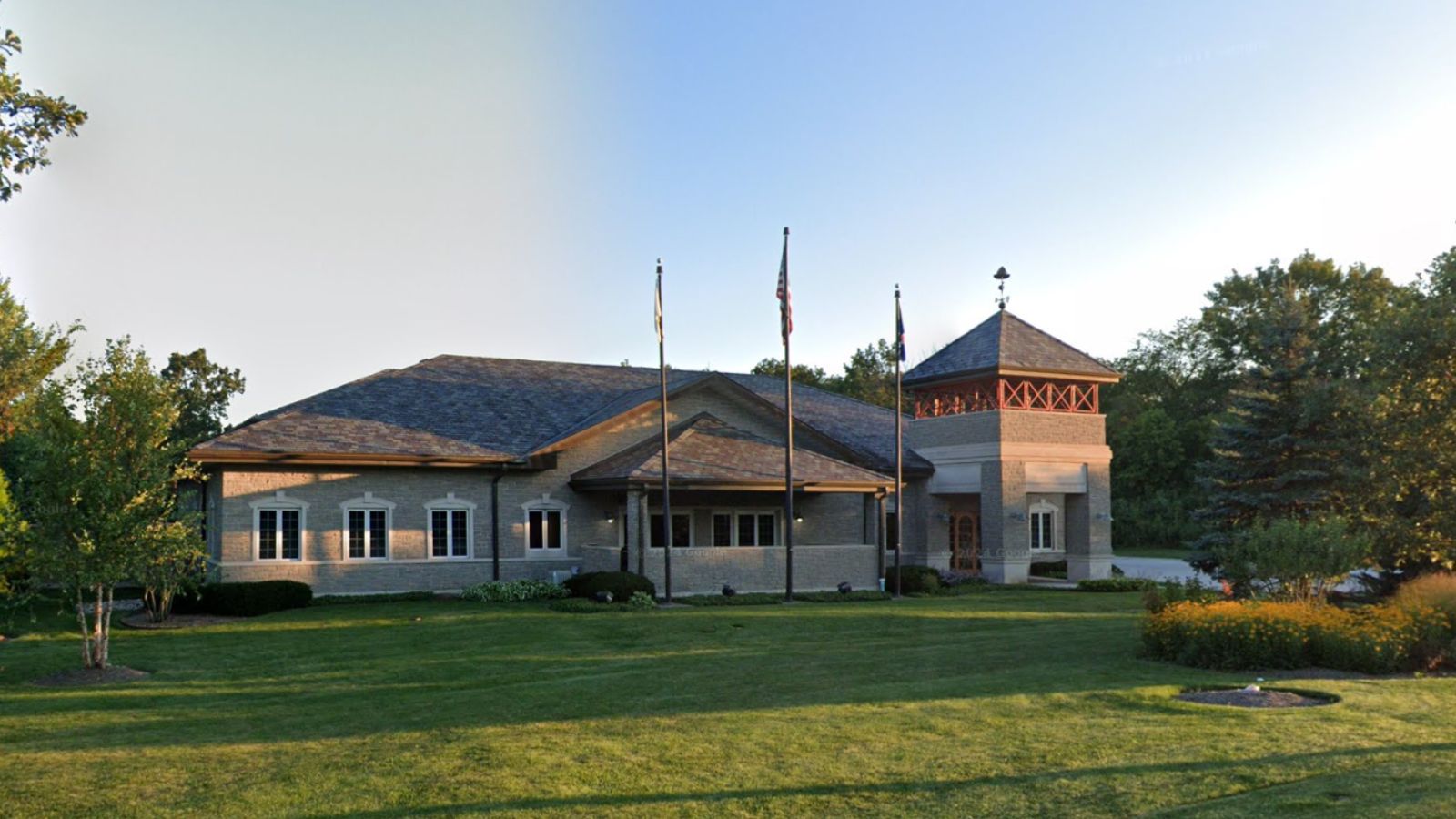
Why are people willing to pay so much to live here? What’s special about it?
Bannockburn attracts ultra-affluent buyers seeking luxury estates in a heavily wooded environment with maximum privacy and natural beauty. The village features custom-built homes on large lots with mature forests that provide seclusion while maintaining convenient access to Chicago and North Shore amenities. Residents value the exclusive character, environmental preservation, and recreational opportunities including golf courses and forest preserves.
The community’s strict development standards protect natural features while supporting luxury home construction with architectural variety and quality. Many properties include premium amenities and custom design elements that cater to the most discerning buyers. This combination of natural beauty, exclusivity, and convenience supports sustained property value appreciation among ultra-high-net-worth purchasers seeking ultimate suburban luxury.
How Bannockburn Rose to Prominence
Bannockburn incorporated in 1929 as affluent Chicago residents sought estate-style living in Lake County’s heavily forested areas. Early development emphasized environmental preservation and large-lot zoning that attracted wealthy families seeking privacy and natural amenities with reasonable access to the city. The village established strict architectural and environmental standards from inception.
Strategic location between Lake Michigan and major transportation corridors provided convenient access while maintaining forest character through careful development controls. The community’s emphasis on environmental preservation and architectural quality established its reputation for exclusive suburban living. Modern Bannockburn represents successful luxury development that maintains natural character while supporting ultra-high-end residential construction.
3 Interesting Tidbits
1. Forest Sanctuary – Bannockburn maintains over 70% forest coverage through strict preservation ordinances, creating one of the most heavily wooded communities in the Chicago metropolitan area.
2. Golf Legacy – Bannockburn Golf Club, designed by Donald Ross in 1924, provides exclusive recreational amenities and has hosted numerous amateur championships.
3. Wildlife Haven – The village’s extensive forest preservation supports diverse wildlife populations including deer, foxes, and over 100 bird species, creating natural suburban environment.
4. Golf – 58% Home Price Increase Since 2010
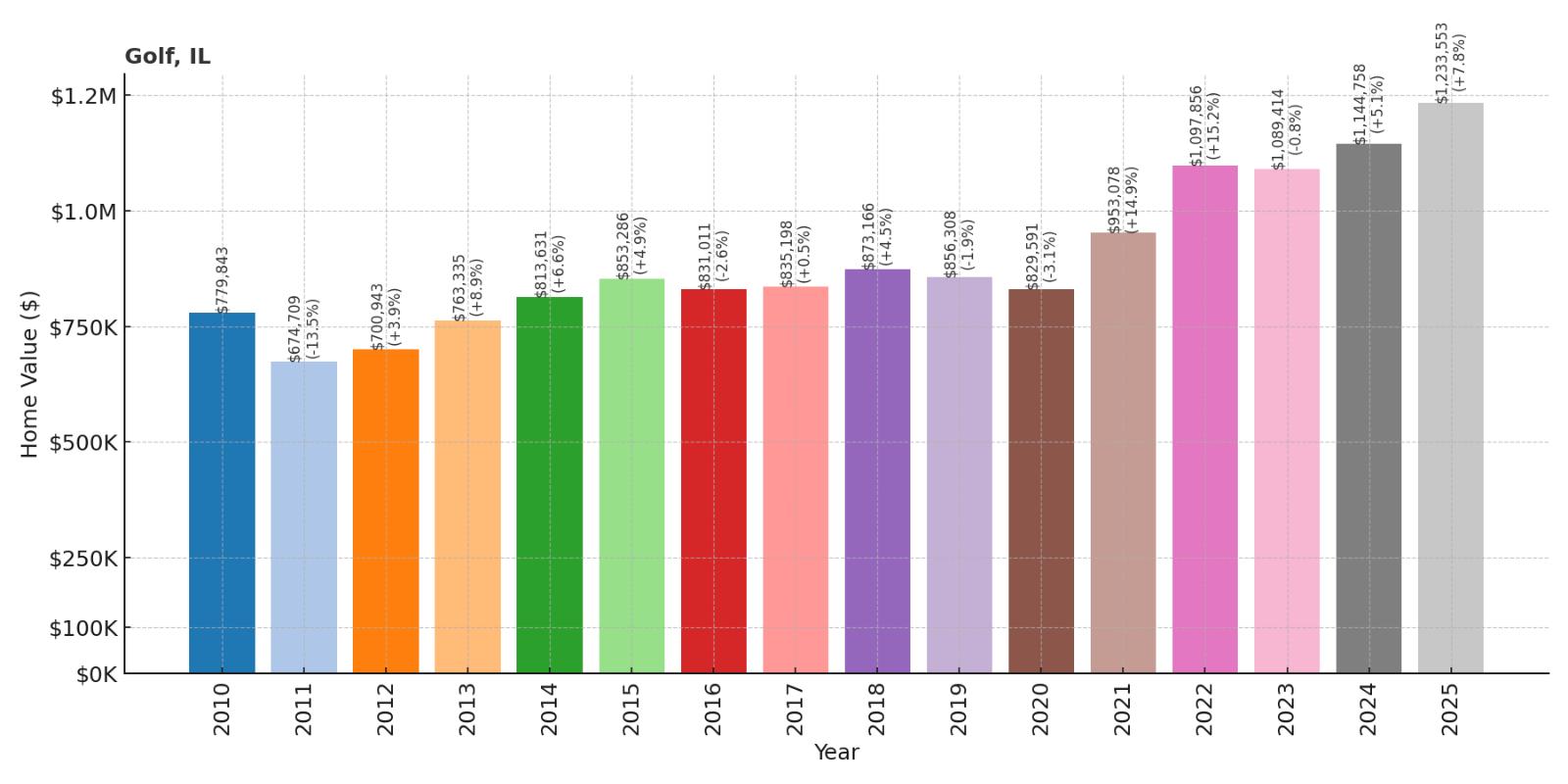
- 2010: $779,843
- 2011: $674,709
- 2012: $700,943
- 2013: $763,335
- 2014: $813,631
- 2015: $853,286
- 2016: $831,011
- 2017: $835,198
- 2018: $873,166
- 2019: $856,308
- 2020: $829,591
- 2021: $953,078
- 2022: $1,097,856
- 2023: $1,089,414
- 2024: $1,144,758
- 2025: $1,233,553
Golf showed strong recovery from 2011 lows, reaching peaks around 2018 before typical softening through 2020. Recent appreciation has been dramatic, with 49% growth since pandemic lows bringing current values to $1,233,553. This exceptional performance reflects intense demand for ultra-exclusive suburban properties with comprehensive recreational amenities and prime North Shore location.
Why Golf?
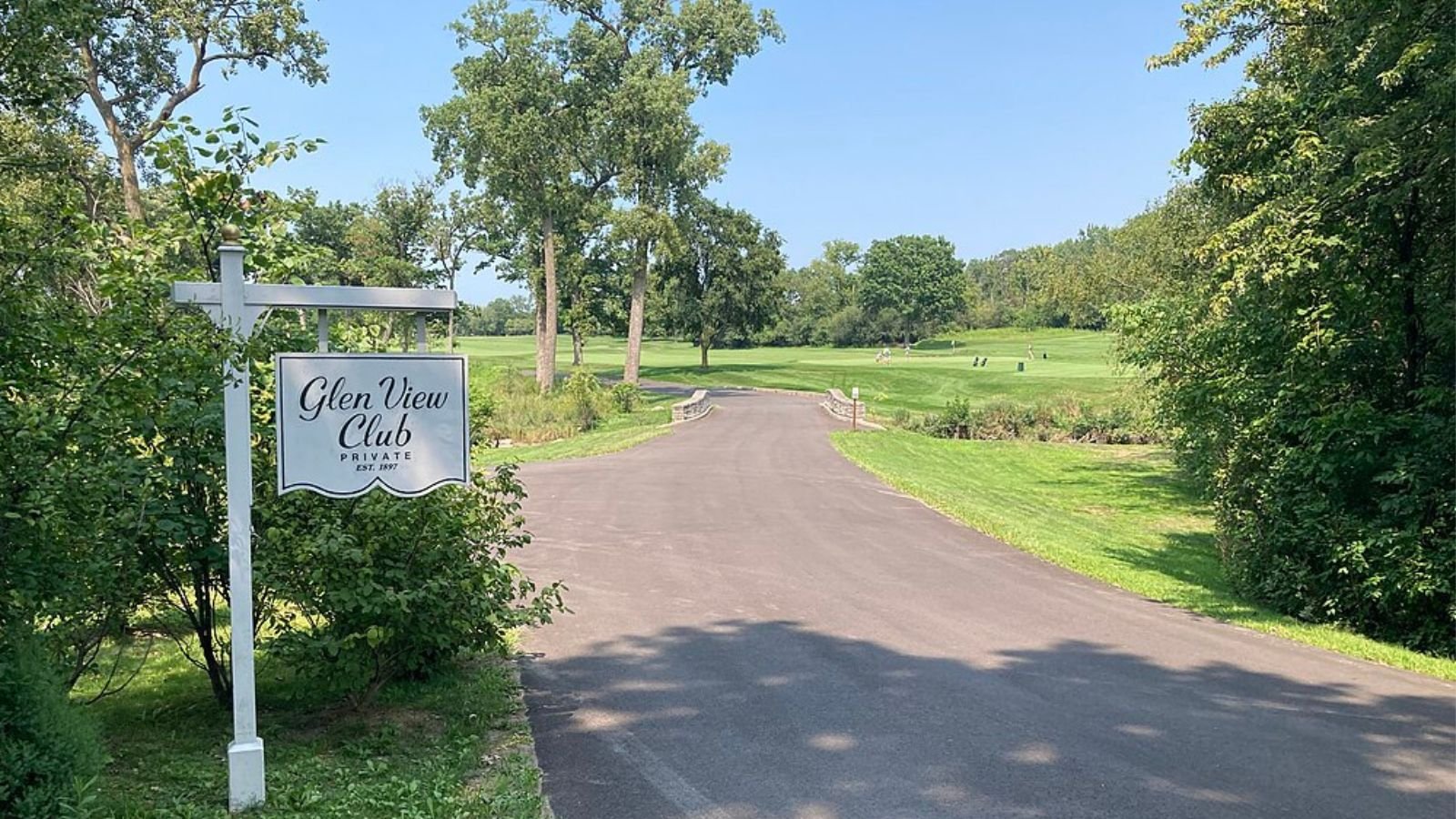
Why are people willing to pay so much to live here? What’s special about it?
Golf attracts ultra-affluent buyers seeking luxury estates in one of the most exclusive communities in the Chicago area. The village features custom-built homes on large lots with golf course access, equestrian facilities, and forest preserve adjacency that creates resort-style living. Residents value the ultimate privacy, recreational amenities, and convenient access to Chicago while enjoying country club atmosphere and natural beauty.
The community’s extremely limited housing stock and strict development standards ensure continued exclusivity while supporting luxury home construction with premium finishes and architectural variety. Access to private recreational facilities and natural areas creates lifestyle amenities that justify ultra-luxury pricing. This combination of scarcity, recreation, and convenience supports sustained property value appreciation among the most affluent suburban buyers.
How Golf Rose to Prominence
Golf incorporated in 1928 as a planned community designed around recreational amenities, particularly golf courses and equestrian facilities that attracted Chicago’s business elite seeking country estate living. Early development emphasized large lots and recreational facilities that established the community’s exclusive character and appeal to affluent residents.
Strategic location in Cook County provided convenient access to Chicago while maintaining rural character through careful zoning and development controls. The community’s emphasis on recreational amenities and architectural quality attracted ultra-affluent households seeking comprehensive luxury suburban living. Modern Golf represents successful luxury community development that integrates residential excellence with resort-style recreational amenities.
3 Interesting Tidbits
1. Name Origins – The village was literally named for its golf courses, reflecting the central role of recreational amenities in the community’s identity and development from inception.
2. Ultra-Exclusive – With fewer than 500 residents, Golf maintains one of the smallest populations among incorporated municipalities in the Chicago area, ensuring maximum exclusivity.
3. Recreational Paradise – The community features multiple golf courses, riding trails, and private recreational facilities that create resort-style living within the suburban environment.
3. Glencoe – 52% Home Price Increase Since 2010
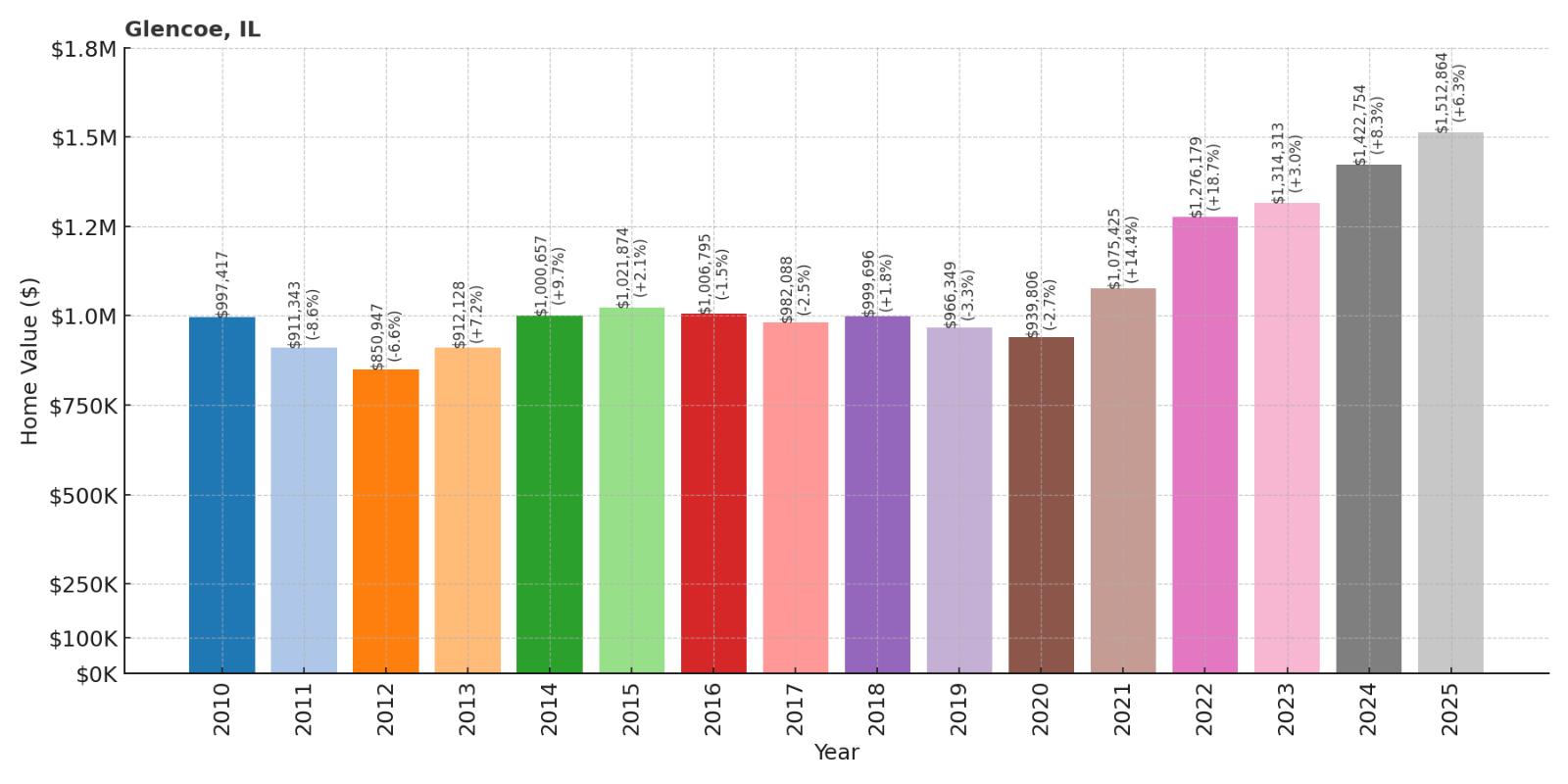
- 2010: $997,417
- 2011: $911,343
- 2012: $850,947
- 2013: $912,128
- 2014: $1,000,657
- 2015: $1,021,874
- 2016: $1,006,795
- 2017: $982,088
- 2018: $999,696
- 2019: $966,349
- 2020: $939,806
- 2021: $1,075,425
- 2022: $1,276,179
- 2023: $1,314,313
- 2024: $1,422,754
- 2025: $1,512,864
Glencoe began from an exceptionally high base near $1 million in 2010, maintaining values above $850,000 even during challenging periods. Recent appreciation has been extraordinary, with 61% growth since 2020 bringing current values to $1,512,864. This exceptional performance demonstrates the elite appeal of premier North Shore lakefront communities among ultra-affluent buyers.
Why Glencoe?
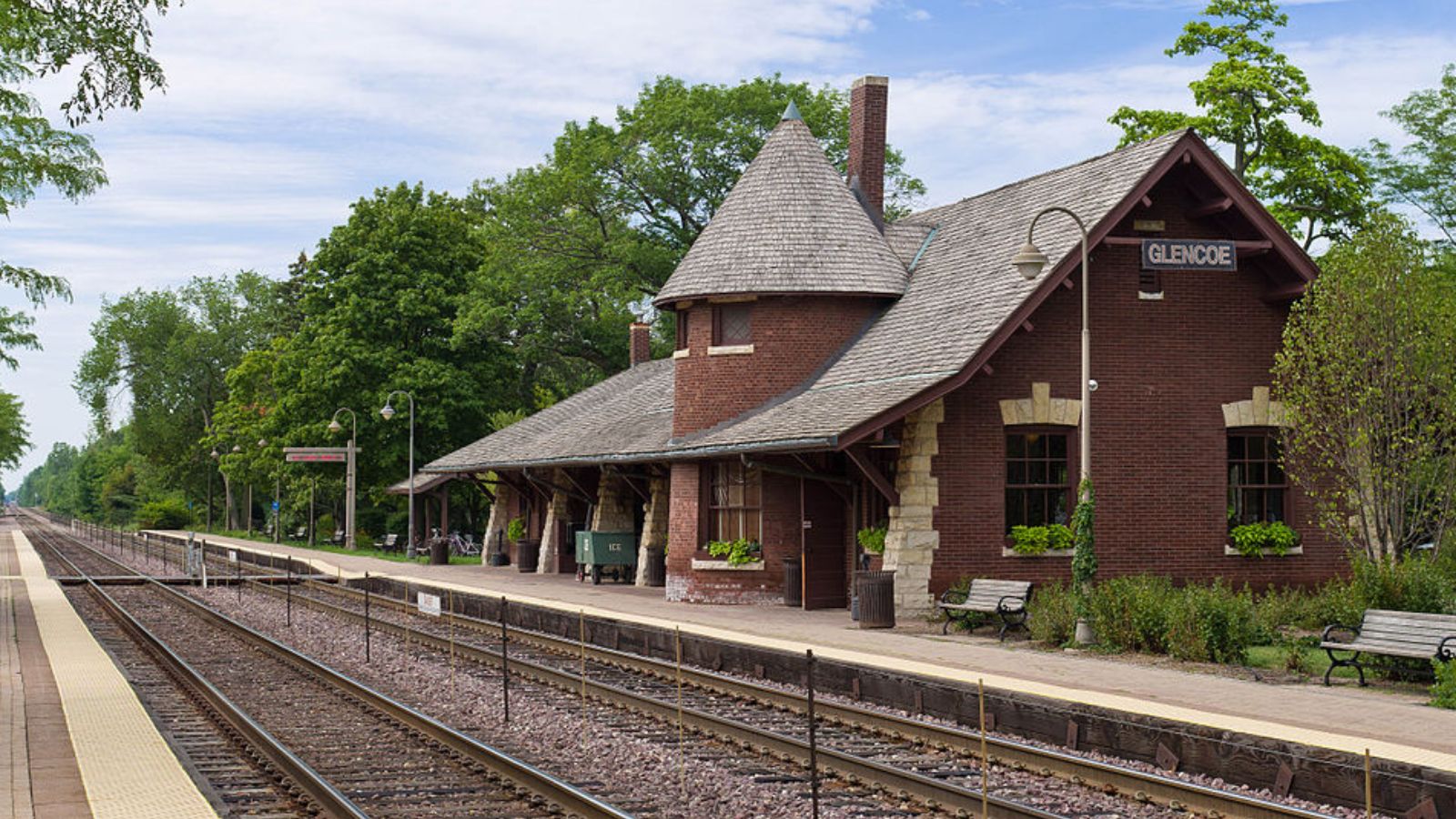
Why are people willing to pay so much to live here? What’s special about it?
Glencoe attracts ultra-affluent buyers seeking the ultimate North Shore lifestyle with direct Lake Michigan access, historic estates, and cultural sophistication. The village offers magnificent lakefront properties, proximity to the Chicago Botanic Garden, and access to world-class cultural amenities including the nearby Ravinia Festival. Residents value the combination of natural beauty, architectural significance, and exclusive community character that defines elite suburban living.
The community’s lakefront location provides beaches, parks, and recreational opportunities that enhance quality of life beyond typical suburban offerings. Historic neighborhoods feature exceptional architecture and mature landscaping that creates unique appeal. This combination of location, heritage, and exclusivity supports sustained property value appreciation among the most discerning buyers seeking prestigious North Shore addresses.
How Glencoe Rose to Prominence
Glencoe was established in 1869 when Chicago businessmen purchased lakefront property to create an exclusive summer retreat community. Early development emphasized architectural quality and environmental preservation that established the village’s prestigious character. The arrival of railroad service made year-round commuting practical, transforming summer cottages into permanent luxury residences.
The community’s proximity to Lake Michigan and commitment to preserving natural beauty attracted Chicago’s most affluent families, who built magnificent estates that remain architectural landmarks today. Strategic planning maintained exclusive character while accommodating growth. Modern Glencoe represents the pinnacle of North Shore suburban development, combining historic preservation with contemporary luxury living.
3 Interesting Tidbits
1. Botanic Garden – The Chicago Botanic Garden, located partially within Glencoe, provides world-class horticultural displays and educational programs that enhance community cultural amenities.
2. Beach Paradise – Glencoe Beach offers residents private Lake Michigan access with swimming, sailing, and recreational facilities typically unavailable in suburban communities.
3. Historic Estates – The village contains numerous historic lakefront estates designed by prominent architects, creating one of the finest collections of residential architecture in the Midwest.
2. Winnetka – 38% Home Price Increase Since 2010
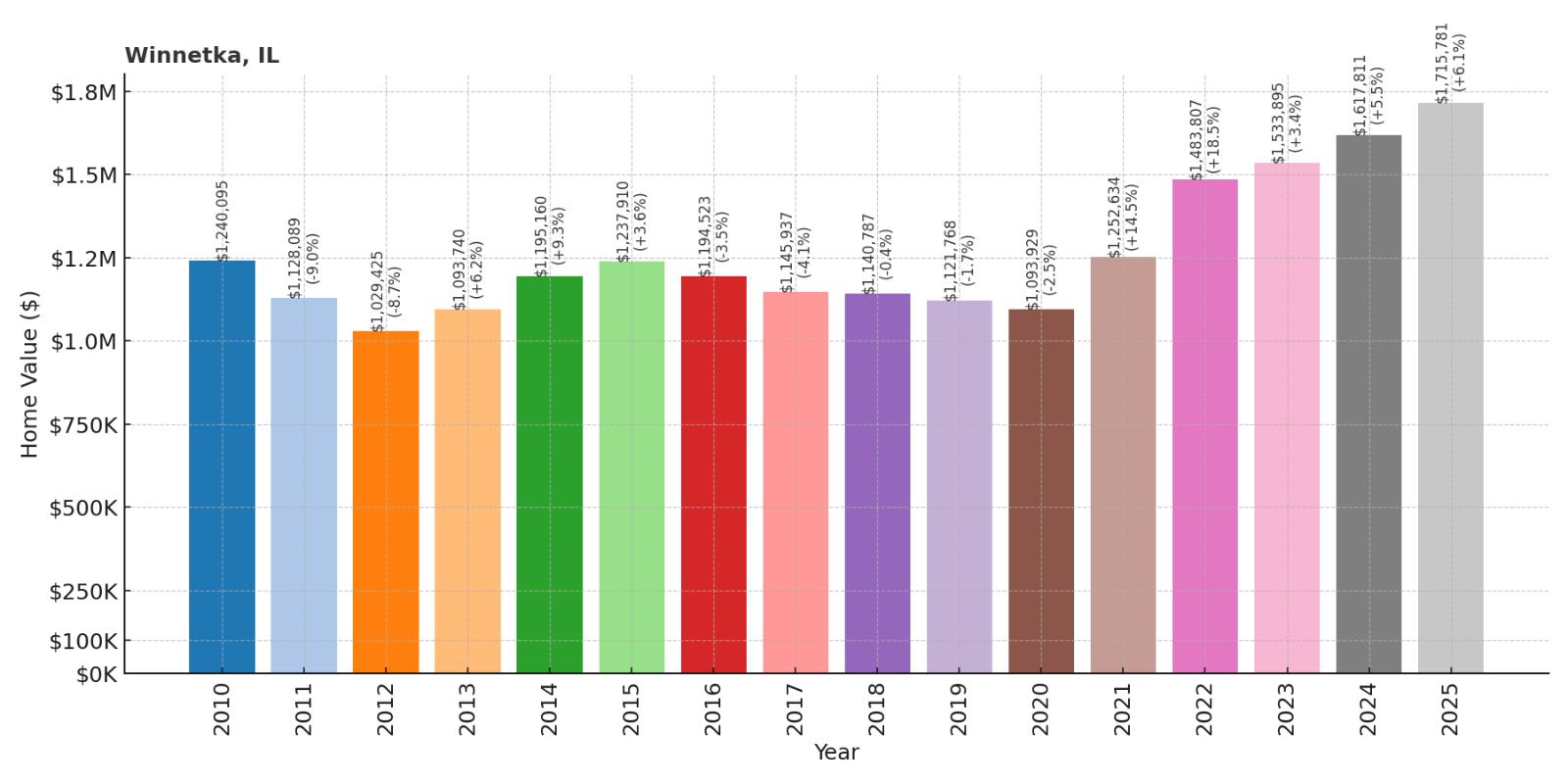
- 2010: $1,240,095
- 2011: $1,128,089
- 2012: $1,029,425
- 2013: $1,093,740
- 2014: $1,195,160
- 2015: $1,237,910
- 2016: $1,194,523
- 2017: $1,145,937
- 2018: $1,140,787
- 2019: $1,121,768
- 2020: $1,093,929
- 2021: $1,252,634
- 2022: $1,483,807
- 2023: $1,533,895
- 2024: $1,617,811
- 2025: $1,715,781
Winnetka started from the second-highest base above $1.2 million, showing resilience through market downturns with values never falling below $1 million. Recent appreciation has been exceptional, with 57% growth since 2020 bringing current values to $1,715,781. This performance reflects the ultimate prestige and desirability of premier North Shore lakefront communities among America’s most affluent buyers.
Why Winnetka?
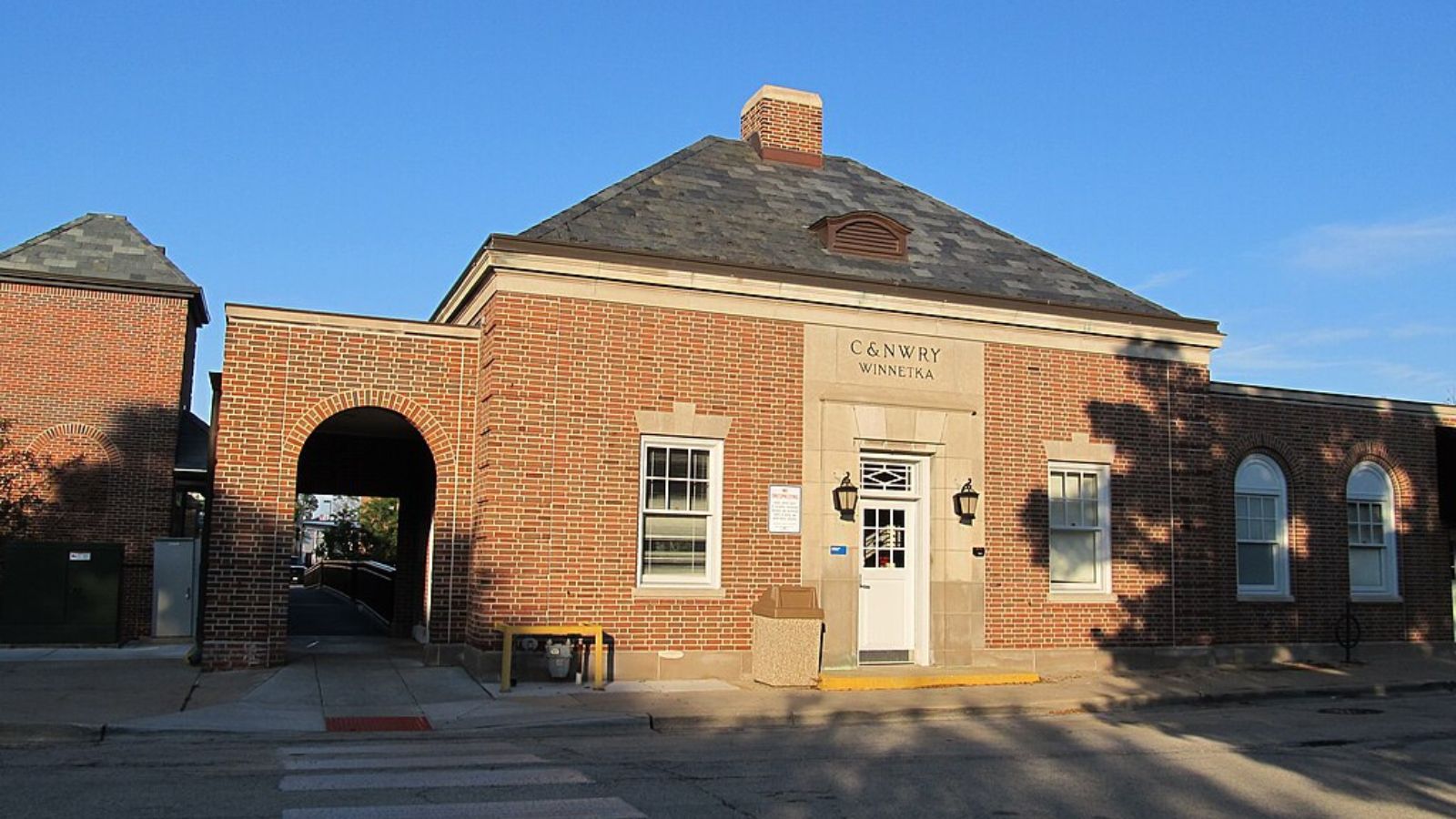
Why are people willing to pay so much to live here? What’s special about it?
Winnetka represents the pinnacle of North Shore luxury living with magnificent lakefront estates, world-class amenities, and unparalleled community prestige. The village offers direct Lake Michigan access through private beaches, proximity to exceptional schools including New Trier High School, and walkable downtown districts with upscale shopping and dining. Residents enjoy the ultimate combination of natural beauty, architectural heritage, and social status that defines America’s most exclusive suburban communities.
The community’s lakefront location provides private beaches, sailing facilities, and recreational opportunities that enhance luxury living beyond typical suburban offerings. Historic neighborhoods feature exceptional estates and mature landscaping that create unique appeal among ultra-affluent buyers. This combination of location, prestige, and amenities supports sustained property value appreciation at the highest levels of the luxury market.
How Winnetka Rose to Prominence
Winnetka was founded in 1854 when Chicago merchants purchased lakefront property to create summer residences away from the city’s industrial environment. Early development emphasized architectural excellence and environmental preservation that established the community’s prestigious character. The arrival of railroad service in the 1870s made year-round commuting practical, transforming seasonal retreats into permanent luxury residences.
The community’s commitment to excellence in education, architecture, and environmental quality attracted America’s most successful business leaders, who built magnificent estates that remain among the country’s finest residential architecture. Strategic planning preserved lakefront access while maintaining exclusive residential character. Modern Winnetka represents the ultimate achievement in American suburban development, combining historic preservation with contemporary luxury living.
3 Interesting Tidbits
1. Educational Excellence – New Trier High School, serving Winnetka and surrounding communities, consistently ranks as one of America’s top public high schools and has produced numerous notable alumni.
2. Architectural Legacy – Winnetka contains exceptional examples of residential architecture by prominent designers including David Adler, creating one of America’s finest collections of luxury homes.
3. Home Alone Fame – The village gained international recognition as the filming location for the movie “Home Alone,” showcasing its beautiful neighborhoods and family-friendly character to global audiences.
1. Kenilworth – 35% Home Price Increase Since 2010
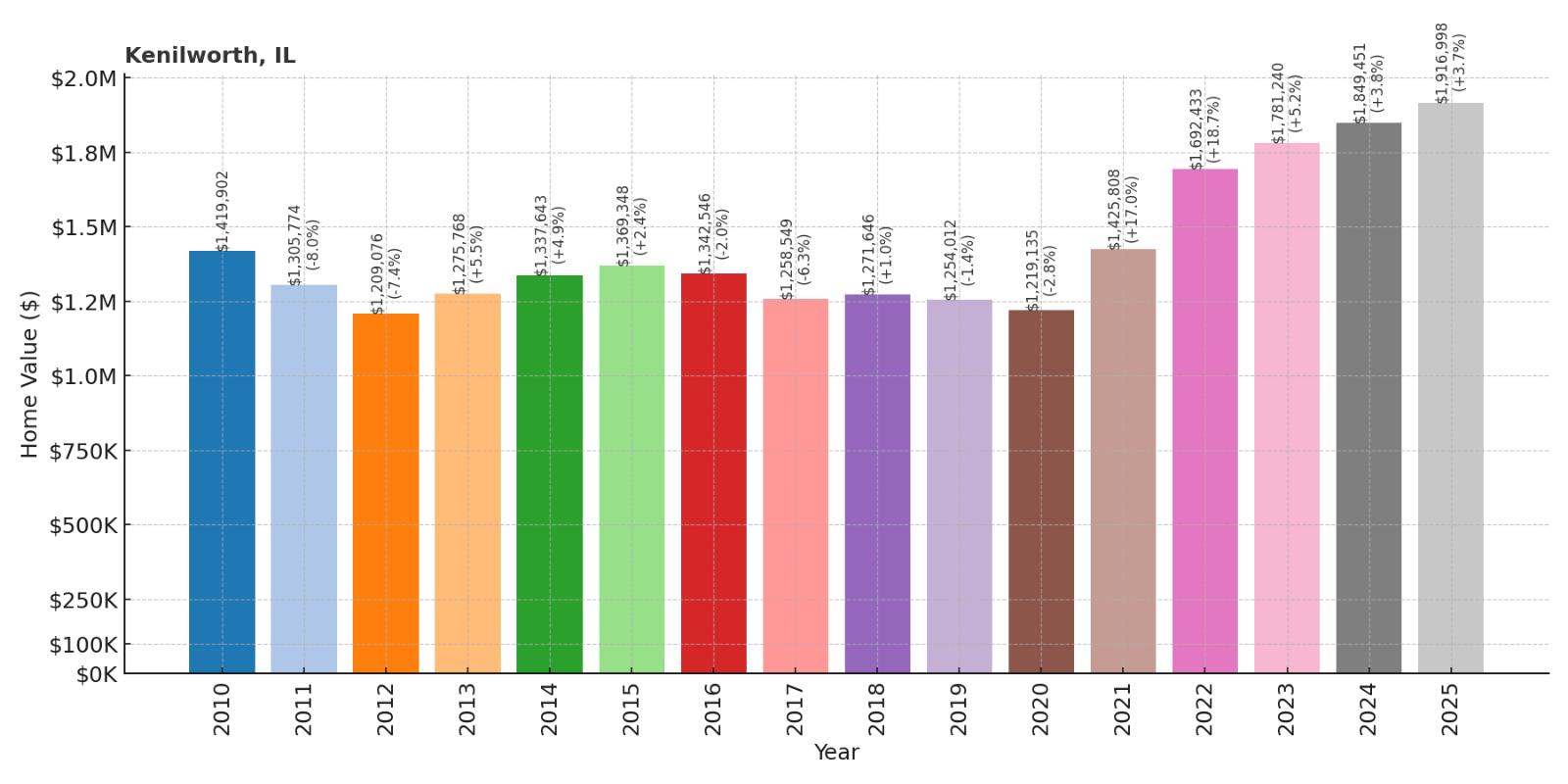
- 2010: $1,419,902
- 2011: $1,305,774
- 2012: $1,209,076
- 2013: $1,275,768
- 2014: $1,337,643
- 2015: $1,369,348
- 2016: $1,342,546
- 2017: $1,258,549
- 2018: $1,271,646
- 2019: $1,254,012
- 2020: $1,219,135
- 2021: $1,425,808
- 2022: $1,692,433
- 2023: $1,781,240
- 2024: $1,849,451
- 2025: $1,916,998
Kenilworth began from the highest base above $1.4 million, maintaining exceptional values even during challenging periods with prices never falling below $1.2 million. Recent appreciation has been remarkable, with 57% growth since 2020 bringing current values to $1,916,998. This extraordinary performance establishes Kenilworth as Illinois’ most expensive community and demonstrates ultimate prestige among America’s most exclusive residential addresses.
Why Kenilworth?

Why are people willing to pay so much to live here? What’s special about it?
Kenilworth represents the absolute pinnacle of Illinois luxury living with magnificent lakefront estates, complete residential exclusivity, and unmatched community prestige. The village prohibits all commercial development, creating pure residential character that appeals to ultra-affluent buyers seeking ultimate privacy and exclusivity. Residents enjoy direct Lake Michigan access, exceptional architecture, and social status that defines America’s most prestigious suburban addresses.
The community’s tiny size and strict zoning create inherent scarcity that supports premium pricing while maintaining architectural excellence and environmental quality. Every property represents significant investment in luxury living with custom estates and mature landscaping. This combination of exclusivity, location, and prestige supports sustained property value appreciation at the highest levels of America’s luxury residential market.
How Kenilworth Rose to Prominence
Kenilworth was founded in 1889 as America’s first planned residential community, designed specifically for Chicago’s business elite seeking the ultimate suburban luxury experience. Developer Joseph Sears purchased lakefront property and hired landscape architect Nathan Barrett to create comprehensive community plan emphasizing architectural excellence and environmental preservation.
The community’s founding principles prohibited commercial development and established architectural standards that continue today, creating immediate exclusivity that attracted America’s wealthiest families. Strategic lakefront location and commitment to residential excellence established Kenilworth as the premier address for Chicago’s most successful business leaders. Modern Kenilworth maintains these founding principles while supporting contemporary luxury living that represents the pinnacle of American suburban achievement.
3 Interesting Tidbits
1. Pure Residential – Kenilworth is one of America’s few communities that prohibits all commercial development, creating complete residential exclusivity that enhances property values and community character.
2. Planning Pioneer – As America’s first comprehensively planned residential community, Kenilworth established design principles that influenced suburban development throughout the country.
3. Ultimate Exclusivity – With fewer than 2,500 residents in less than one square mile, Kenilworth maintains the highest population density of ultra-affluent households in the Chicago metropolitan area.





